The Andy Warhol for NARS collection is positively enormous! Here is part 2, the Silver Factory Holiday collection. (Click here for part 1 and to read about the background on the collaboration.)
The ad copy: "In a new makeup gifting collection for department and specialty stores, NARS
captures the spirit of Warhol’s Silver Factory. The edgy energy of the Screen
Tests, the intense color of the silkscreens, and the cool of Warhol’s superstars –underground icons and downtown divas who amazed audiences just by beingthemselves. For Andy the factory characters were like a full spectrum palette –
personality as color."
Let's start with the eyeshadow palettes, which feature variations on Warhol's Self-Portrait of 1967. Like the Flower palettes, each has with a unique quote inscribed on the mirror and a "Get the Look" card.
Self-Portrait Palette #1:
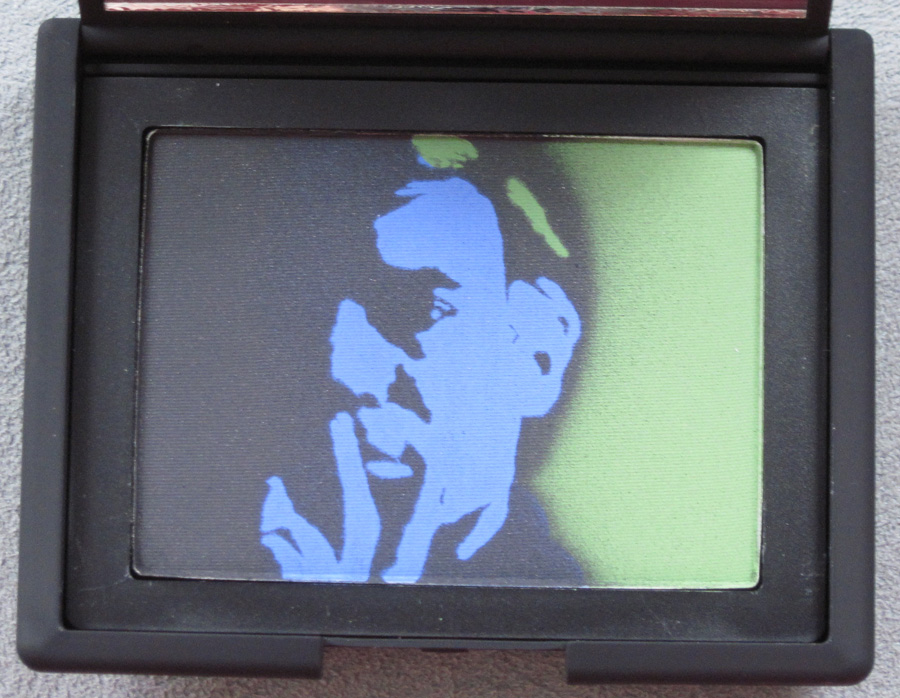
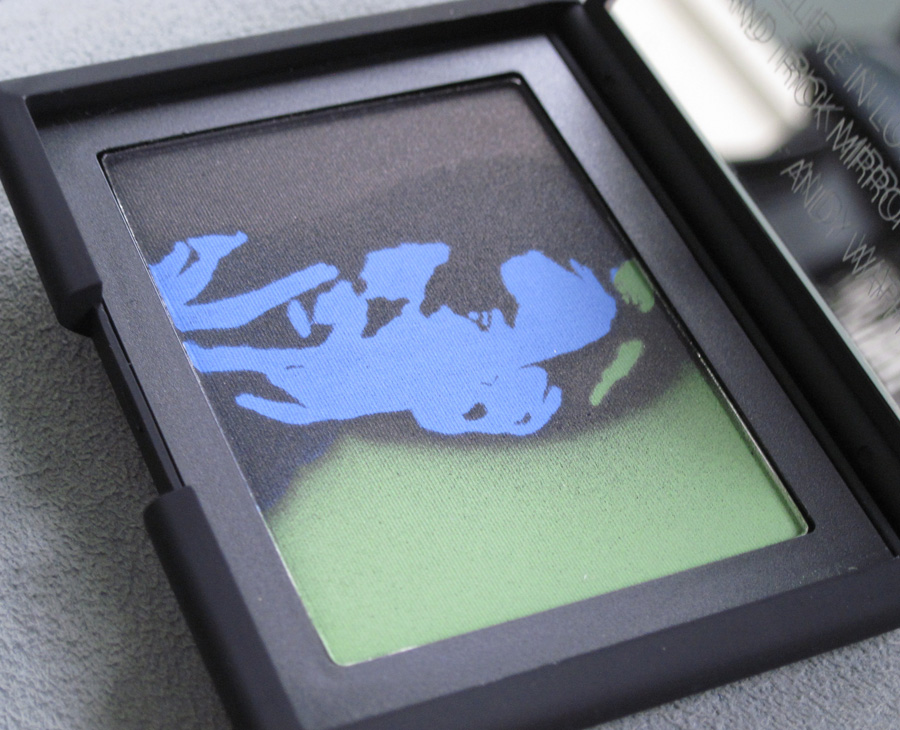
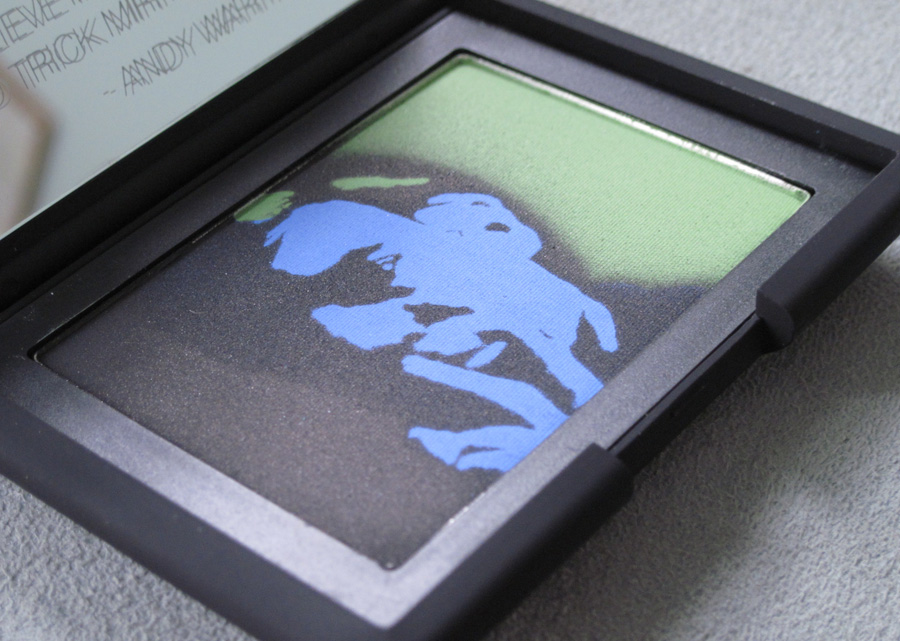
With flash:
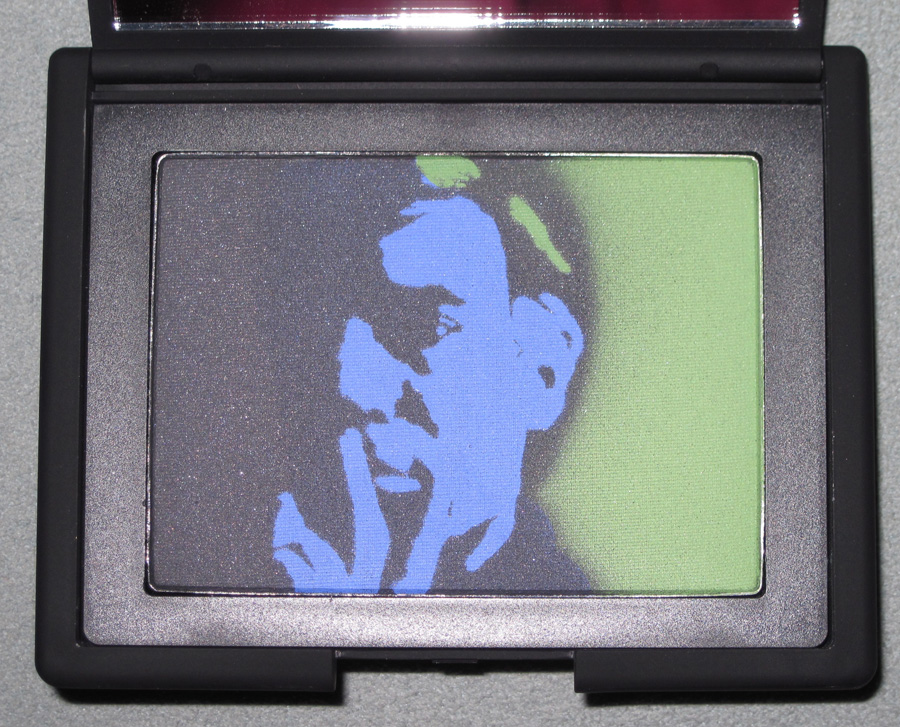
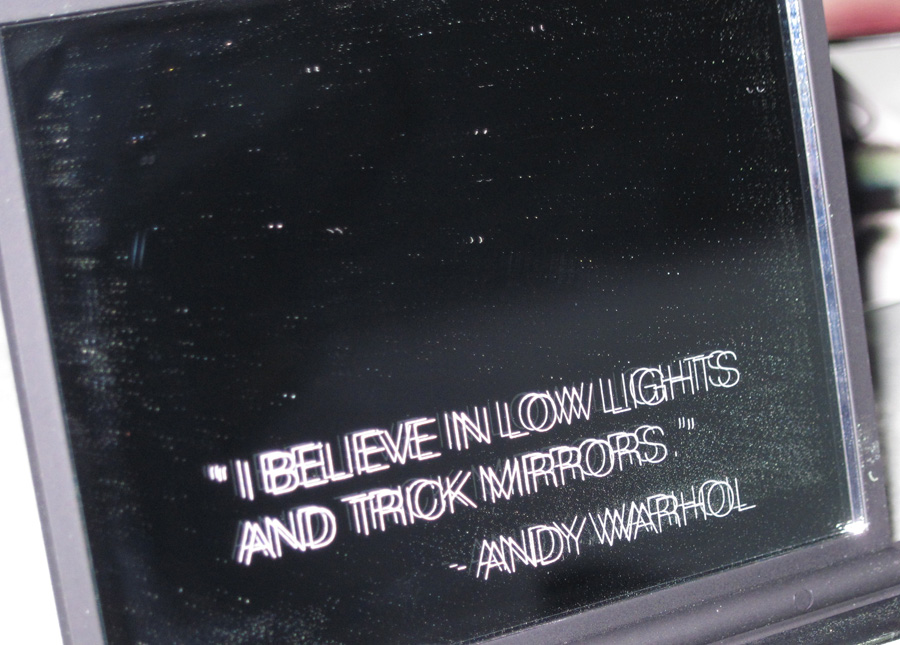
Get the Look card, which shows a close-up of Edie Sedgwick (the Flower palettes used Debbie Harry):
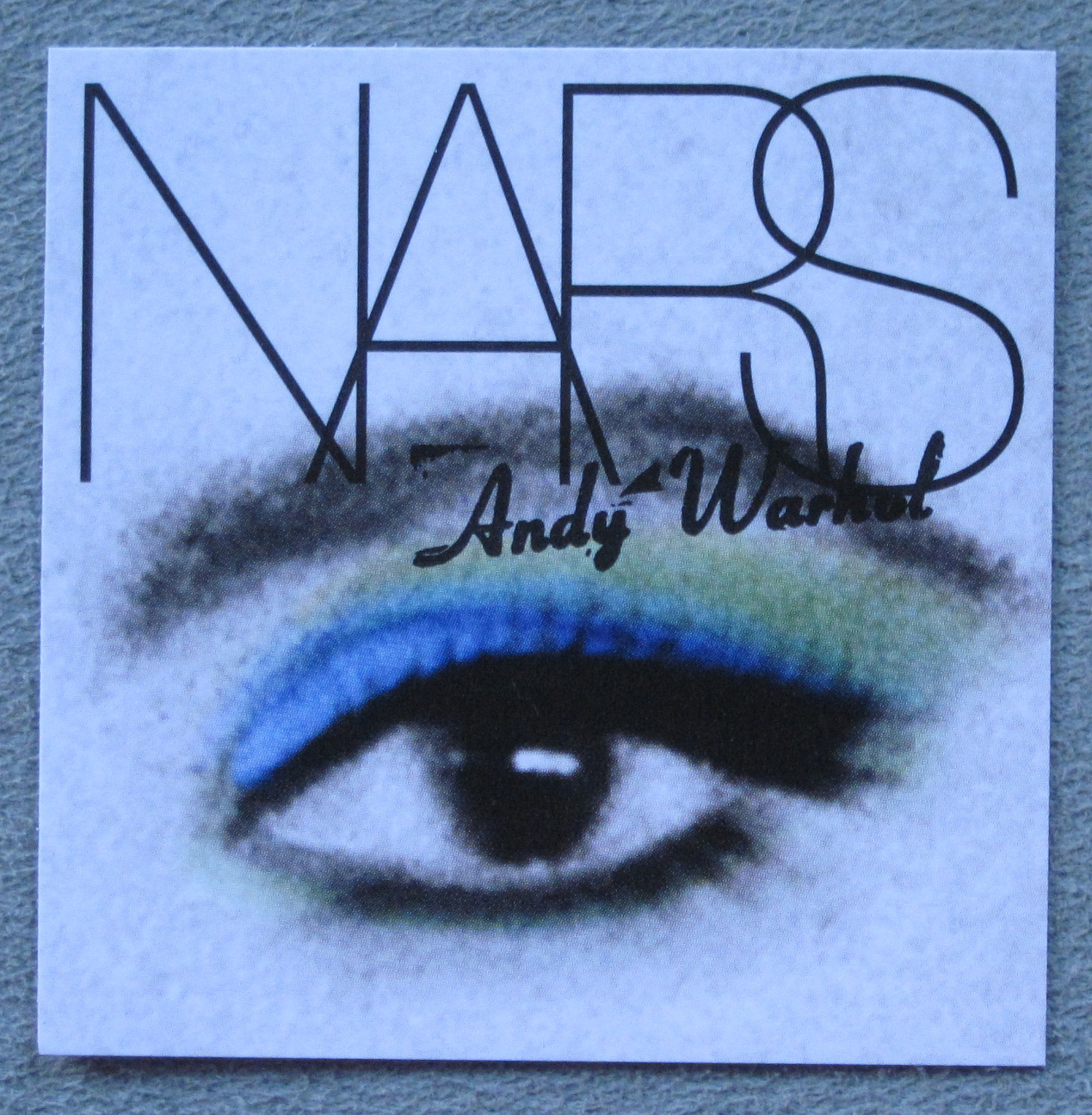
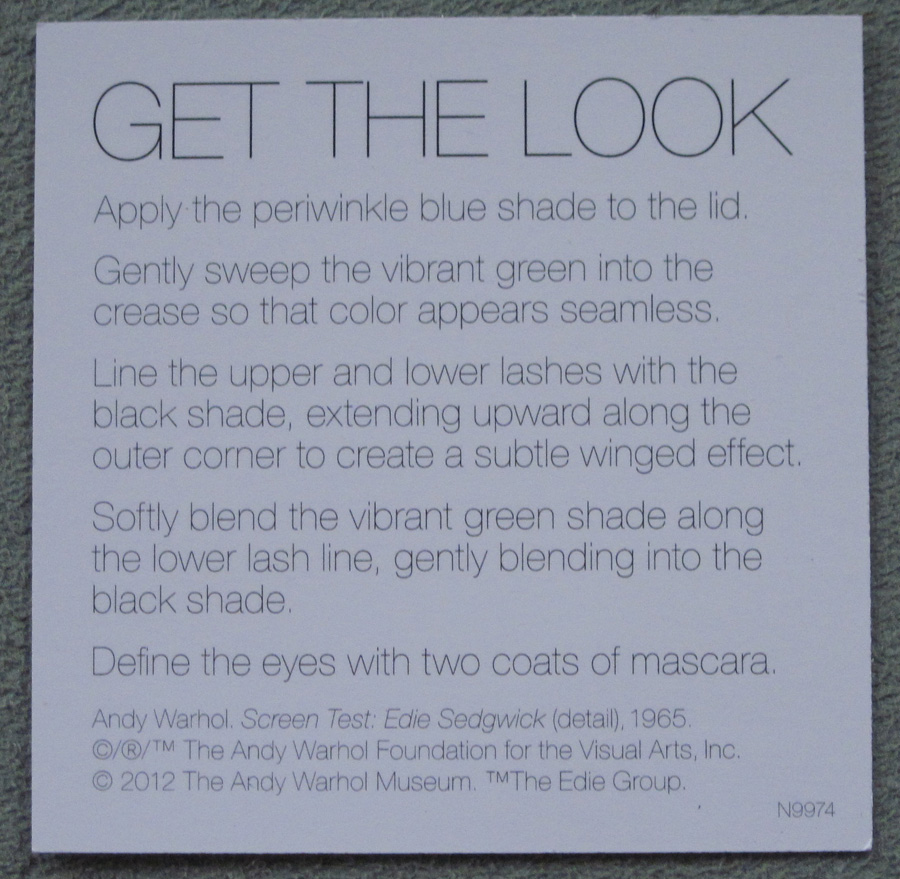
Self-Portrait Palette #2:
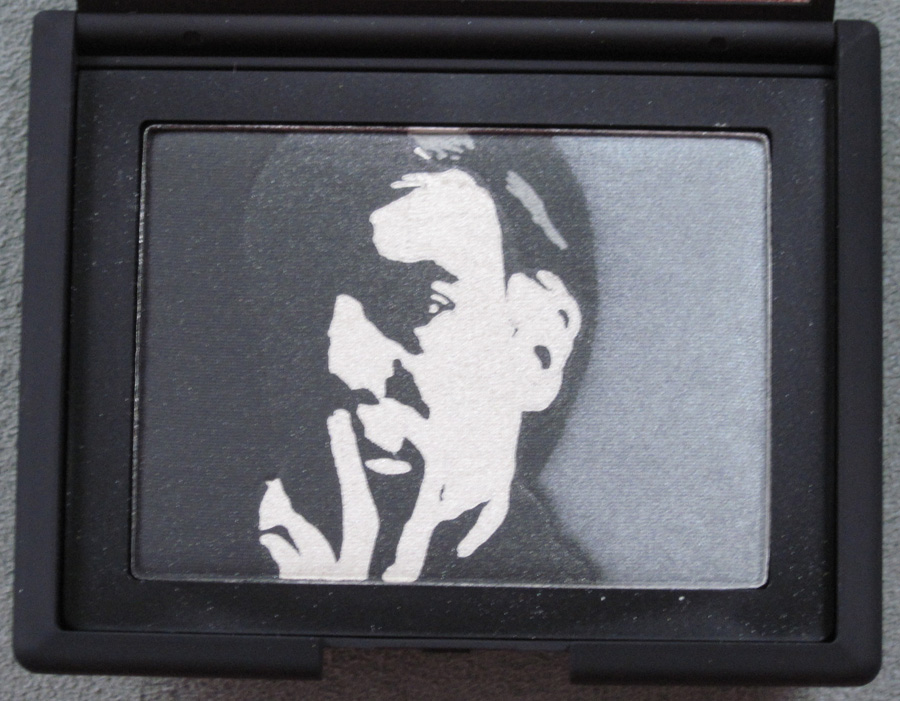
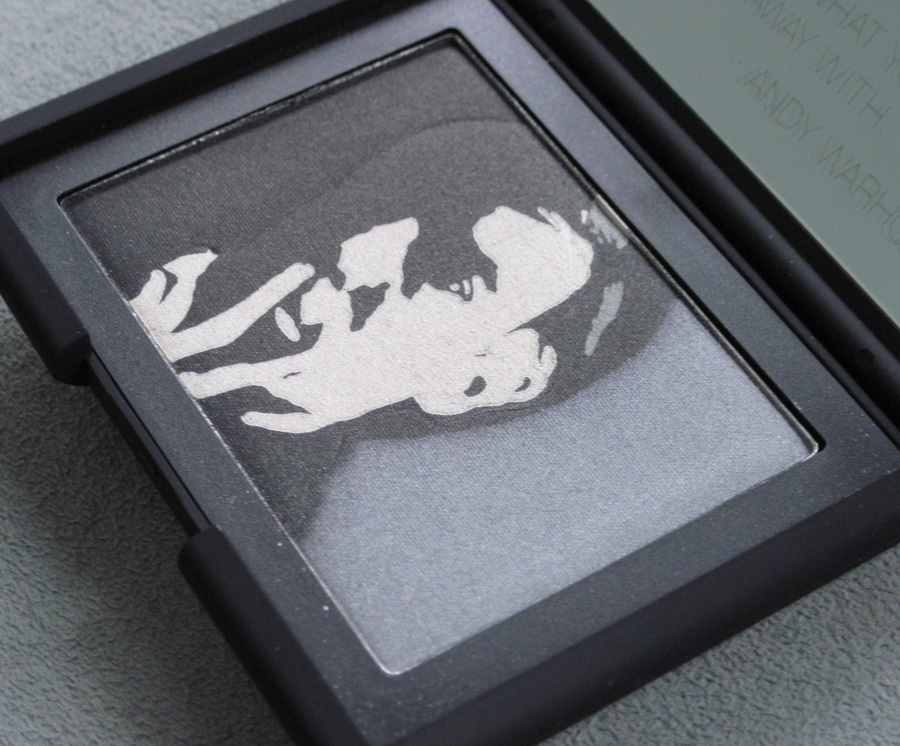
With flash:
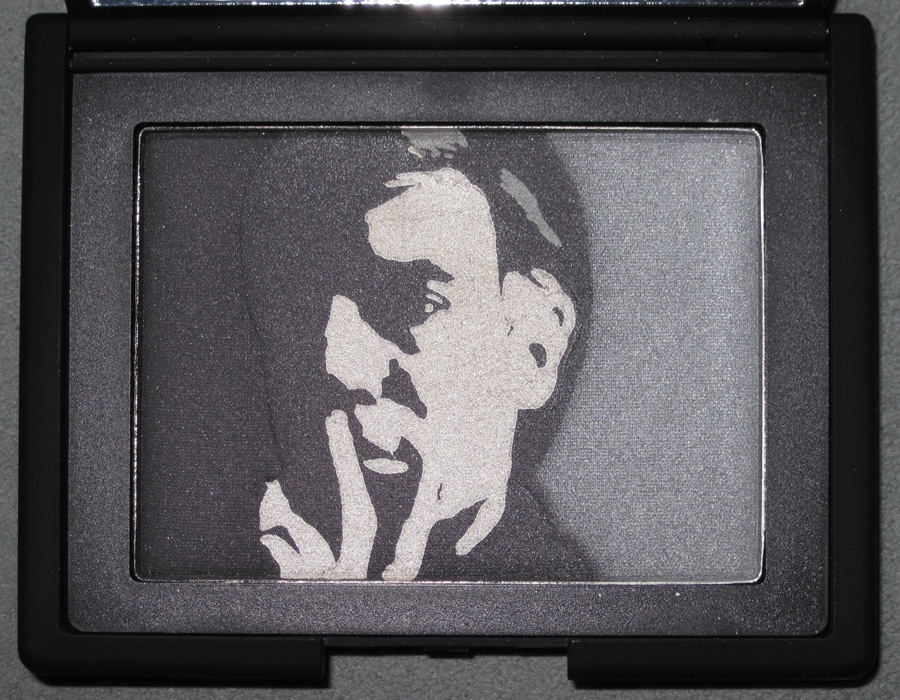
Get the Look card:
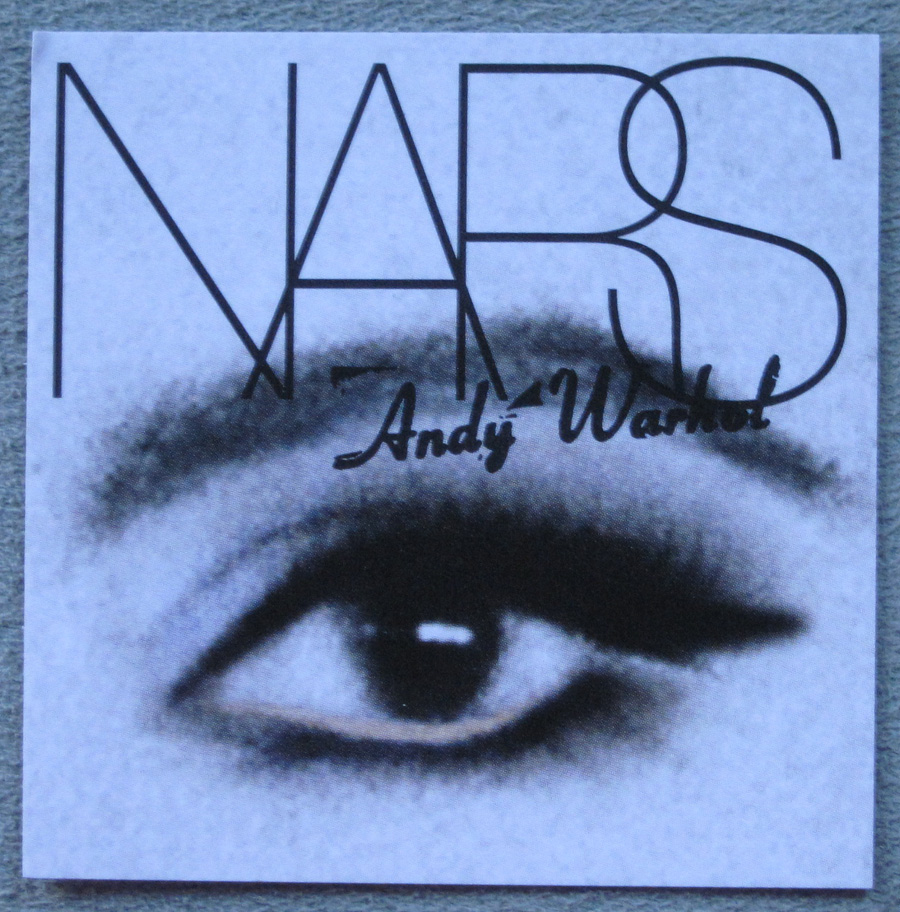
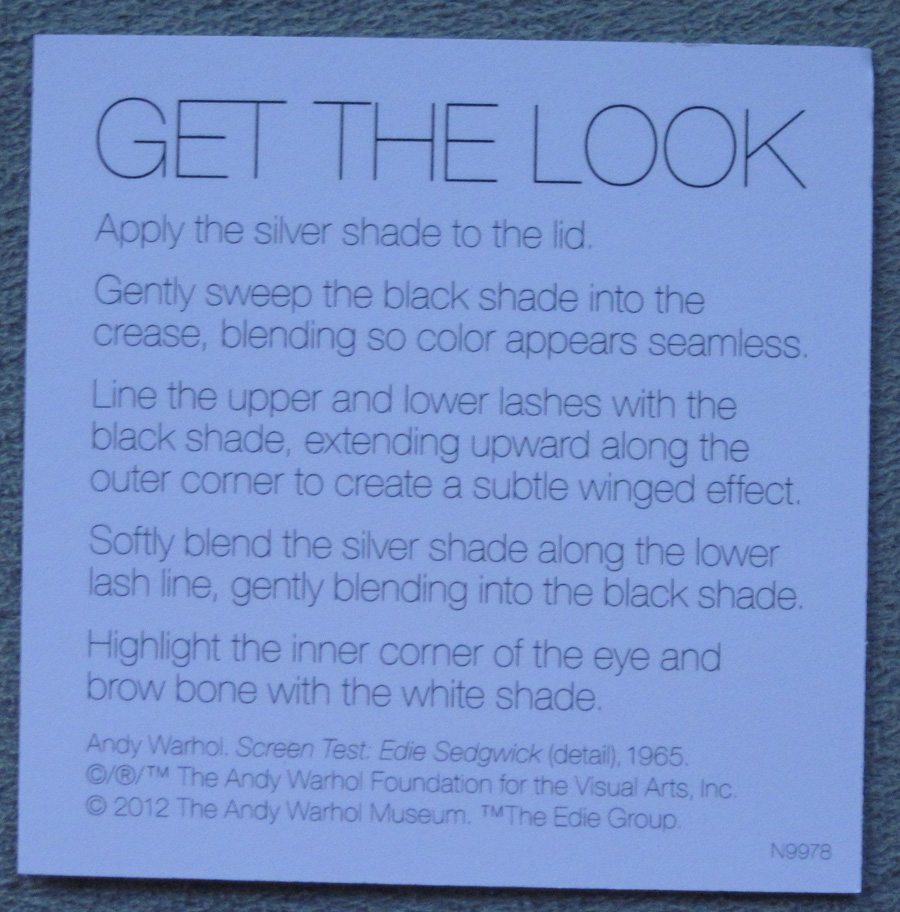
Self-Portrait #3:
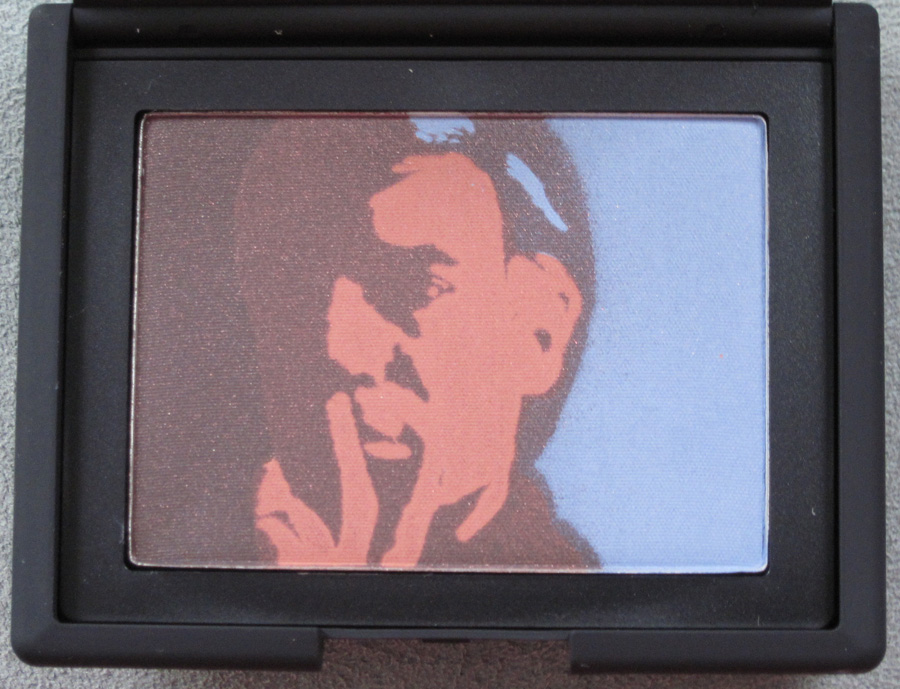
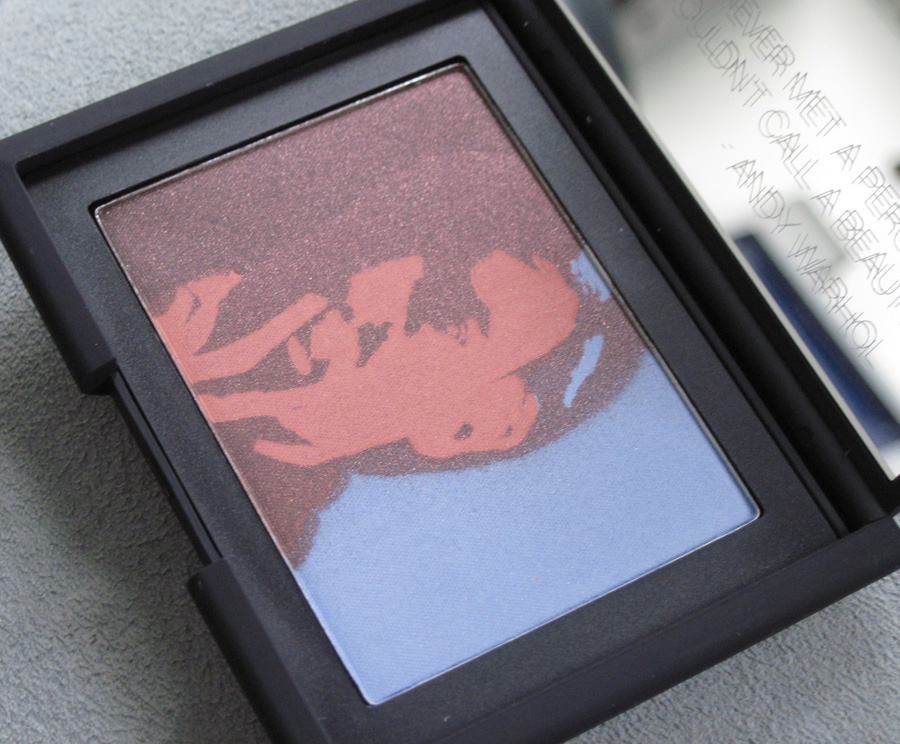
With flash:
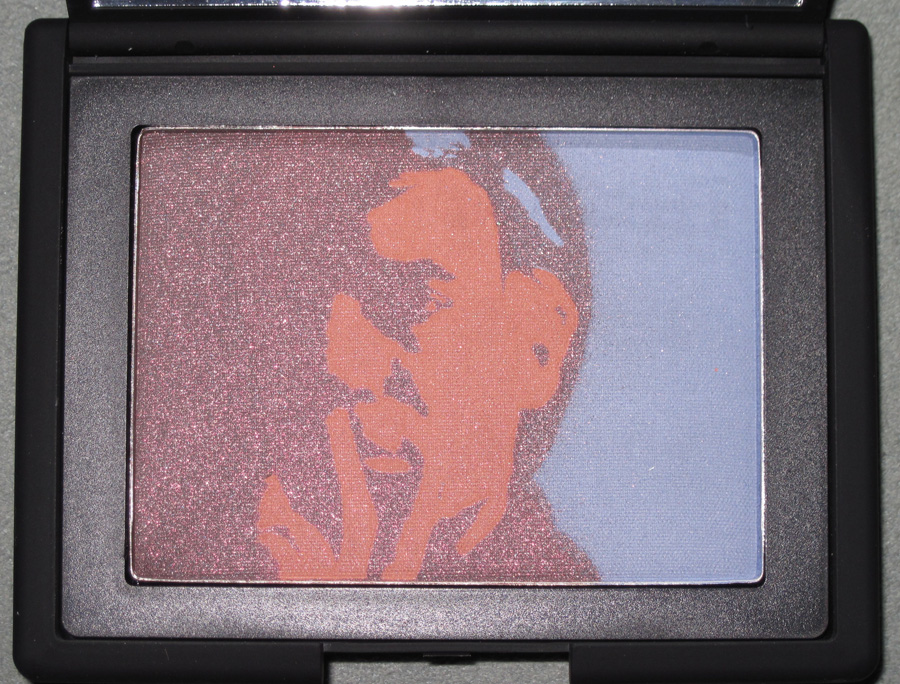
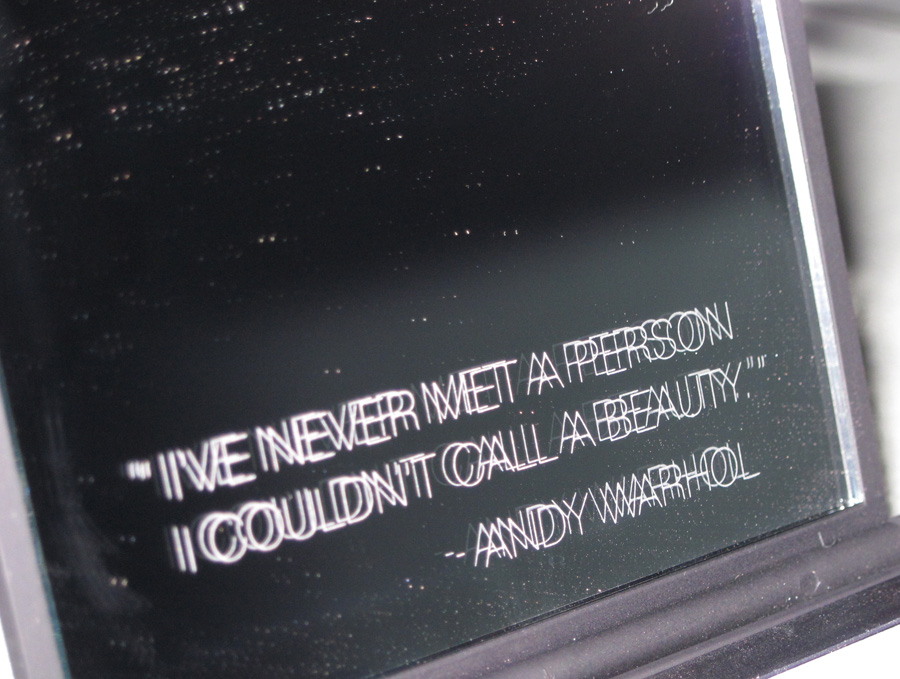
Get the Look:
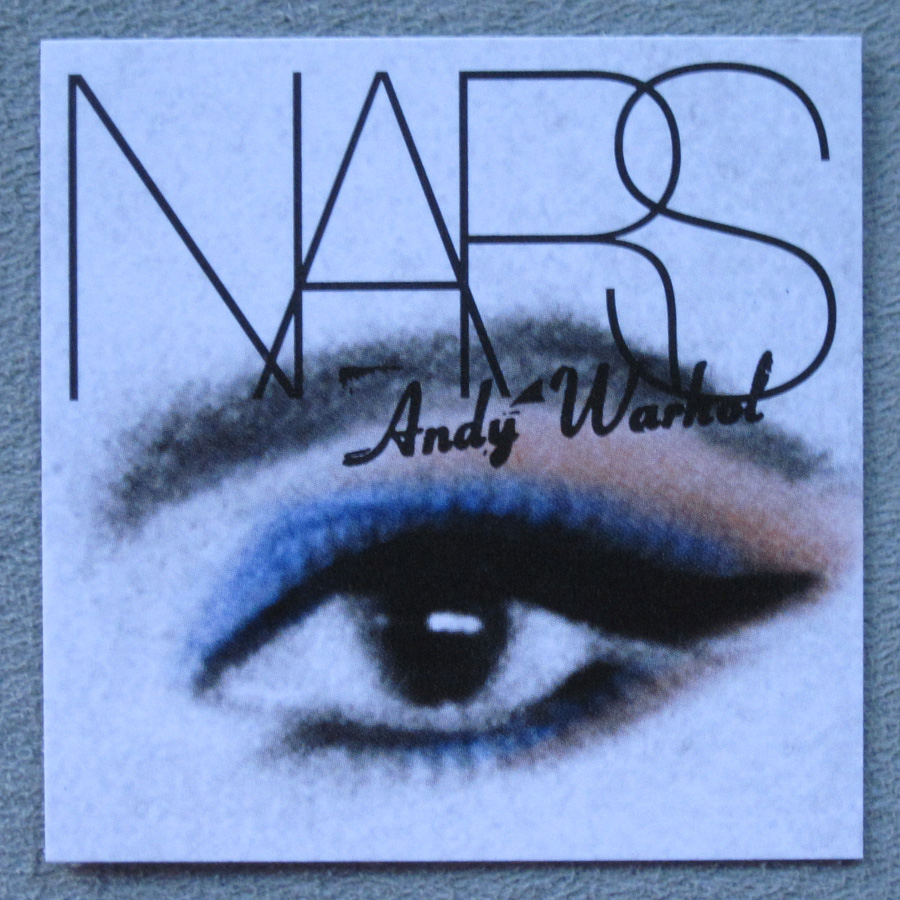
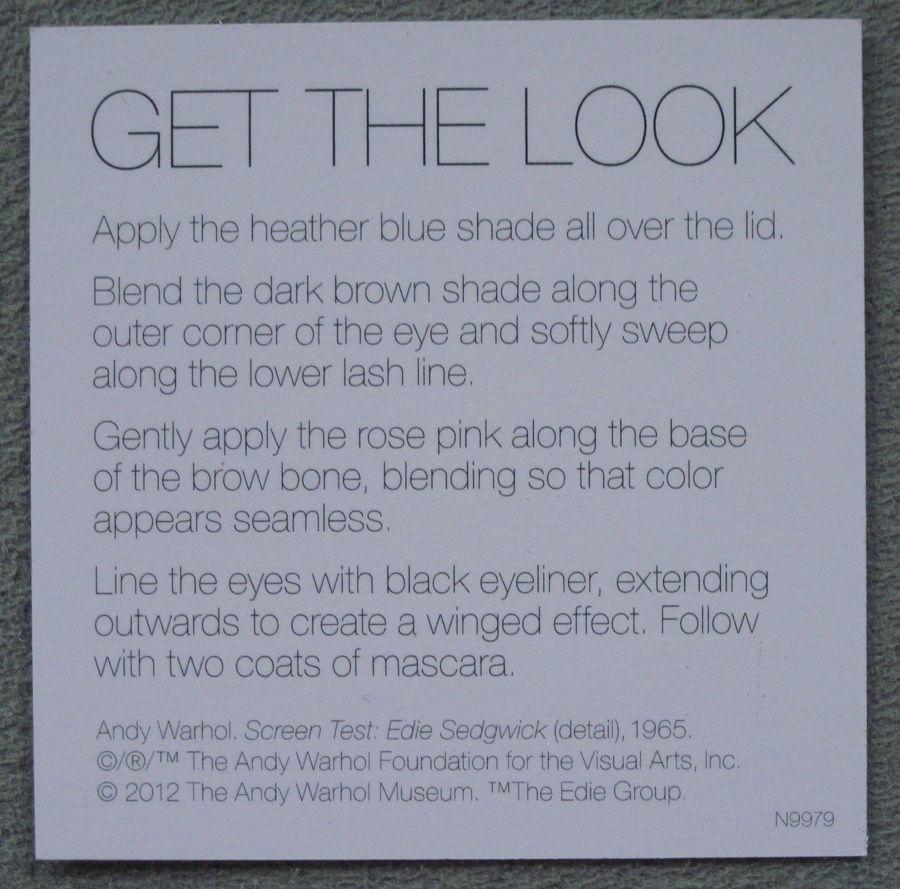
Each palette also came with a booklet, with different content than the ones for the Flowers palettes. (The one shown below is slightly bigger than the ones included with the Self-Portrait palettes – this bigger version is included with the Beautiful Darling and Photobooth gift sets.)
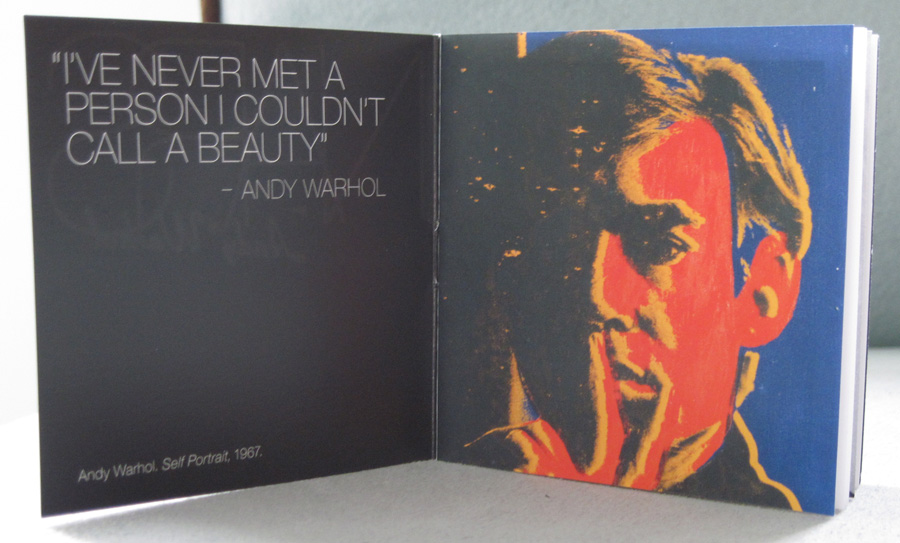
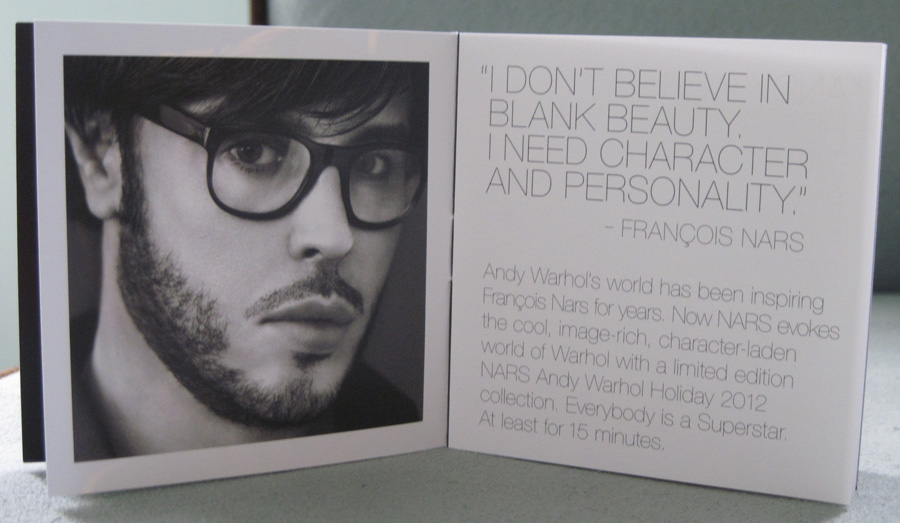
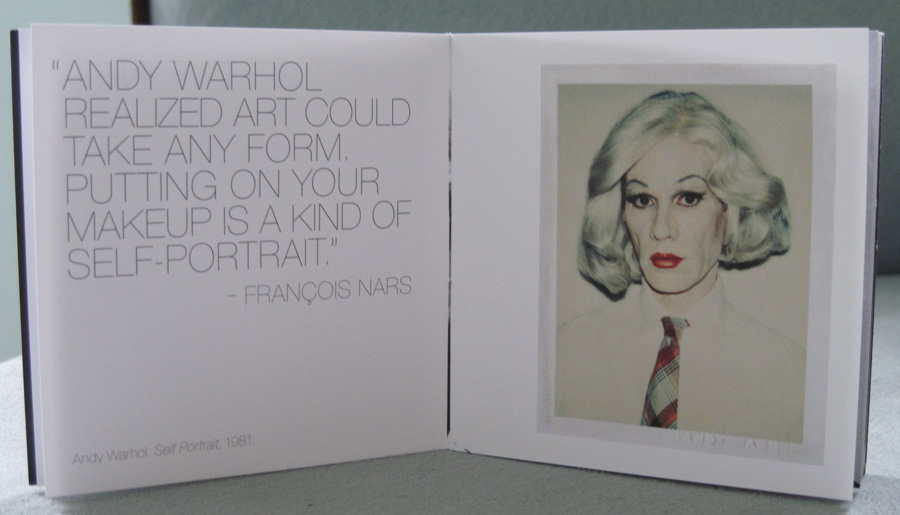
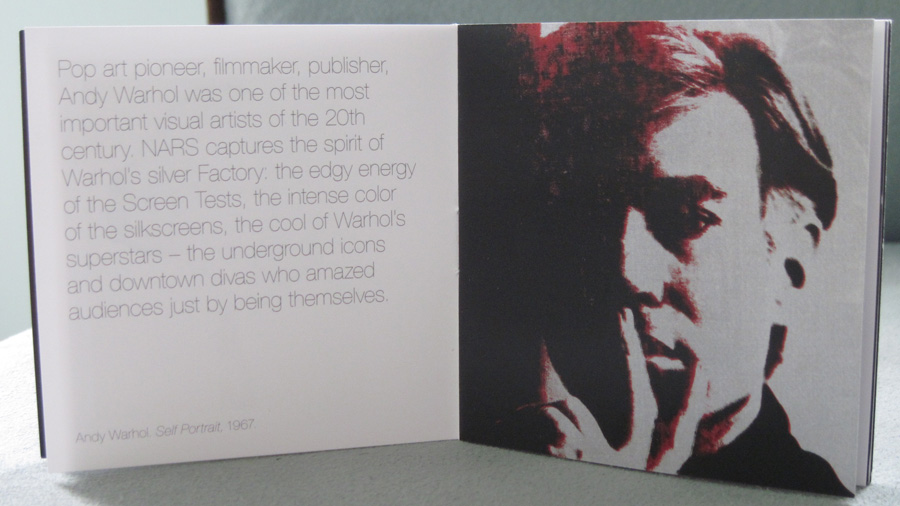
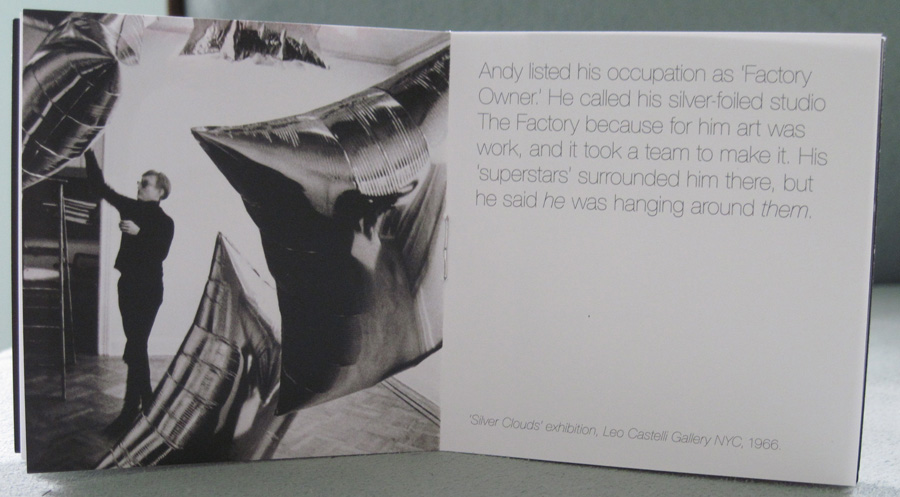
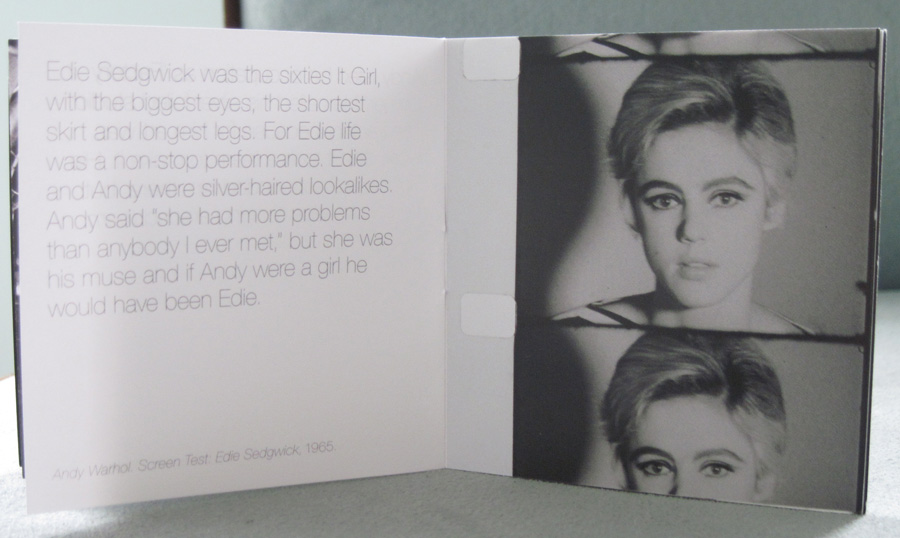
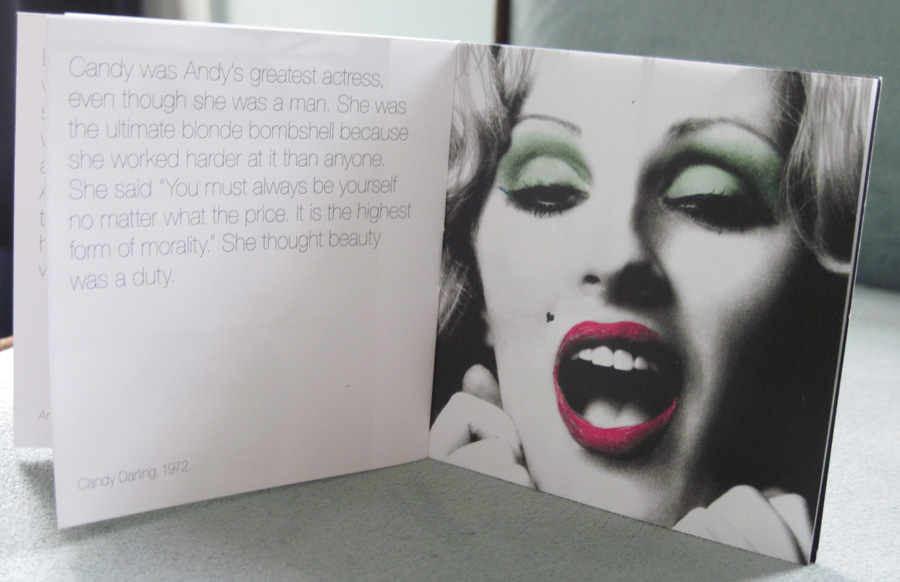
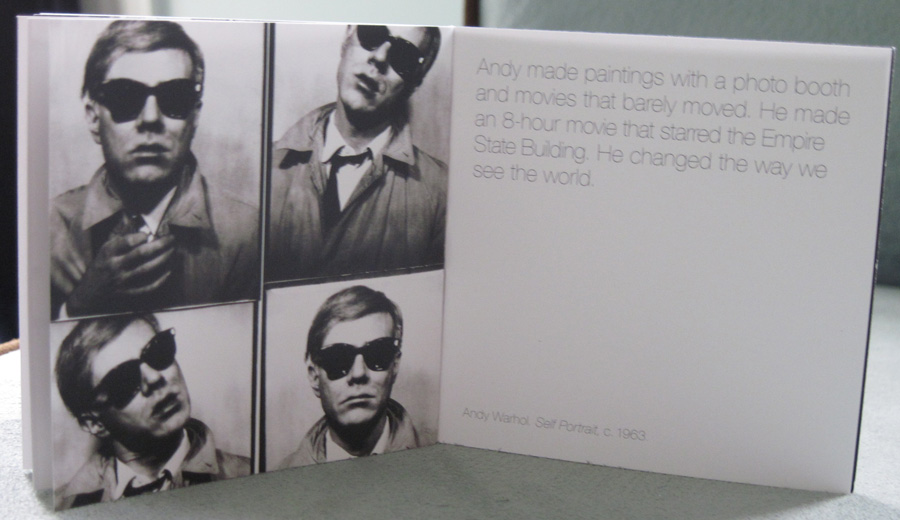
Getting back to the self-portraits, here is one of the original 1967 silkscreens. Like Warhol's earlier Flowers, the image is based on a photo (this time, taken by Rudolph Burkhardt) and was hung in blocks of 4 or more.
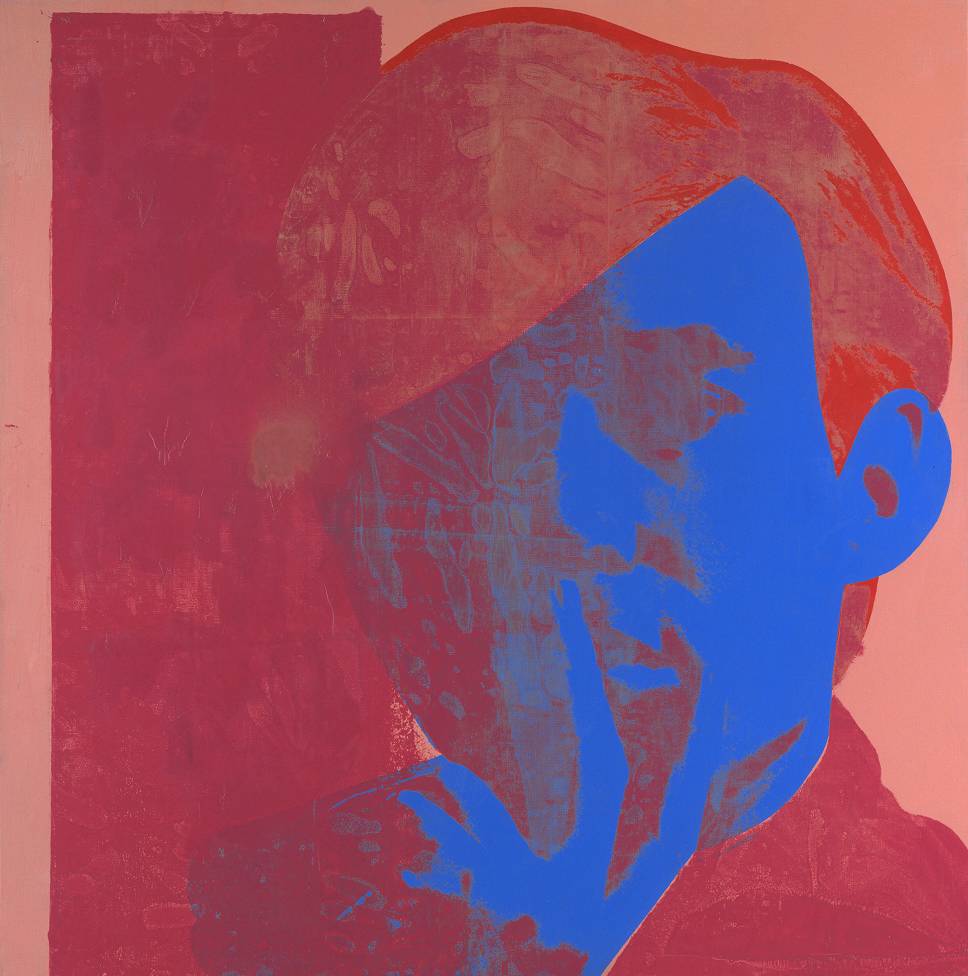
(image from tate.org.uk)
Much has been written about Warhol's self-portraits, and while I can't cover everything, I can tell you how two themes are identical to those found in Flowers. 1. As with Flowers, Warhol's Self-Portrait upends an art historical tradition – in this case, that of the brooding, intellectual self-portrait of the artist, while in Flowers it was the still-life – through the use of psychedelic colors and a rather theatrical pose that was not meant to convey the "real" Warhol. "Warhol has taken this mainstay of the history
of art and has resurrected it with the colors and the patterns and even
the media of the modern world. By taking a photograph of himself as his
subject matter, he has not only carried on the tradition, but has also
attacked it, assaulting it with the sheer force of innovation. The
screenprint process itself adds a twist, as Warhol has deliberately
excluded himself as much as possible from the creation of his likeness.
To what extent, then, is this a self-portrait? Warhol is
perversely celebrating his connection to the piece while advertising his
own detachment from it. Meanwhile, the mad colors, which completely
avoid any attempt at realism, and the simple, almost cut-out fields in
which they have been applied, work visually on an aesthetic and
expressionistic level yet show his irreverence towards the painstaking
oils of hallowed forebears such as Rembrandt and Cézanne. This is the
ultimate Pop self-portrait, at once iconic and iconoclastic…Here, even his appearance as an intellectual appears almost
theatrical. This is a self-conscious pose, echoing Rodin's Le Penseur.
Warhol is deliberately casting himself in a new light, presenting
himself as some manner of artistic svengali…He is not only editing
how he is perceived, but is deliberately playing with his image. There
is a strange tension between Warhol presenting himself as the thinker,
as the lynchpin of the avant garde, and at the same time
self-consciously striking a pose. This pantomime level shows an artist
unwilling to take even his own position too seriously. Rather than present us with the 'true' Andy Warhol, he has instead
edited, omitted, posed and colored his image in search of something that
he has controlled – his 'good picture'. Ironically it is through this
playfulness that we begin to detect the true likeness of the artist
himself."(source)
2. Once again, the notion of death winds its way through Warhol's work, although it's not explicitly depicted. "Throughout the history of art, the main role that the self-portrait has
played is not the celebration of the artist, but a testimony to the
artist's achievements. Whenever a self-portrait is created, no one can
help but ask which will last longer, the artist or the artwork?… However much an artist believes in the
durability of their work, or of the lasting nature of their influence,
the reality of death is more apparent in a self-portrait, literally
staring them in the face. This makes the dark colors of Self-Portrait
and Warhol's pensive look all the more appropriate. It is not so much
his fame, or his arrival, that the artist appears to be contemplating,
but instead death." (source)
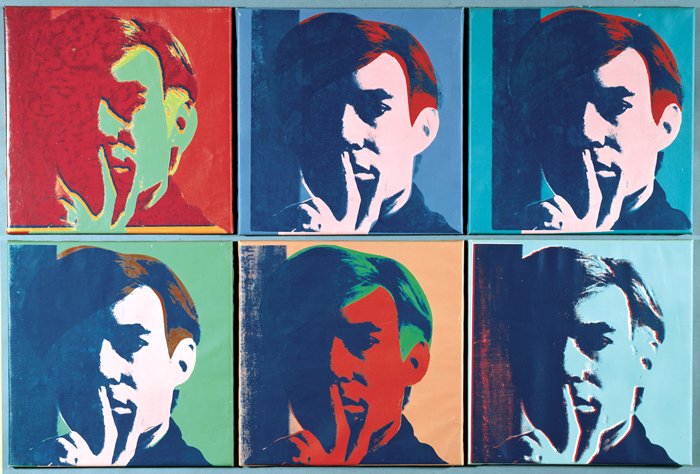
(image from sfmoma.org)
Next we have the Beautiful Darling Gift Set, which includes Candy Darling nail polish, Femme Fatale eyeshadow duo, and Woman in Revolt lip gloss. "Candy was the ultimate blonde bombshell. She was Andy’s greatest actress, even
though she was a man. She said 'You must always be yourself no matter what the
price. It is the highest form of morality.' She thought beauty was a duty and worked
harder at it than anyone." Both the outer box and the silver pouch feature a still from Beautiful Darling, a 2010 documentary on Candy (her life was cut tragically short by cancer at the age of 29).
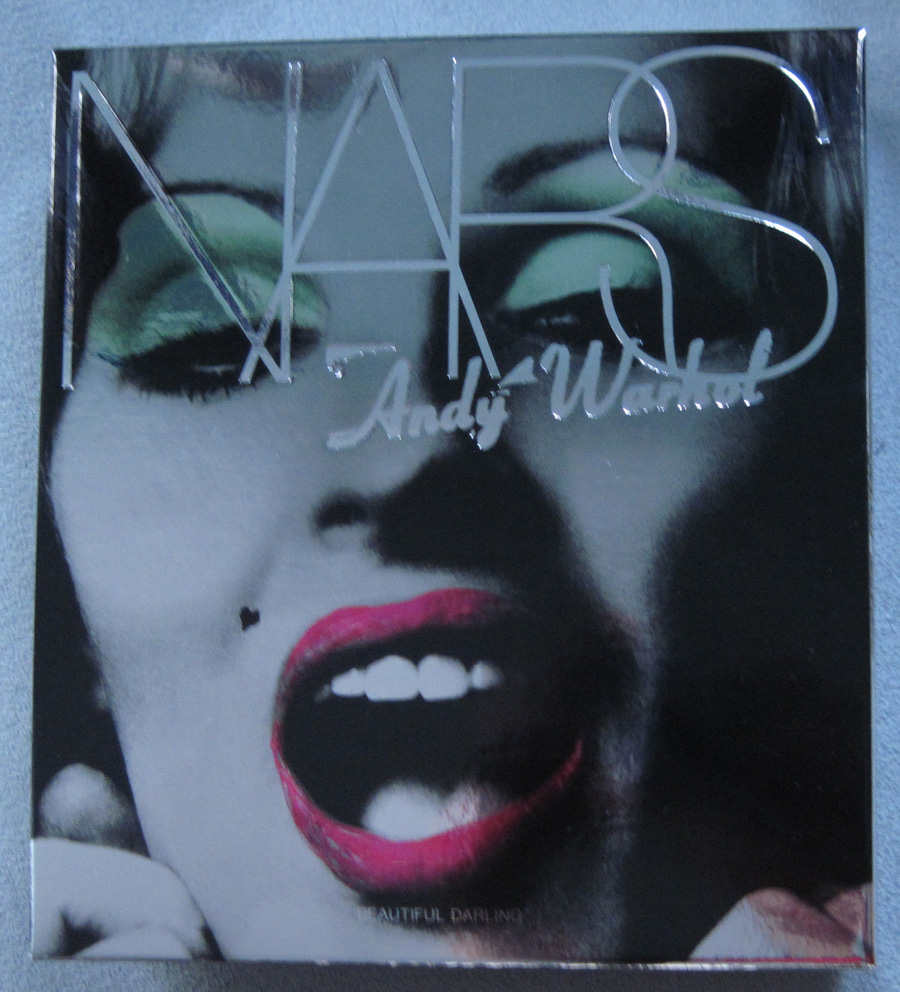
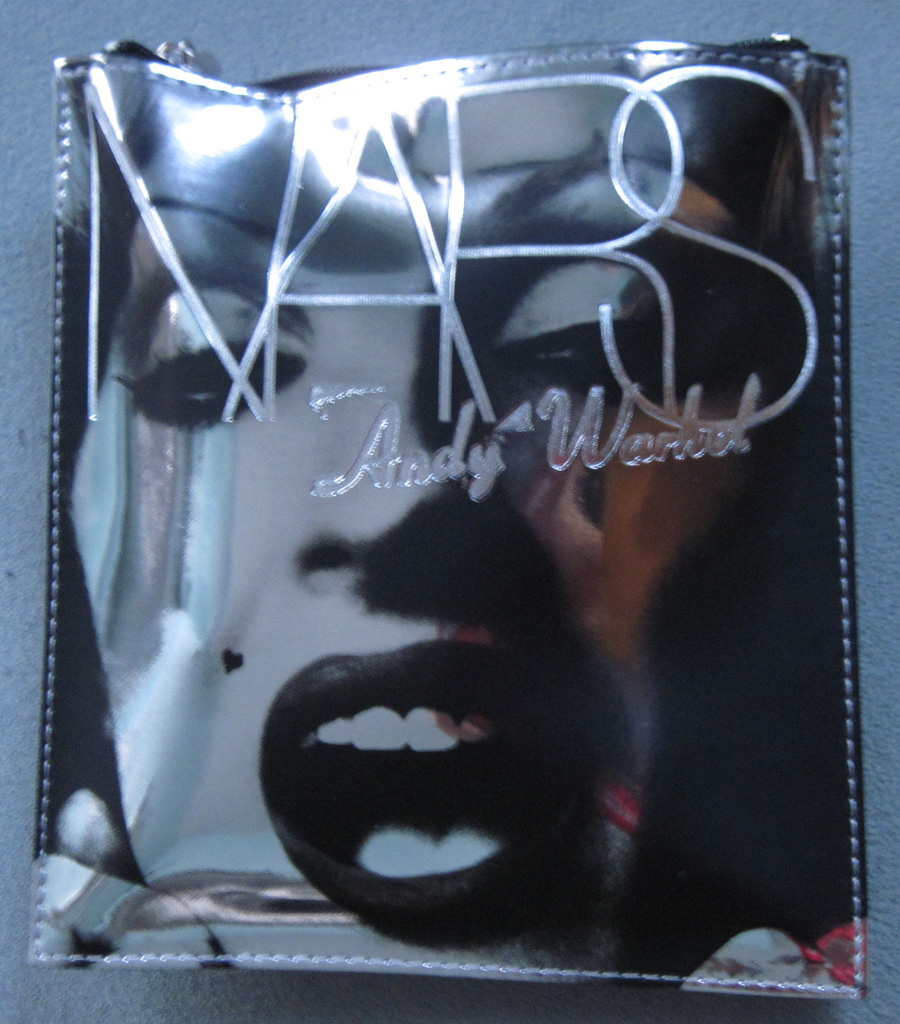
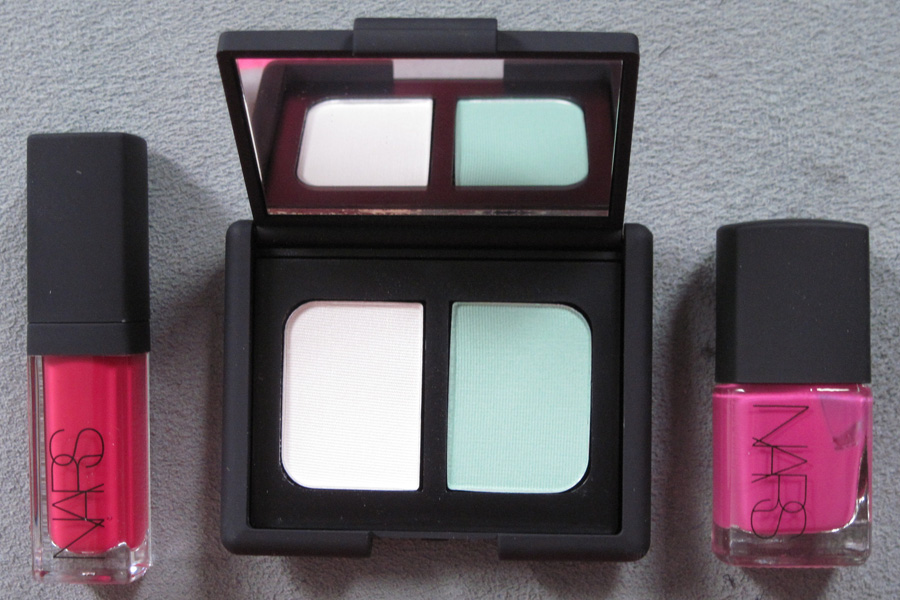
Born in Long Island as James "Jimmy" Slattery, Candy Darling met Warhol in 1967. They immediately connected due to their lifelong fascination with Hollywood. Warhol casted her in several of his films, which used Candy's ultra-glamourous presence and acting ability to their full potential. Says one biographer, "Blessed with good looks and loads of
acting talent, through force of will Candy Darling became the
incarnation of the old-school Hollywood stars that both the young boys
Jimmy Slattery and Andrew Warhola had adored. Although one of
Candy’s most prominent characteristics, besides her beauty, was her
sharp wit and comedic skill as an actress, this, unlike so many drag
acts, was no send-up of femininity, not even an act, beyond the sense in
which each of us, in constructing a persona, puts on an act. This
probably accounts for Candy’s enduring mystique and appeal. The fact of being a male impersonating a
woman, a movie star, was audacious (even illegal) in itself, yet Candy’s
own behavior, unlike that of so many members of Warhol’s troupe, was
not flamboyant, but rather demure and ladylike, ultimately increasing
her magnetism."
Onto another one of Warhol's superstars: Edie Sedgwick. According to NARS, "Edie Sedgwick was the sixties It Girl, with the biggest eyes, the shortest skirt and the longest legs. For Edie life was a non-stop performance. Edie and Andy were silverhaired lookalikes. Andy said 'she had more problems than anybody I ever met,' but she was his muse and if Andy were a girl he would have been Edie." The Edie gift set is packaged in a film canister and includes Film Star lipstick, Edie eye shadow, Carpates eye liner, and a blush duo. The canister shows a still from her Screen Test of 1965 (Warhol invited many people sit for film portraits but named them Screen Tests).
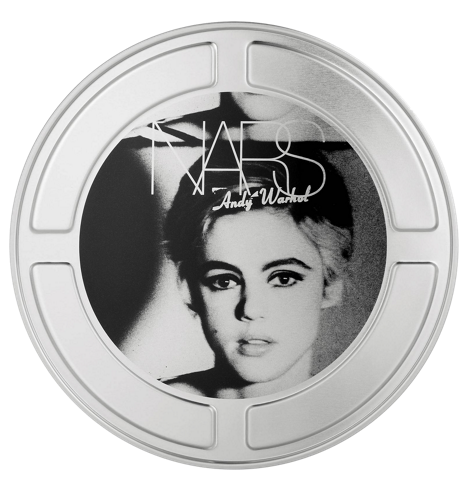
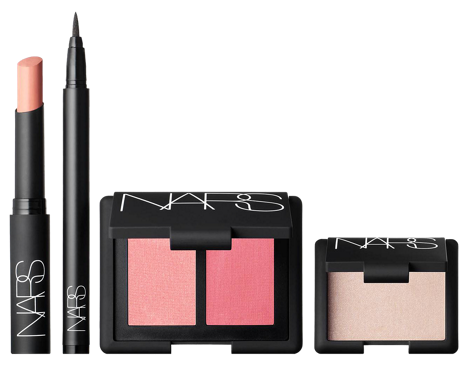
(images from barneys.com)
Edie met Warhol in 1965, and was only part of his world for a little over a year. Based on what I've read about her, she seems to have been a lost soul. There was a family history of mental illness, which she developed herself early in life. She turned to heavy drug use and ultimately died of an overdose at 28. If I can play armchair psychologist for a minute, I think she gravitated towards Warhol because she was looking for a way for people to pay attention to her and make her feel special, along with wanting to become a full-blown celebrity. I also got the feeling she was a huge phony, as she came from significant wealth but pretended to be a struggling actress, yet simultaneously bragged about how much money her family had. When someone better (in her eyes) came along to fulfill her needs with the promise to make her a star – in this case, Bob Dylan – she abruptly left the Factory and stopped speaking with Warhol. She never did become a celebrity either through acting or modeling; the highest level of notoriety she achieved was socialite, and an erratic, drug-addicted one at that. Reading about her life made me feel fairly sad.
Let's go to something slightly more upbeat!
The biggest (and most expensive) set in the collection is the Silver Factory set. "Andy listed his occupation as ‘Factory Owner.’ He called his silver-foiled studio
‘The Factory’ because for him art was work, and it took a team to make it. His
‘superstars’ surrounded him there, but he said he was hanging around them." The set includes the Multiple (highlighter/blush) in Silver Factory, eye shadow trio, lipstick in Chelsea Girls, blush, eye liner, eye shadow brush and blush brush.
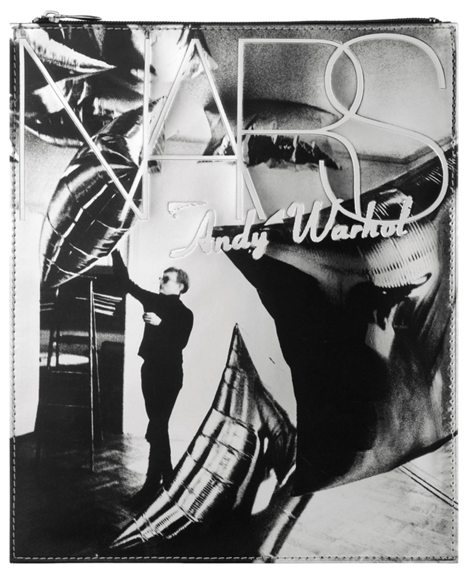
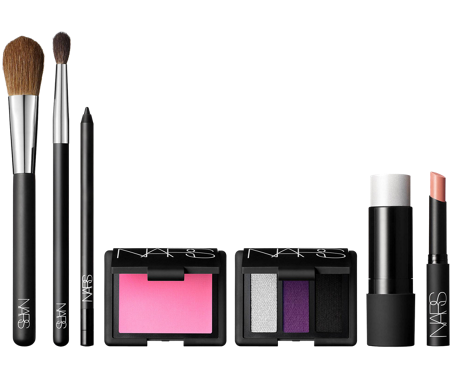
(images from barneys.com)
Ah, The Factory. How can I explain? In a nutshell, it was a warehouse-sized space that Warhol used as a studio beginning in 1964, but was also used for some serious partying – a "non-stop freak
out, a long burst of sex, drugs, rock and roll, art, and pop culture." Decorated by Warhol's friend and in-house photographer Billy Name, the Factory was covered entirely in silver paint, fractured mirrors and tin foil, even the elevator. "Warhol assembled a menagerie of
adult film performers, drag queens, socialites, drug addicts,
musicians, and free-thinkers that became known as the 'Warhol Superstars' to help him. These 'art-workers' helped him create his paintings,
starred in his films, and basically developed the atmosphere for which
the Factory became legendary." (source)
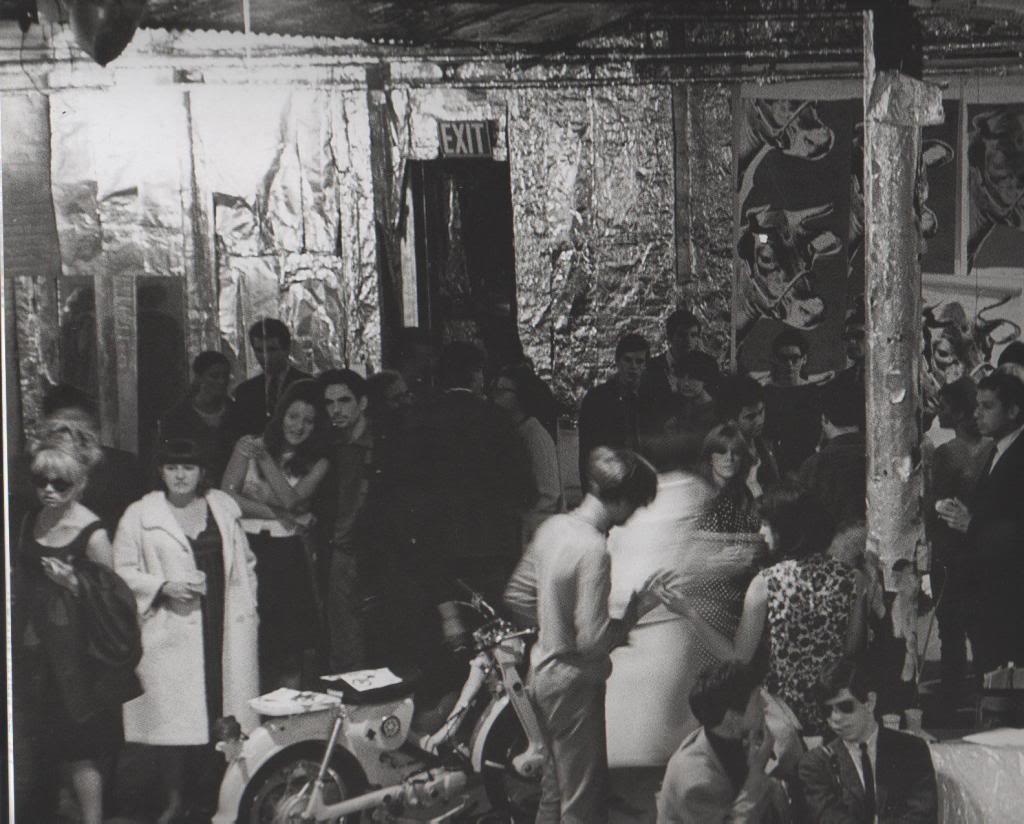 (image from basisdesign.com)
(image from basisdesign.com)
According to one account, the first series of art works Warhol created there were packages for food and other grocery store items.
"The first works created at the Factory
were a series of food boxes. Andy was fascinated by the shelves of foodstuffs
in supermarkets and the repetitive, machine-like effect they created… He wanted
to duplicate the effect but soon discovered that the cardboard surface was not
feasible. I located a carpenter in the East Sixties, and Andy hired him out
to build plywood boxes that we would then paint and screen, to create the illusion
of the real thing… The brand names chosen consisted of two versions of Brillo,
Heinz Tomato Ketchup, Kellogg's Corn Flakes, and Mott's Apple Sauce. We obtained
cardboard-box samples of each of these products wither from a grocery store
or, in the case of the Brillo box, directly from the manufacturer… We were able to get at least
two sides done in a day. A hundred or more were produced in a period of a month.
They were literally three-dimensional photographs of the actual products."
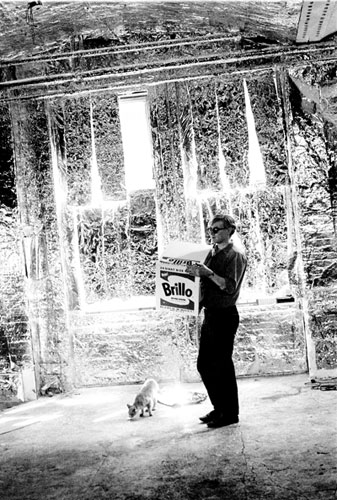
(image from fleisher.org)
The Factory eventually had three different locations between its inception and 1984, and was constantly buzzing with work on movies, photos, and silkscreens. As former Velvet Underground member John Cale said, "It wasn't called the Factory for nothing. It was where the assembly line for the silkscreens happened. While one person was making a silkscreen, somebody else would be filming a screen test. Every day something new."
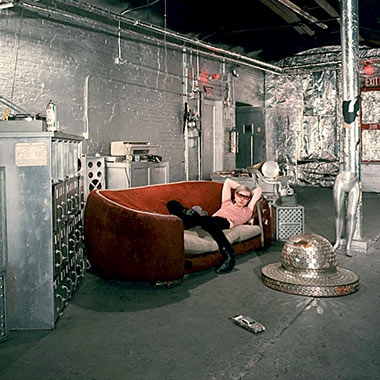
(image from caronparis.tumblr.com)
There is far too much to discuss when it comes to the projects and other things that transpired at the Factory over the years, so I'll just say this – I would love to have been a fly on the wall at any given party there!
Rounding out the collection is the Photobooth gift set (which you can still enter to win!). It includes nail polishes in Back Room (black), Soup Can (tomato red), Chelsea Girls (beige), and Silver Factory (light metallic silver). The box features Warhol's 1963 shots from a Times Square photobooth.
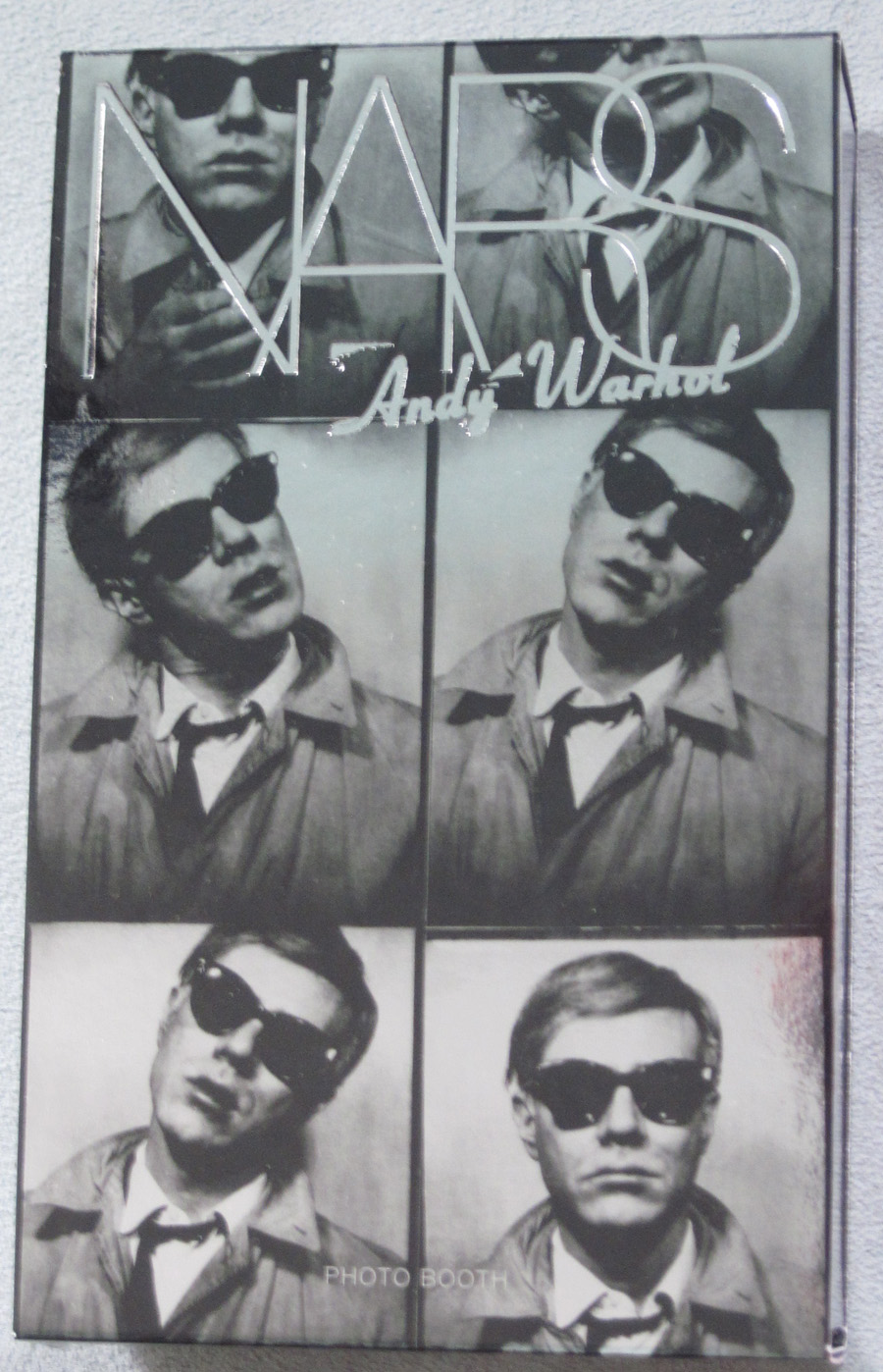
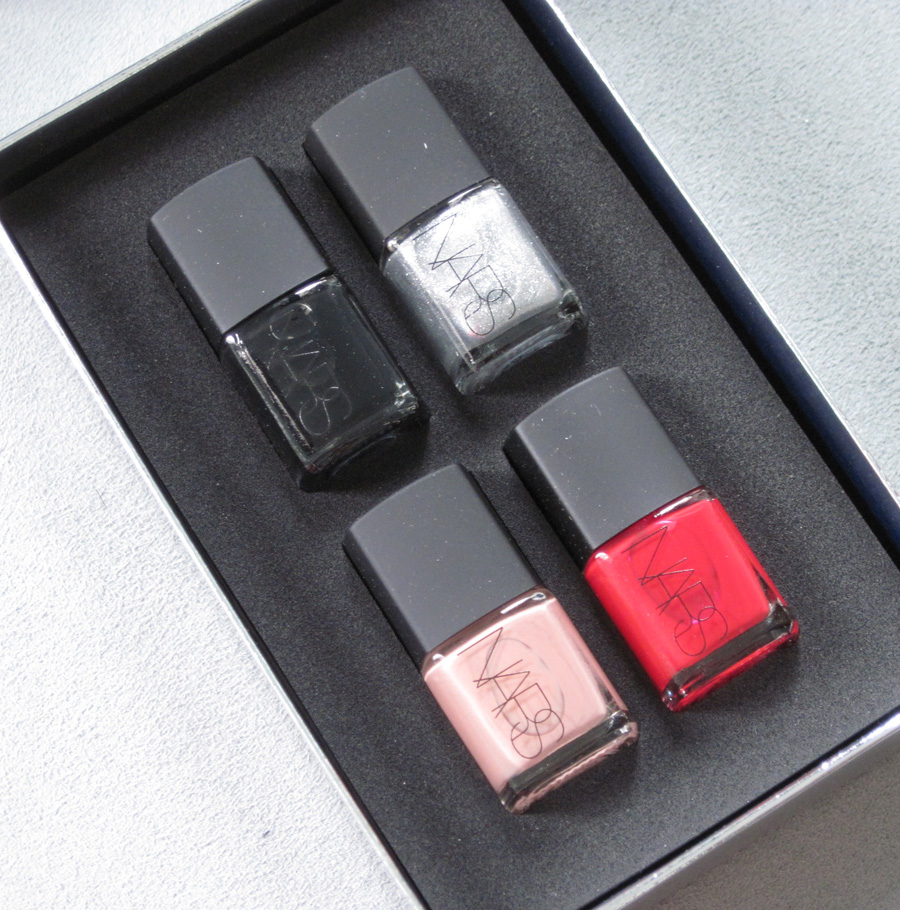
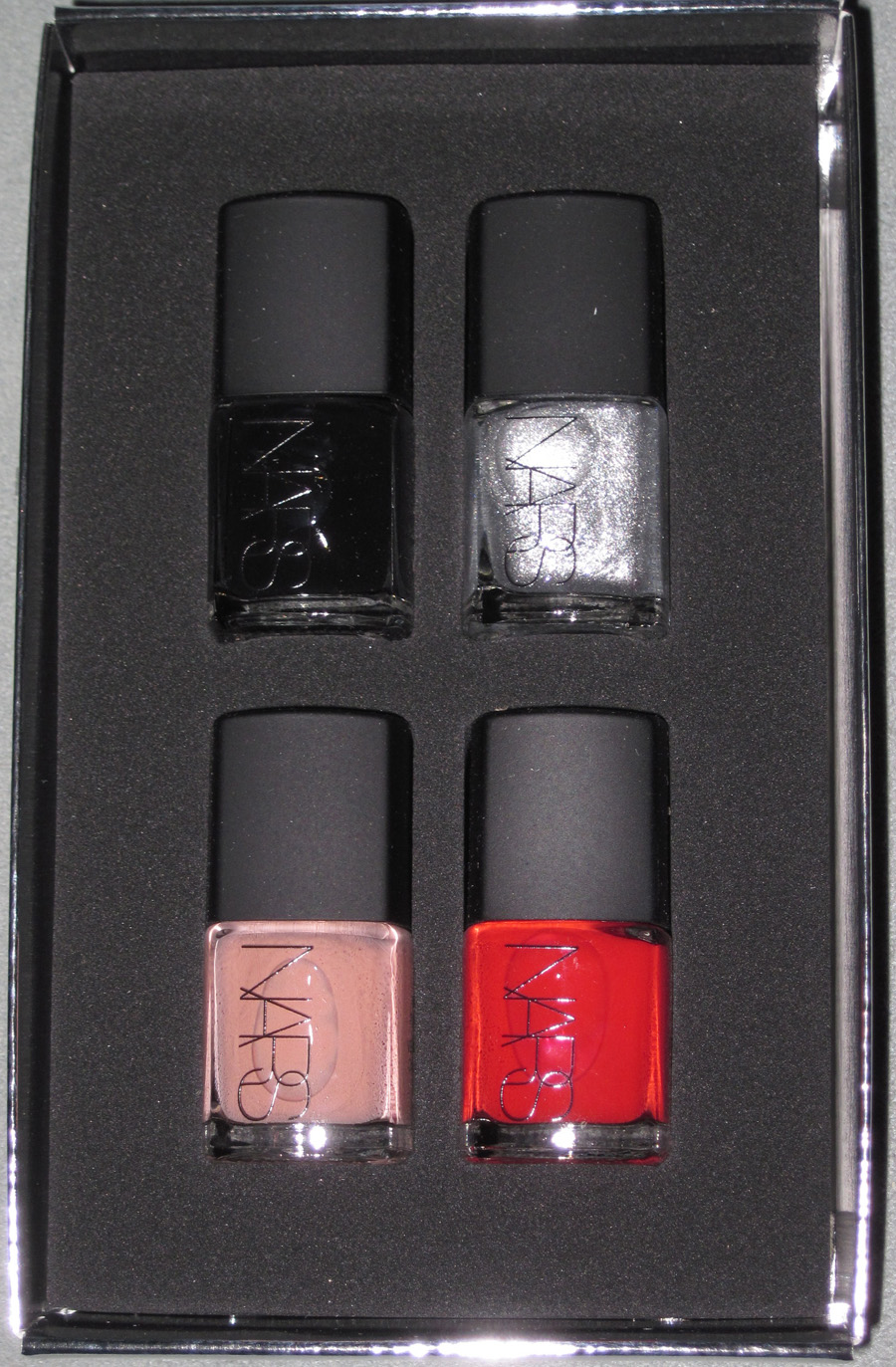
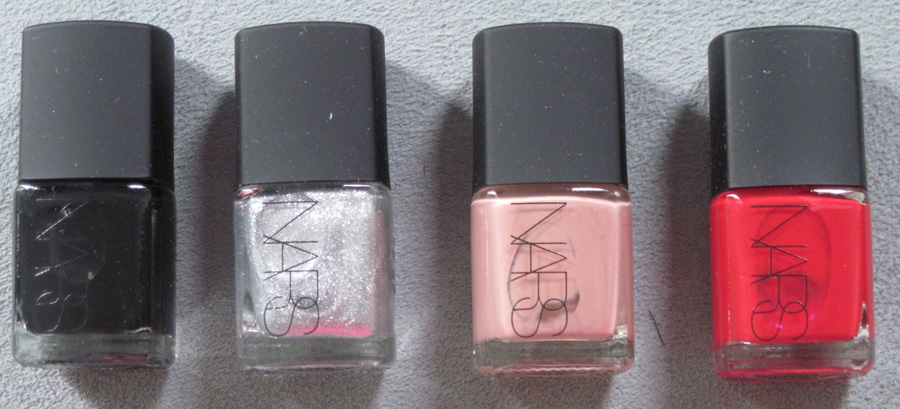
He was commissioned to make a silkscreen painting out of these pictures for Detroit art collector Florence Barron. The original price was $1,600 (roughly $11,000 today). It fetched $38.4 million at a 2011 Christie's auction.
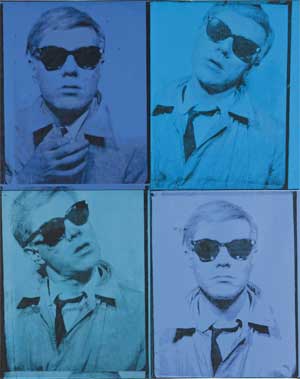
(image from vendingtimes.com)
Christie's describes the photobooth series, providing some insight as to this image was chosen for the NARS Silver Factory collection and how it relates to the other "superstars" included: "Warhol’s decision to make his first self-portrait using a photobooth
was a genius act that reflected both his admiration for Marcel Duchamp
and the latter’s concept of the 'ready-made' work of art, as well as
Warhol’s own oft-stated desire to be a machine. The common dime store 'photomat' clearly conformed with Warhol’s desire to create a new
mechanical and democratic art for a massconsumer and mass-media obsessed
world. The photobooth’s impersonal lens offered a nonprejudicial and
artless image of whatever pose or face the sitter wished to present to
it. Behind its closed curtain, anybody could be a 'superstar' of their
own making. While Warhol’s earlier use of photography had been
restricted to the recycling of previously published media images, his
discovery of the coin-operated photobooth gave him a means to generate
unique images that at the same time had been made by a public machine
that everyone had access to. Warhol was inspired to use the photobooth after being commissioned by Harper’s Bazaar
magazine to provide images for an article in the April 1963 issue…The photobooth was the perfect tool for Warhol’s
vision: he loved the photostrip’s seriality, its resemblance to
filmstrips; he enjoyed the photobooth’s elimination of the photographer,
and along with the silkscreen, its ability to remove Warhol’s art yet
another step from the human touch. Within the private domain of the
booth, one could act out one’s fantasies as though in front of the
bathroom mirror; and he reveled in the sleaze factor – the booths in
Times Square were especially disreputable places." (emphasis mine) For more on his photobooth pictures, check out this book published by Robert Miller Gallery.
So that about wraps it up. I must say, I am now thoroughly exhausted! If you're still reading, thank you! I hope you enjoyed learning about Warhol for this collection as much as I did. And if you're not too tired to answer questions, which is your favorite piece in the Silver Factory collection and who would you want to hang out most with? Besides Andy himself, of course, my vote goes to Candy Darling – she seems like she would have been a lot of fun.
Hello! I hope everyone survived Hurricane Sandy okay. To brighten up this dreary, rainy, tail-end-of-the-storm day, I thought I'd share some sunny pics I took of the beautiful new NARS boutique in L.A. Last week the husband and I went to visit some friends and I managed to squeeze in a pilgrimage to the store.
I visited just 5 days after it had opened, so everything was pristine. I have never seen such clean testers before! I have a feeling that somehow they will stay that way. I didn't take many pics because we were the only people in there so I felt a little weird, but here they are.
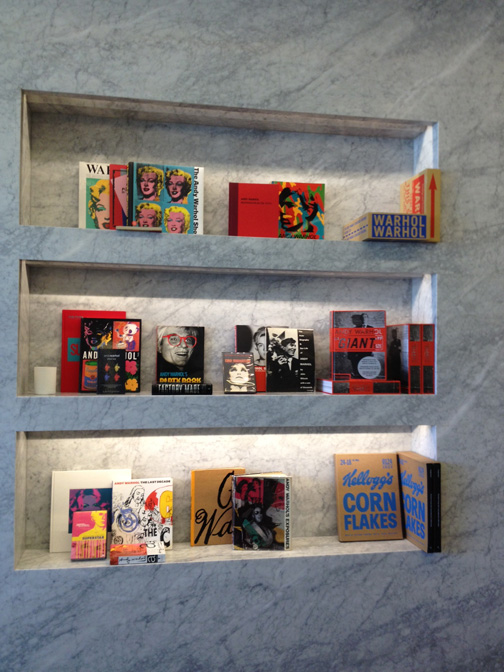
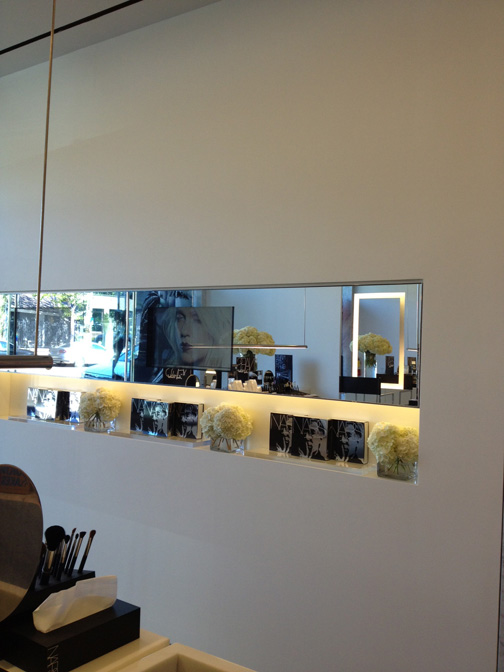
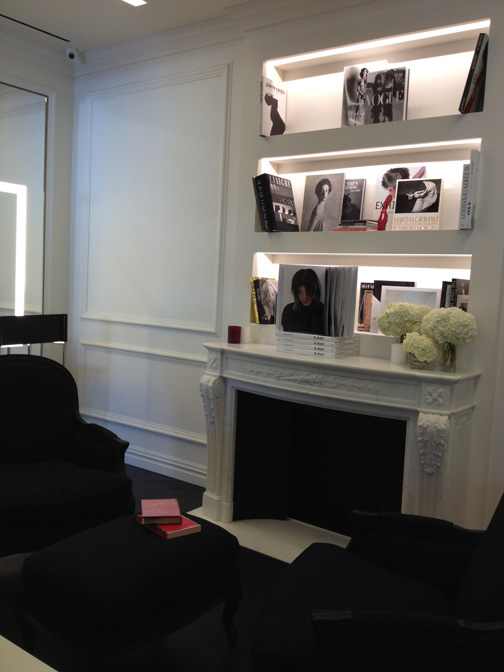
The SA was super nice and gave me a sample of the tinted moisturizer (which I've been dying to try), and a tote bag – a collector's dream! I didn't even ask for either of them.
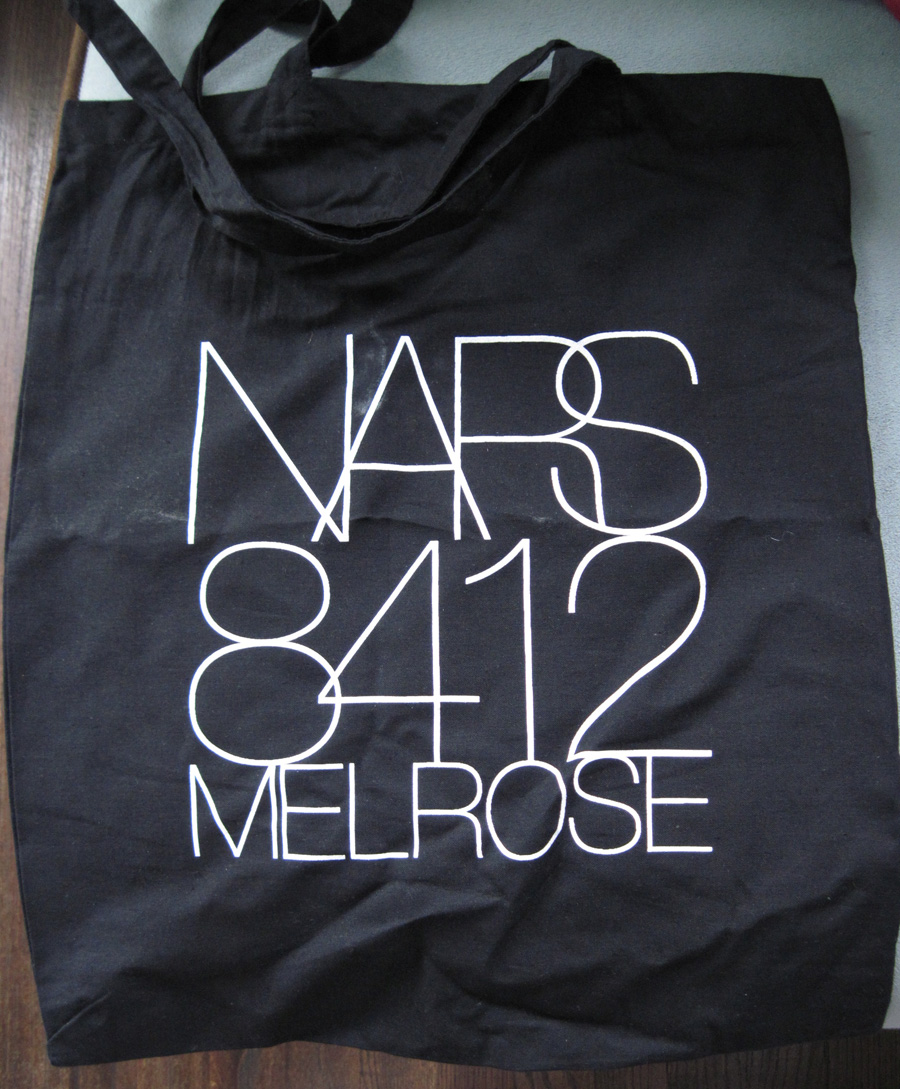
We continued walking down the street and just happened to stumble across Charm City Cakes' western outpost. No sign of Duff, though.
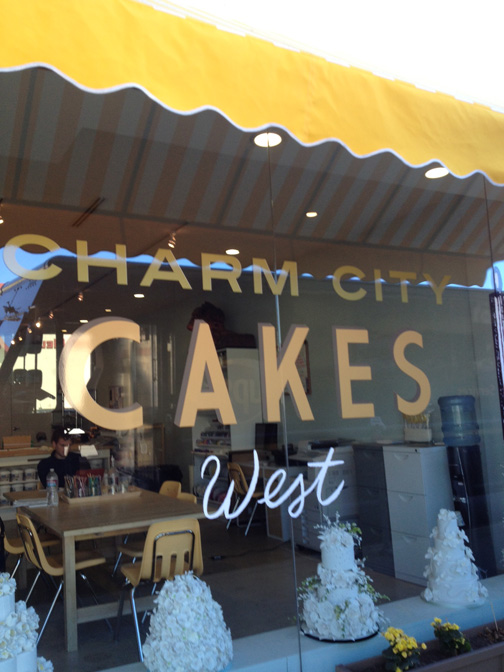
I have many more trip highlights but Sailor Babo will fill you in on those later this week over at his blog. 😉
Whispers of a collaboration between cutting-edge brand NARS and pop art pioneer Andy Warhol started circulating in March, and now it’s finally here. I can honestly say this is my all-time favorite collection for the Makeup Museum thus far. It perfectly embodies why I started the Museum in the first place – to showcase the connections between makeup design and art – and to date, this is the ultimate marriage of the two.
Warhol, like Marilyn Monroe, is getting a great deal of attention in 2012 – the 25th anniversary of his death. Campbell’s issued limited-edition Warhol print-adorned tomato soup cans, there was a tribute at a New York gallery and of course, let’s not forget the huge exhibition focusing on Warhol’s influence on contemporary art at the Met.
M. Nars has always been a fan of Warhol’s, given that the names of some of the items in his line (Edie eye shadow, Chelsea Girls lip gloss) were an homage to the artist. In an interview for New York Magazine, he says, “Over the years, I had so many
connections with Andy. When I was creating colors, I was inspired by his
movies and paintings, the Factory superstars, and his whole world, so
it felt like he was the right person to start with. ..he loved makeup. He was always experimenting with it. If you look at his silkscreens and old issues of Interview magazine,
everything was painted in a way that almost looked like slashes of
makeup. So we probably would have connected pretty well, I think.”
The Warhol Foundation was equally happy to collaborate with NARS. According to an AP article, “Michael
Hermann, licensing director for the Warhol foundation, said it decided
to venture into cosmetics with Nars because of the latter’s ‘fearless,
cutting-edge approach.’ ‘For Warhol, makeup was an arrow in the
quiver one could use to embody his democratic approach to beauty best
embodied in his own words when he said, ‘If everybody’s not a beauty,
then nobody is,’ Hermann explained.”
This post will examine the Pop collection, which is the first part of the collaboration to be released. A second collection called the Silver Factory collection will be released on November 1.
Warhol’s prolific output is way beyond the scope of my little blog. I will, however, highlight several of the works that are used in the NARS Pop collection. First up: the flower eye shadow palettes.
From the press release: “Andy said: ‘Pop art is about liking things.’ Like flowers. Soap. Money. Celebrities.
Warhol loved silk screens because if you get the picture right, you can make
more just the same. But in a range of colors – something different every time.
Andy said, ‘I use mostly artificial color.’ If you’re not trying to be real you don’t
have to get it right. That’s art.” The press release notes that the palettes are variations on Warhol’s Flowers from 1965, and Warhol had started the Flowers series a year before that. Here are the some of the prints from 1964.
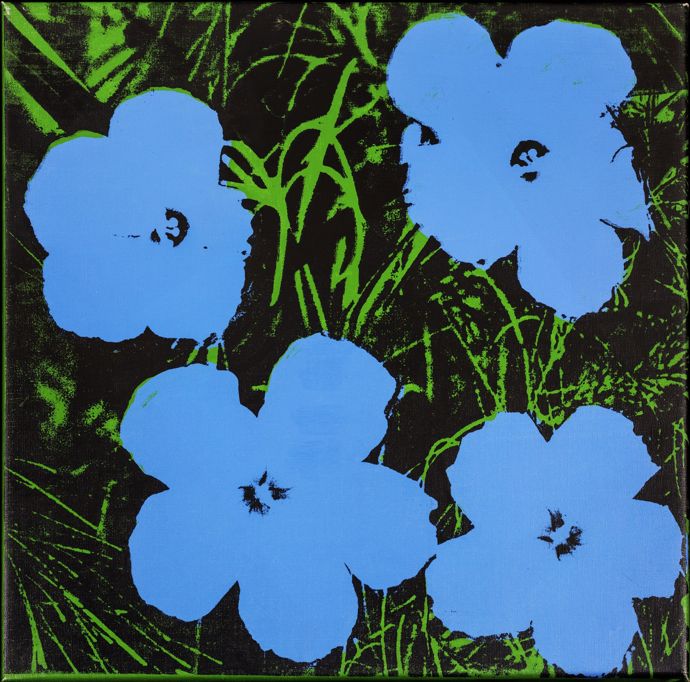
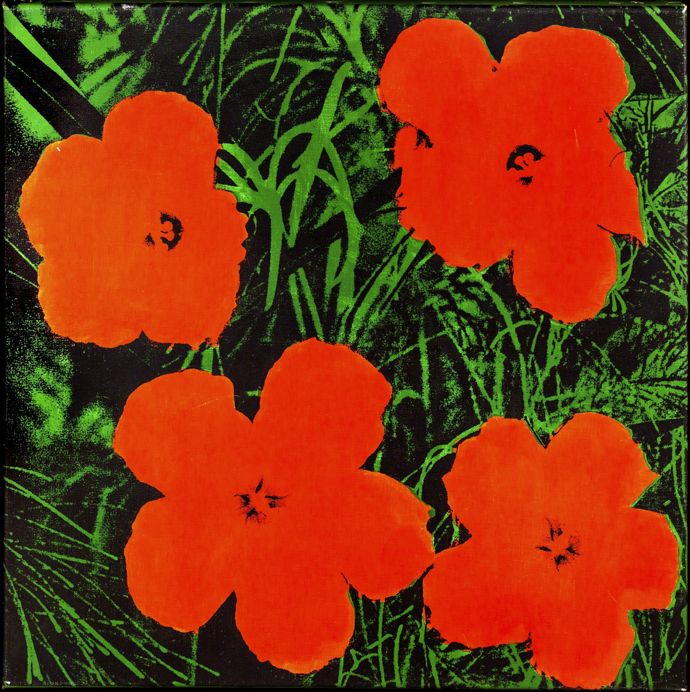
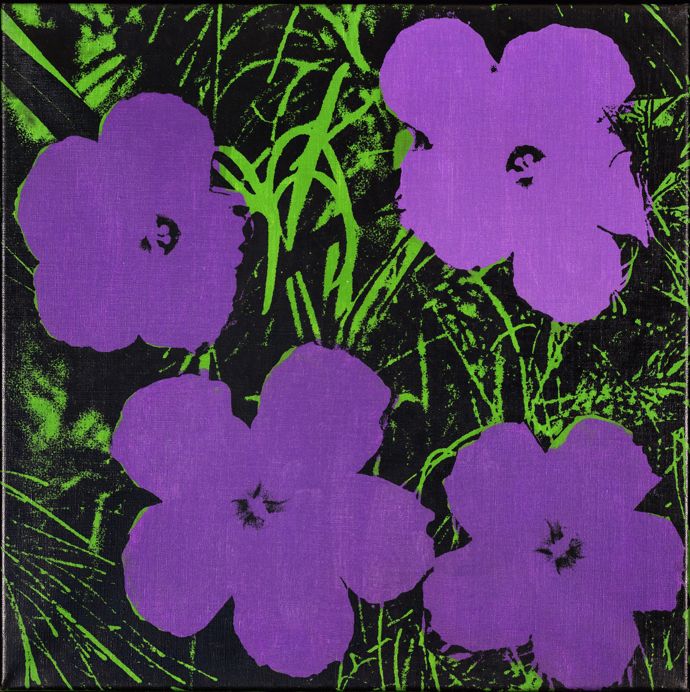
(images from voltcafe.com)
And here’s another from 1965.
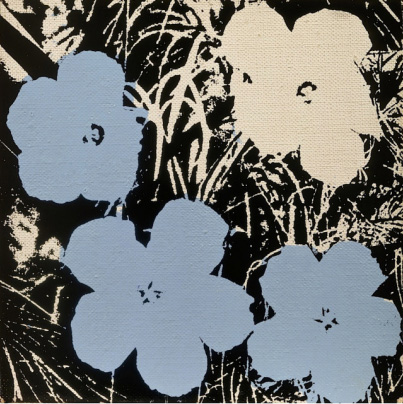
(image from art.com)
Henry
Geldzahler, then assistant curator at the Met, suggested Warhol take a break from his Death & Disaster
series. “Geldzahler gestured to a photo of flowers in Modern
Photography magazine, which Warhold in his deadpan style seized as his
subject.” (The photographer of the flowers, Patricia Caulfield, brought a lawsuit against Warhol for using her photograph without her permission. He offered two sets of Flowers portfolios as payment. She declined and the two arranged a cash settlement. If Caulfield is still alive, I bet she’s kicking herself now seeing as how the original Flowers silkscreens are worth millions.) The series was created for an exhibition at the Leo Castelli Gallery in New York. To reach maximum graphic impact, Warhol cropped the original image to fit a square format and rotated one of the flowers (you can see the slight distortion in the grass pattern). There was no “correct” position for the images and they could be hung in any order.
There are two main themes within Flowers. One is how the manipulation of the original image both turns the traditional art historical floral/still life genre on its head and simultaneously provides a commentary on commercialized mass production. “Just as he did with Marilyn, here Warhol reduces the subject
to its image — flattening, artificially coloring, and dismembering it.
In so doing, he rids the flowers of their assumed vitality and
prettiness…This work updates the
age-old genre of still life; Warhol’s choice of a vibrant palette is
consciously synthetic and an outright rejection of the complex color
harmonies normally associated with the genre. In place of painterly
illusion, Warhol’s choice of unnatural color emphasizes the flowers’
manufactured plasticity and relevance. His version is consciously banal,
yet unexpected and enchantingly beautiful. Quintessentially sixties in
their colors and floppy petal shapes, Flowers is a wonderful example of
the counterintuitive elegance of Warhol’s work. Technologically
mediated, repetitive and depersonalized, characterized by the modes of
mass production, the formal aspects of this work force viewers to
question the disconnect between image and reality, culture and nature.” (source) The Yale Art Gallery describes Flowers: “The mass reproduction of the image through the silkscreen process
reinforced the banality of the subject matter, perhaps even more bland
than his commercial imagery such as Coca-Cola bottles and soup cans of
the same period. Such repetition created the effect of wallpaper or
decoration, a form of ‘low’ art that stood in contrast to the elevated
poetic vision and emotive gestural abstraction of Abstract Expressionist
painting during the 1950s. Through distortion and flattening, and their
placement on black background with magnified, abstracted blades of
grass, Warhol’s flowers are completely removed from nature.”
The second idea Flowers hints at is death, even though Warhol was actively trying to shift away from the darker themes of his earlier series. Several accounts indicate that the 1964 works express a more threatening tone than the seemingly cheerful hibiscus blooms would initially suggest. Ronnie Cutrone, Warhol’s assistant for ten years, had this to say about the series: “The Marilyn paintings are about life and death, the Flowers are with their black, menacing background…I’m talking about
the first Flowers from 1964 – they are a bit menacing. We kids
– Andy used to call everyone a ‘kid’ until they were eighty-five years old
– all knew about that. Lou Reed, Silver George Milloway, Ondine, and me
– we all knew the dark side of those Flowers. Don’t forget, at
that time, there was flower power and flower children. We were the roots,
the dark roots of that whole movement. None of us were hippies or flower
children. Instead, we used to goof on it. We were into black leather and
vinyl and whips and S&M and shooting up and speed. There was nothing
flower power about that. So when Warhol and that whole scene made Flowers,
it reflected the urban, dark, death side of that whole movement. And as
decorative art, it’s pretty dense. There is a lot of depth in there… You
have this shadowy dark grass, which is not pretty, and then you have these
big, wonderful, brightly colored flowers. It was always that juxtaposition
that appears in his art again and again that I particularly love.” Indeed, one critic remarked, “It is the flash of beauty that suddenly metaphors that becomes tragic
under the viewers gaze. The garish and brilliantly coloured flowers
always gravitate towards the surrounding blackness and finally end up in
a sea of morbidity. No matter how much one wishes these flowers to
remain they perish under one’s gaze as if haunted by death.” This sense of dread is heightened by the fact that the last room in the original Castelli exhibit included one of Warhol’s portraits of Jacqueline Kennedy, which was based on a photo taken shortly
after her husband’s assassination. Allegedly “this led some observers to associate
the flower-covered gallery with a funeral parlor.” (source)
Now let’s take a look at the palettes, finally! The outer boxes are shiny silver, and the plain black rubber compact gets a silvery update too.
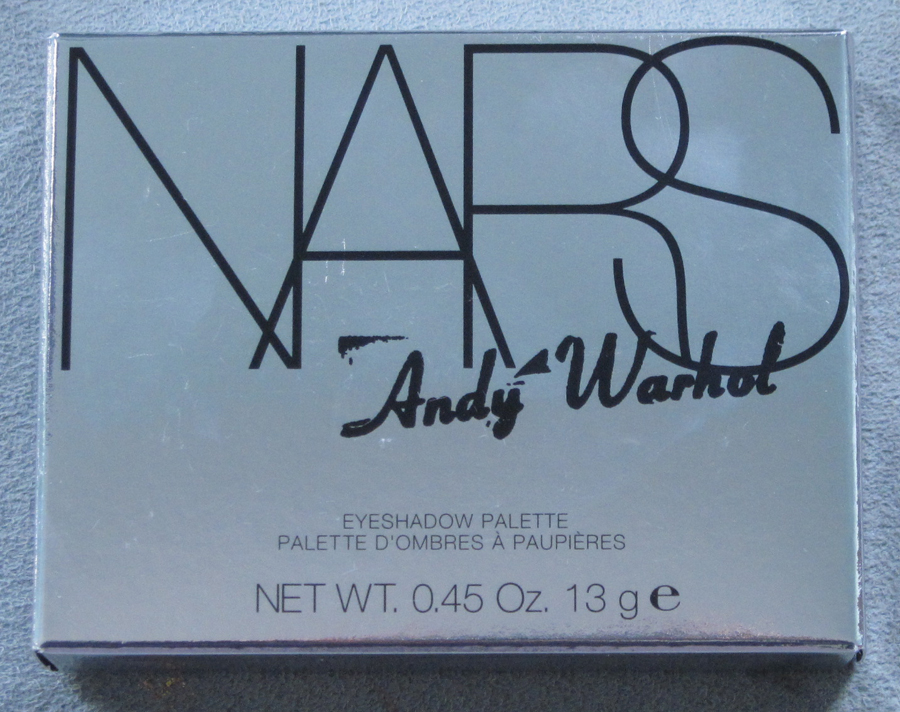
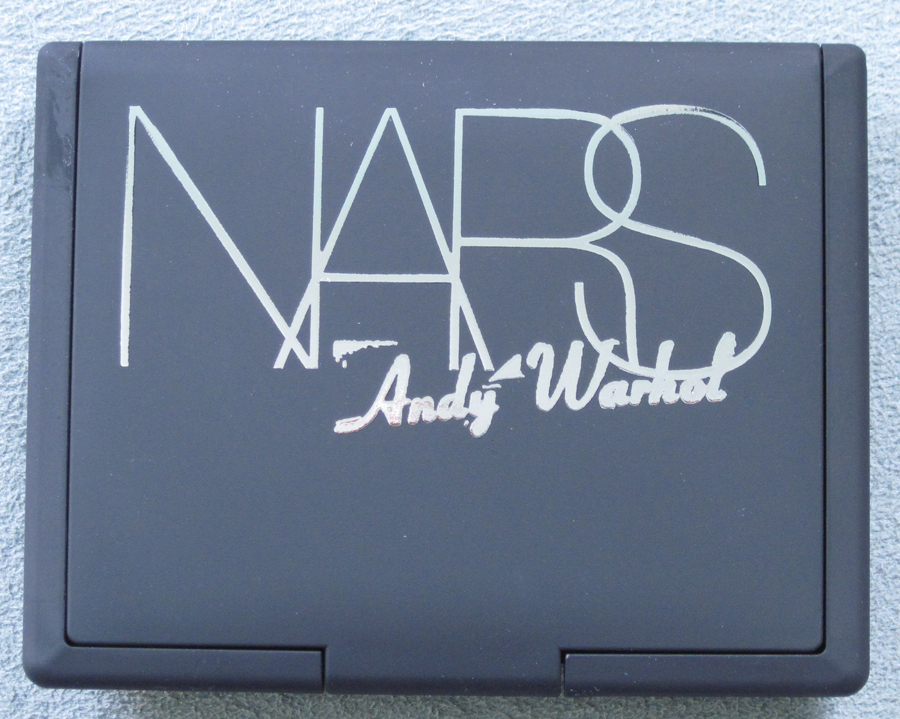
Flower palette No. 1:
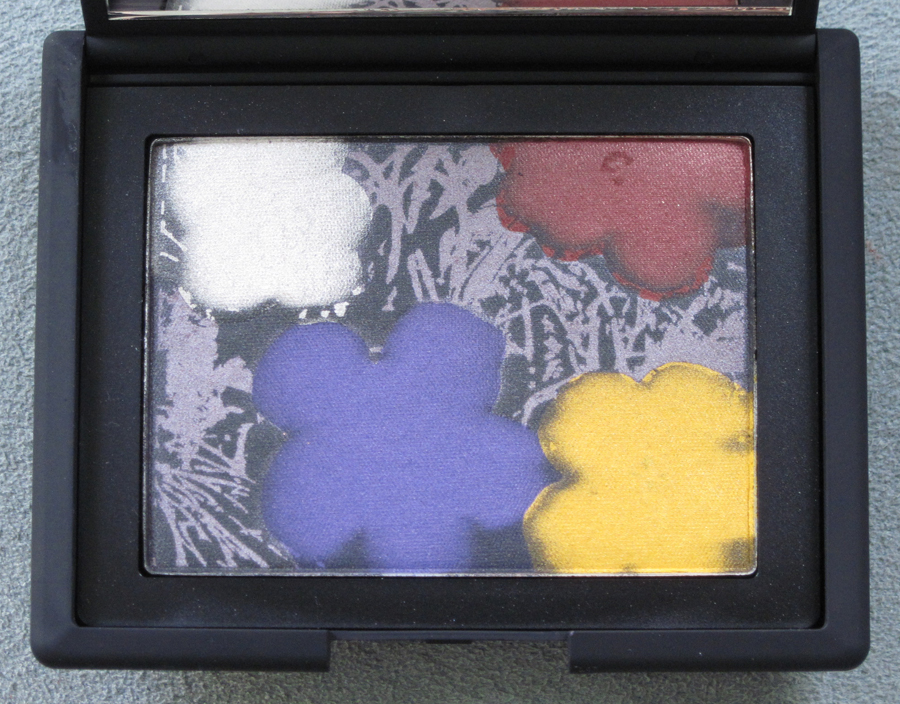
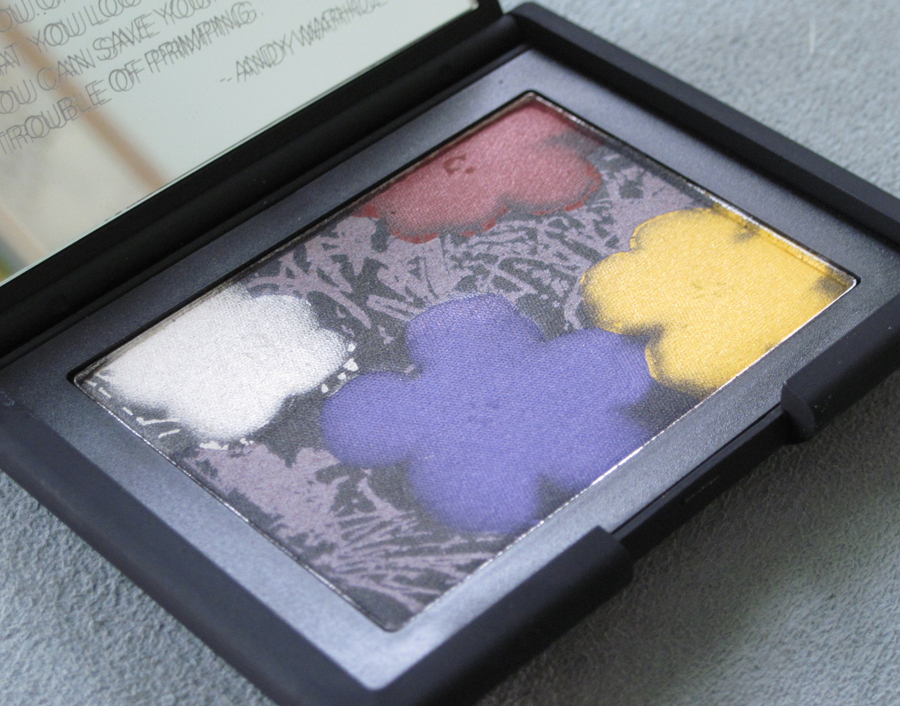
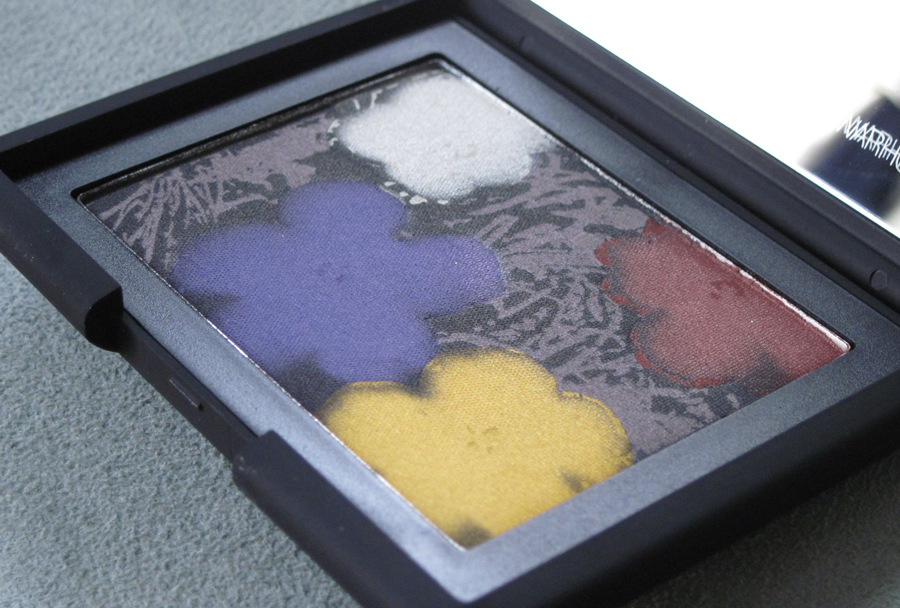
The Warhol quote on the mirror: “If you can convince yourself that you look fabulous, you can save yourself the trouble of primping.”
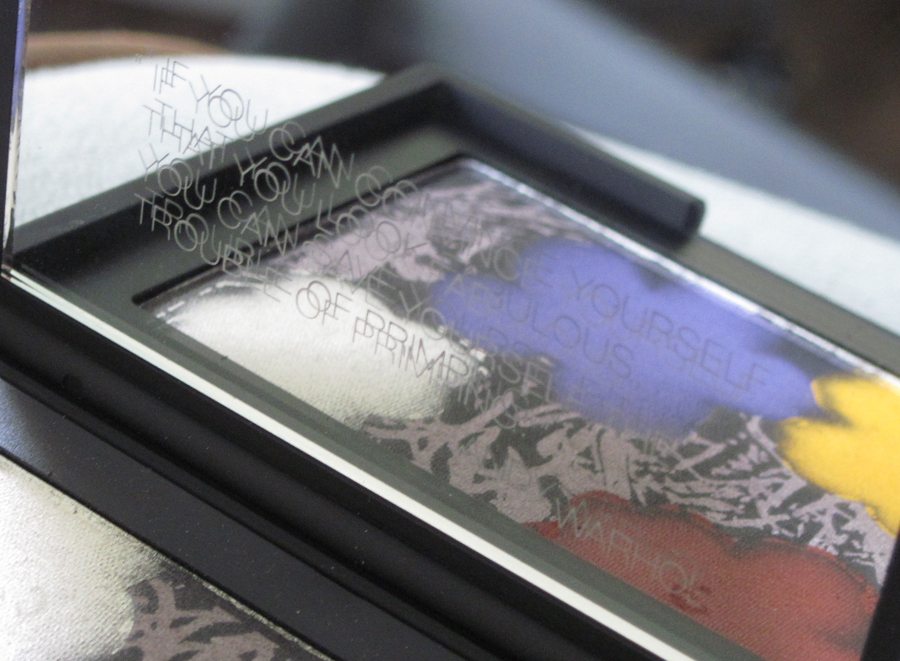
There were these little “Get the Look” cards to show you where to place each color.
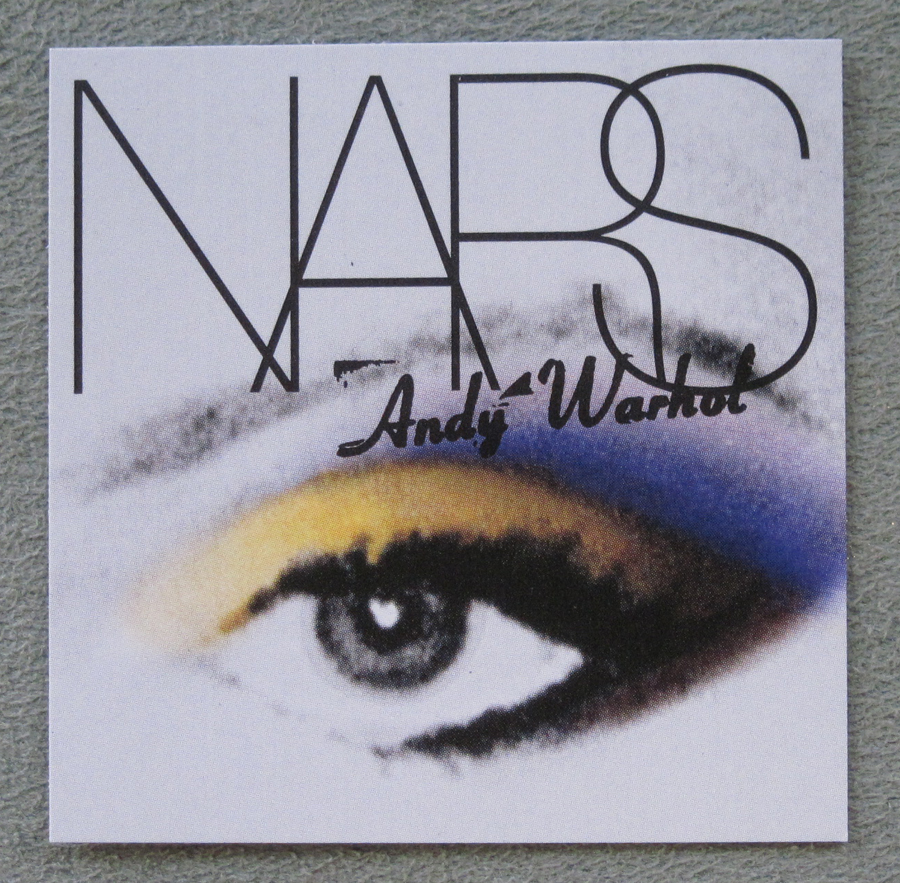
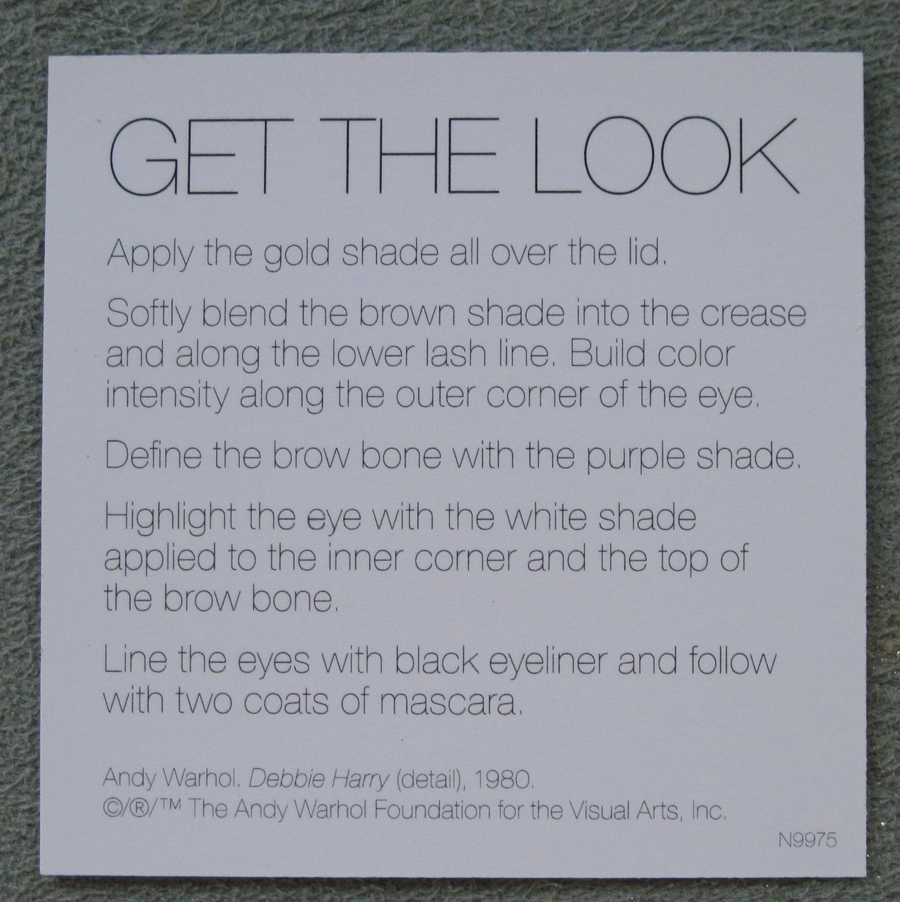
Flower Palette No. 2:
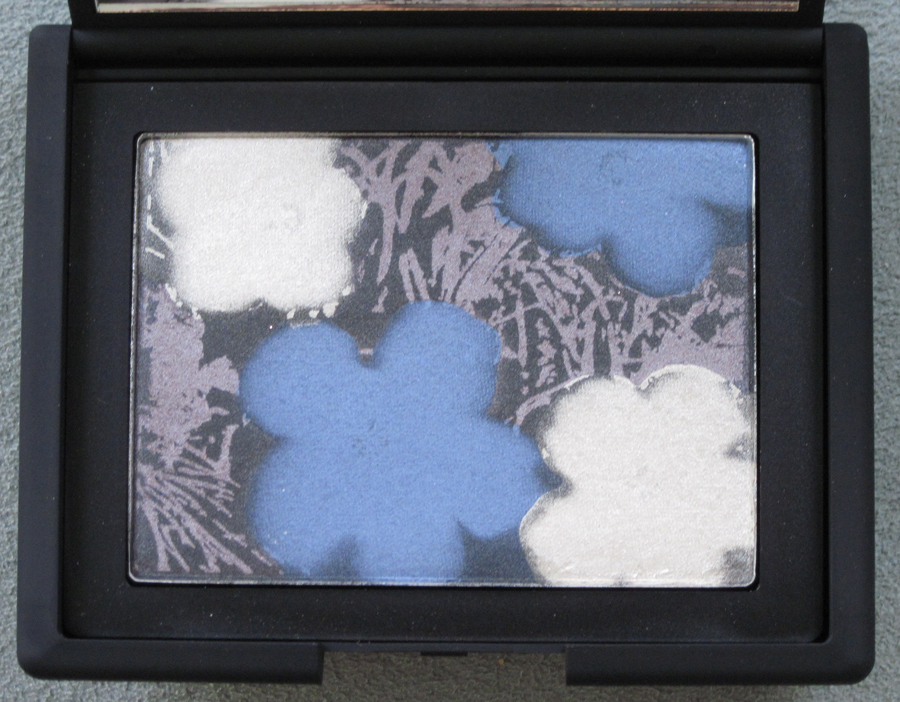
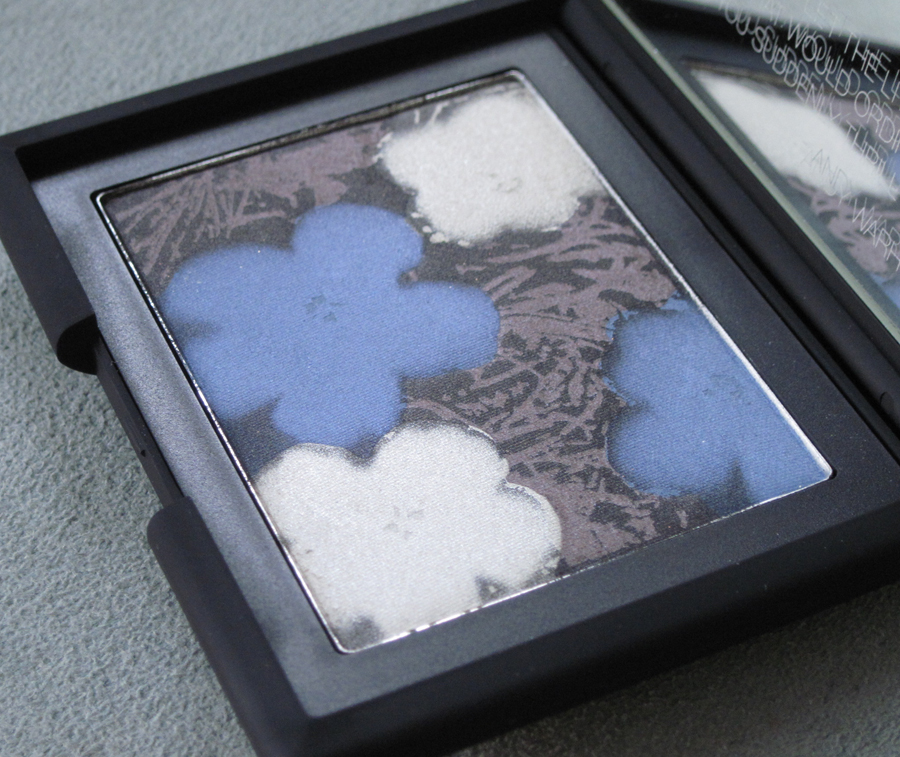
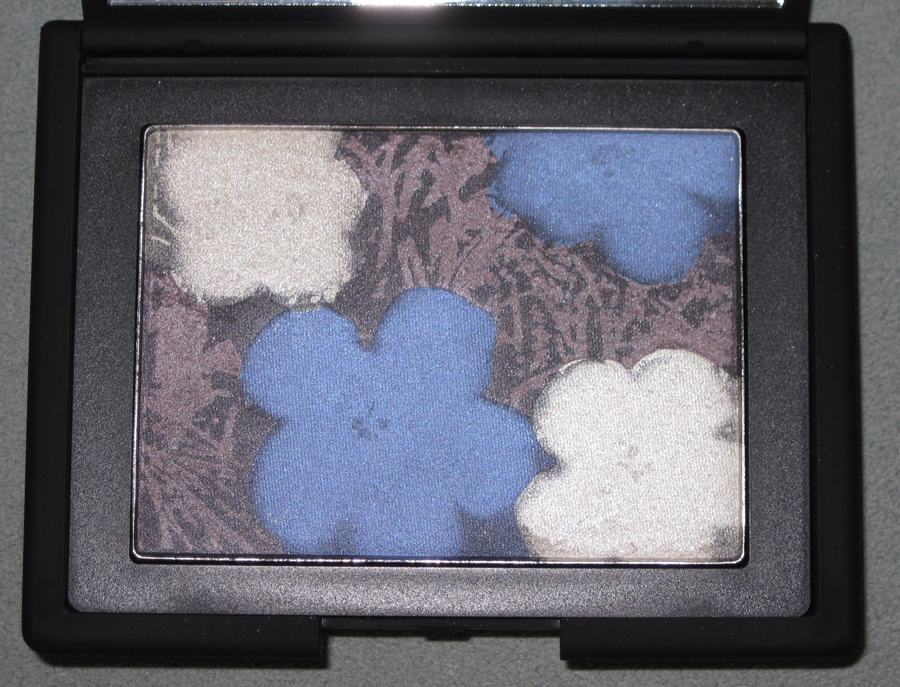
Quote: “You need to let the little things that would ordinarily bore you suddenly thrill you.”
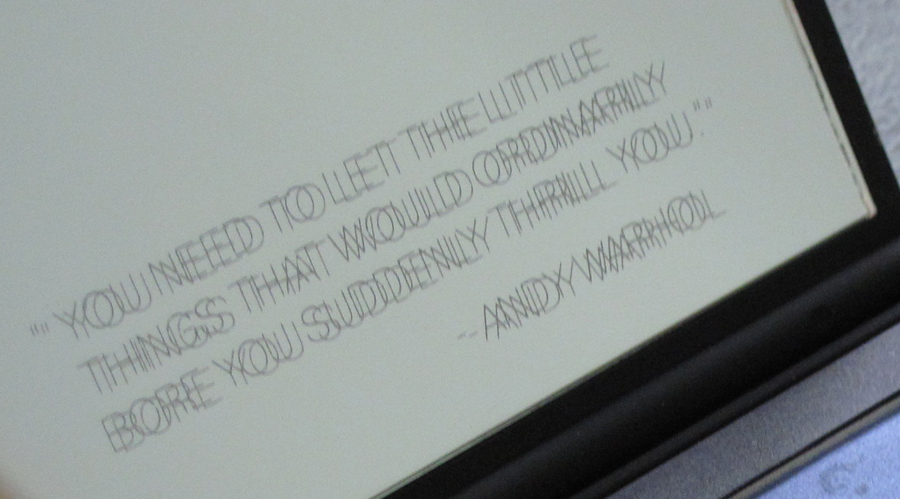
Get the Look card:
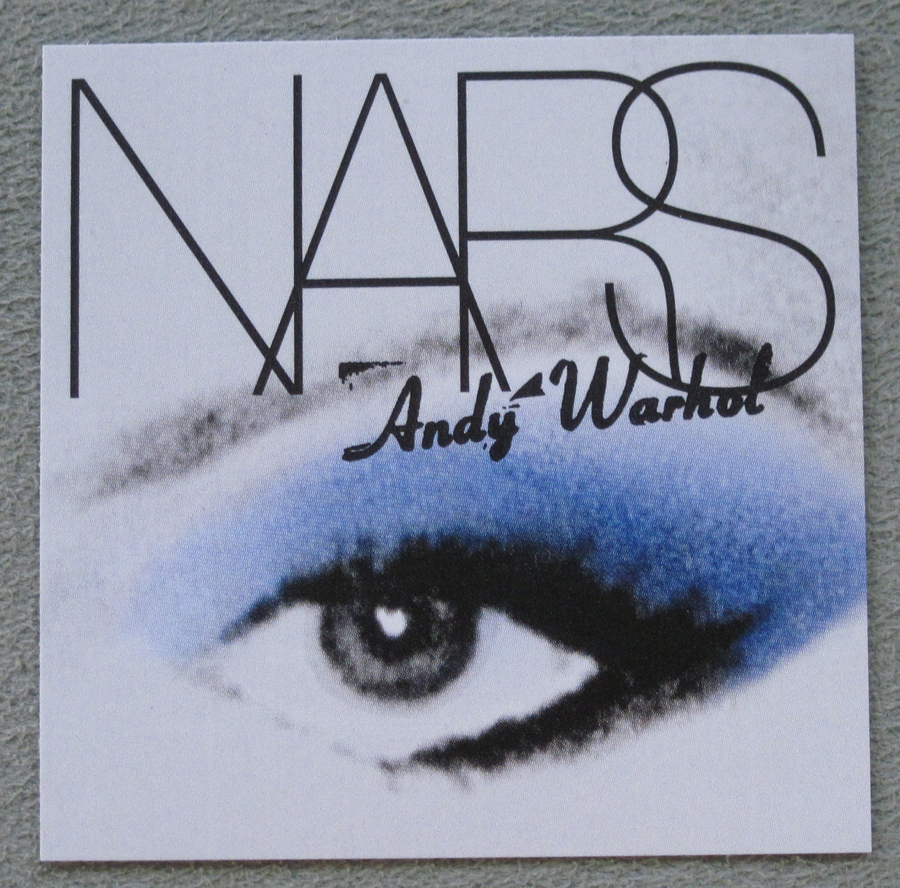
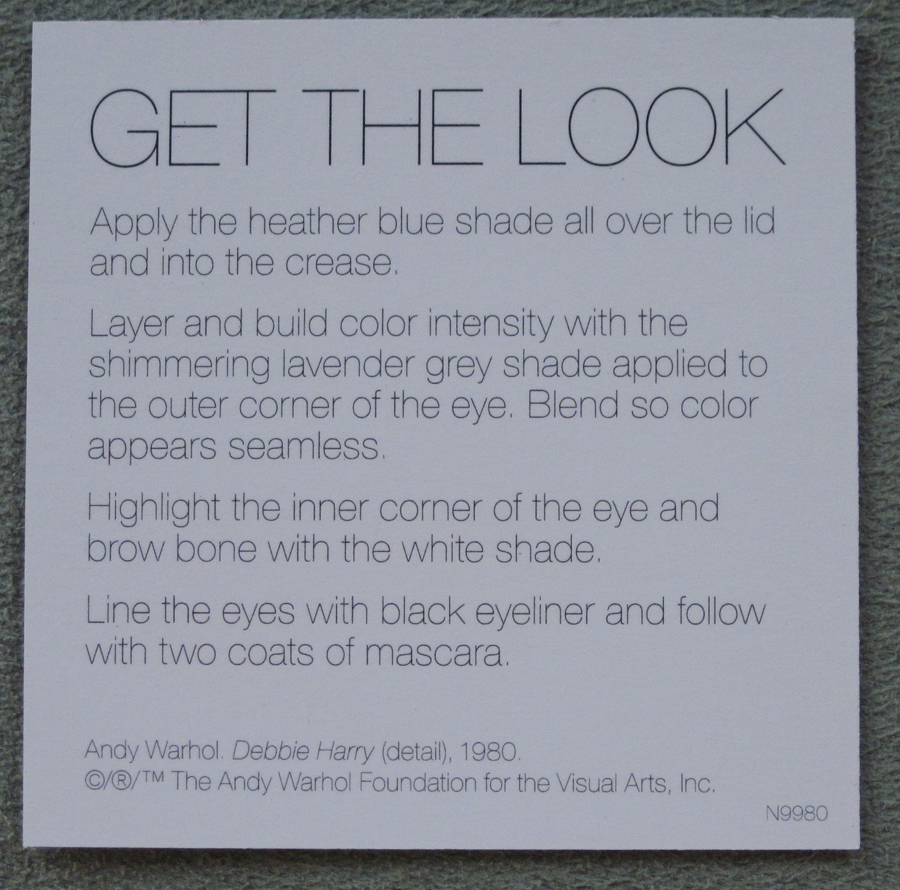
Flower Palette No. 3:
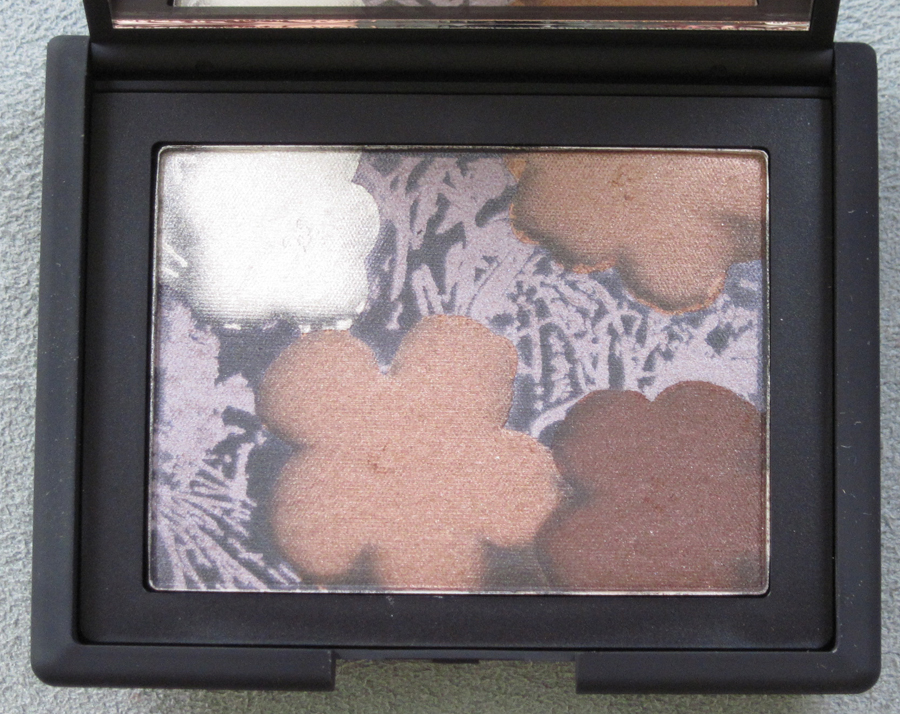
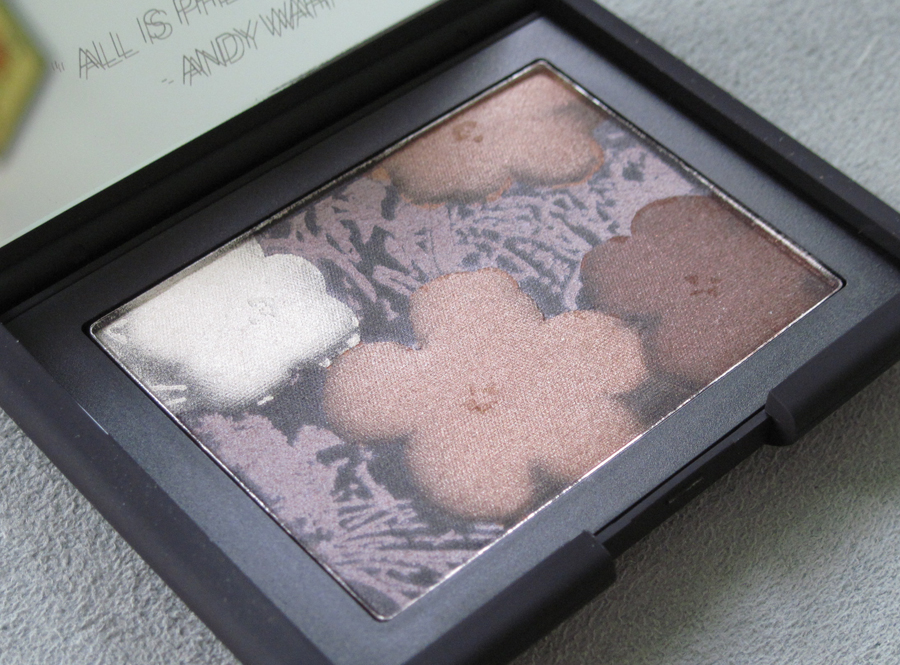
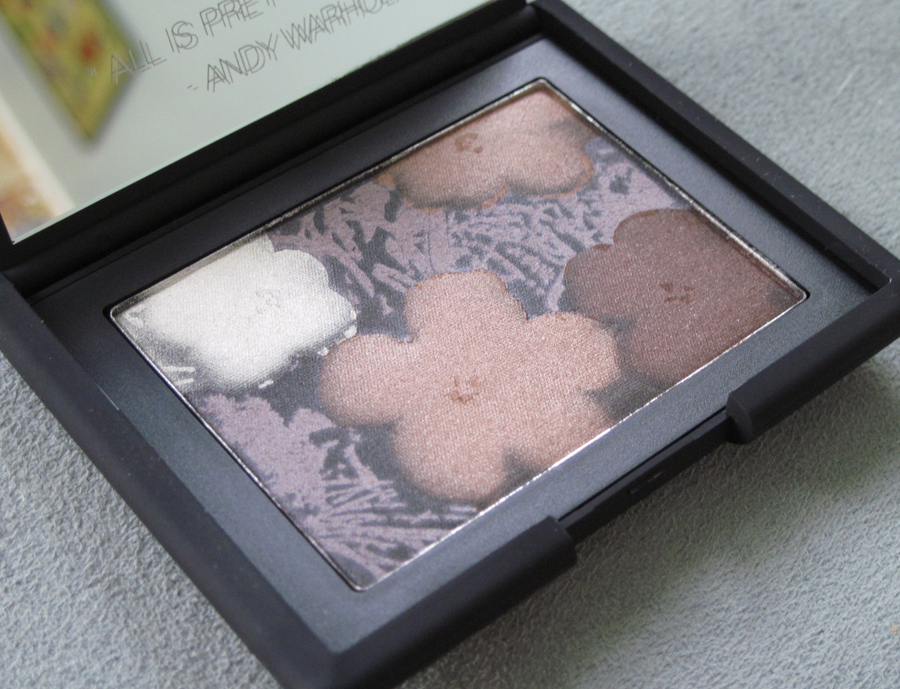
With flash:
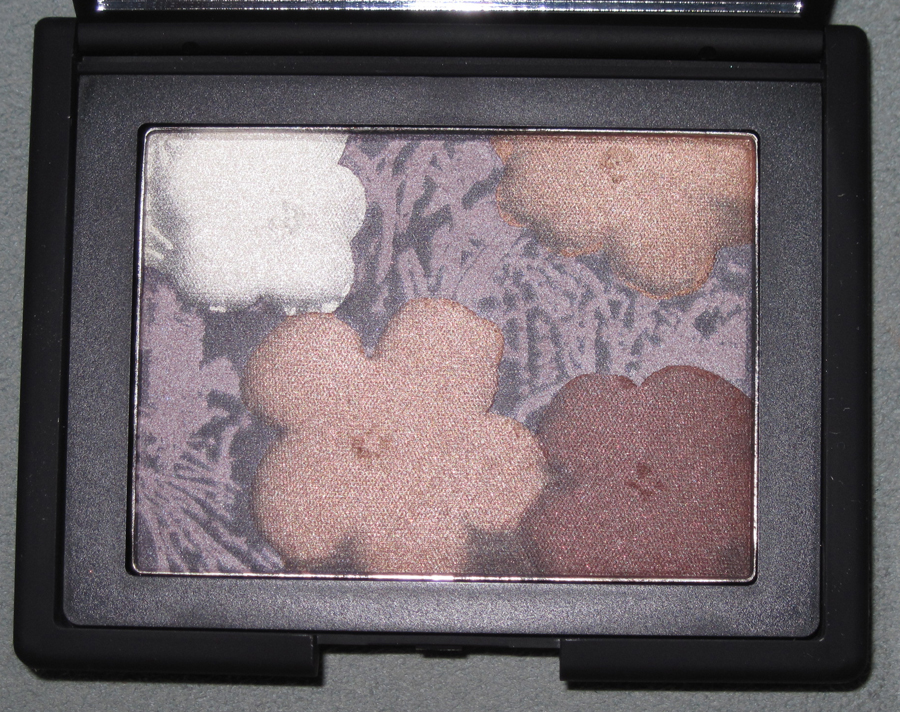
Get the Look card:
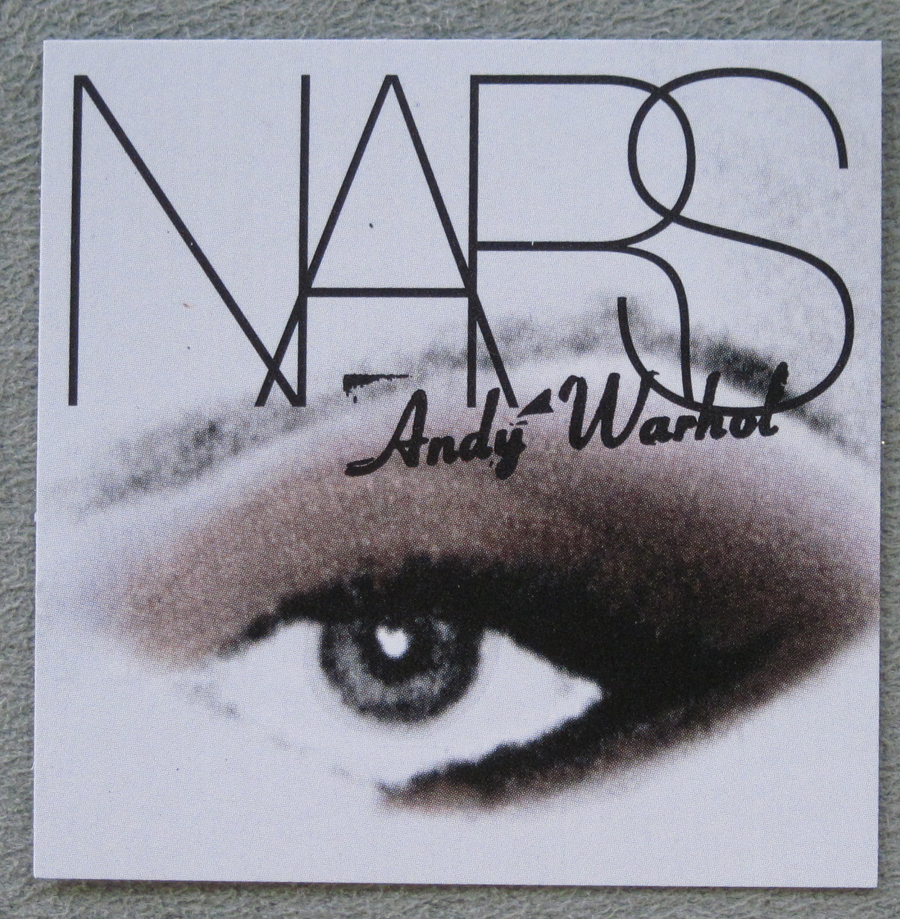
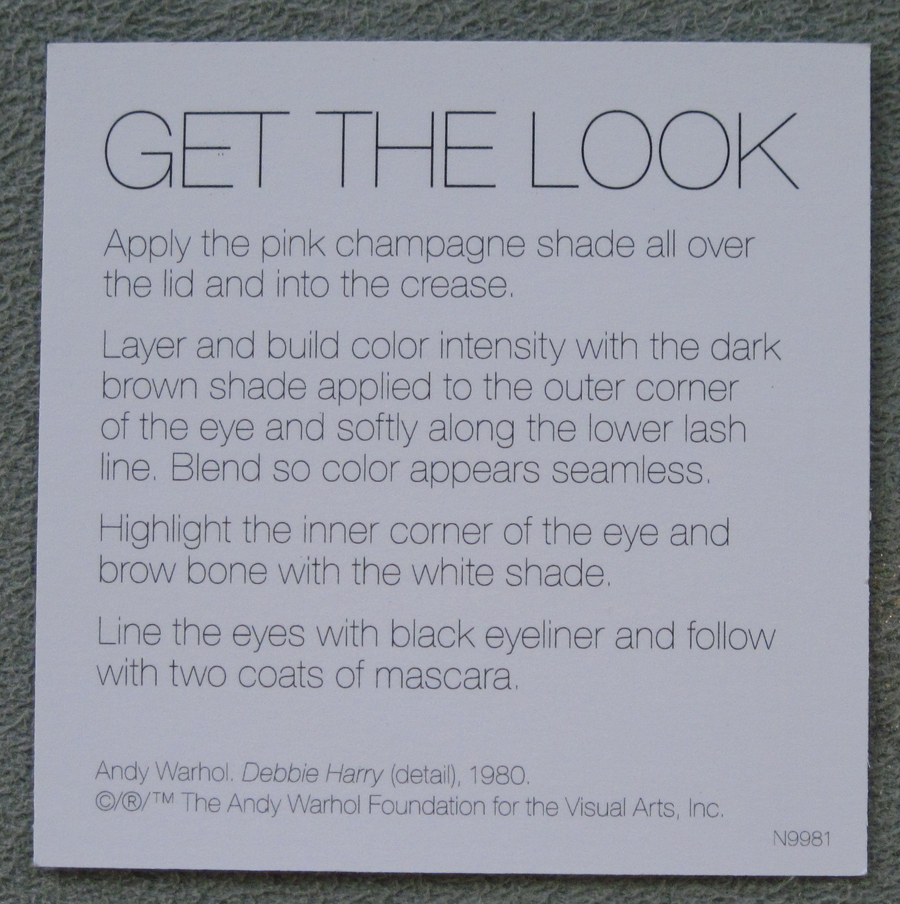
All three palettes also came with this adorable booklet, which was also quite informative.
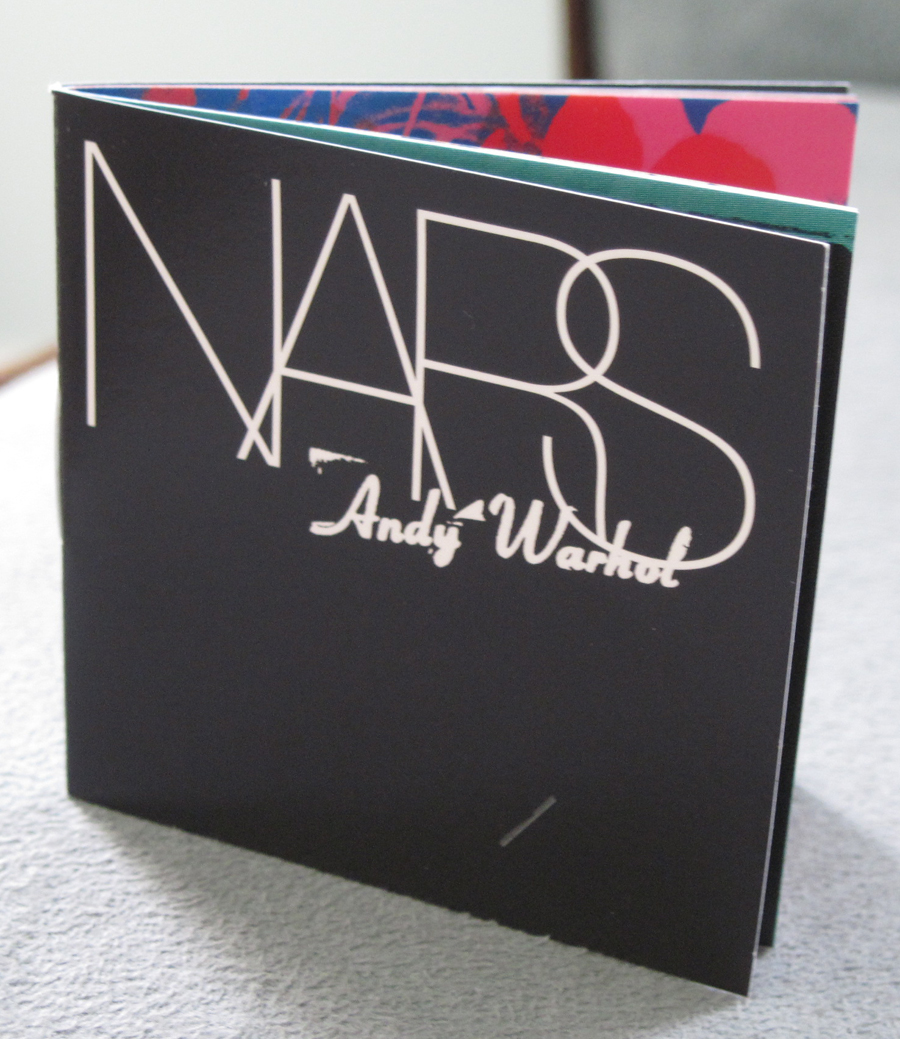
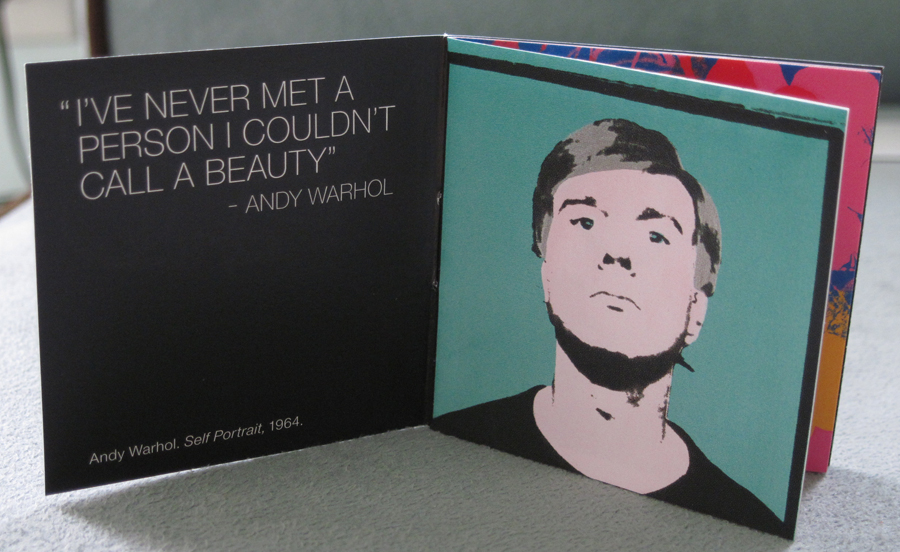
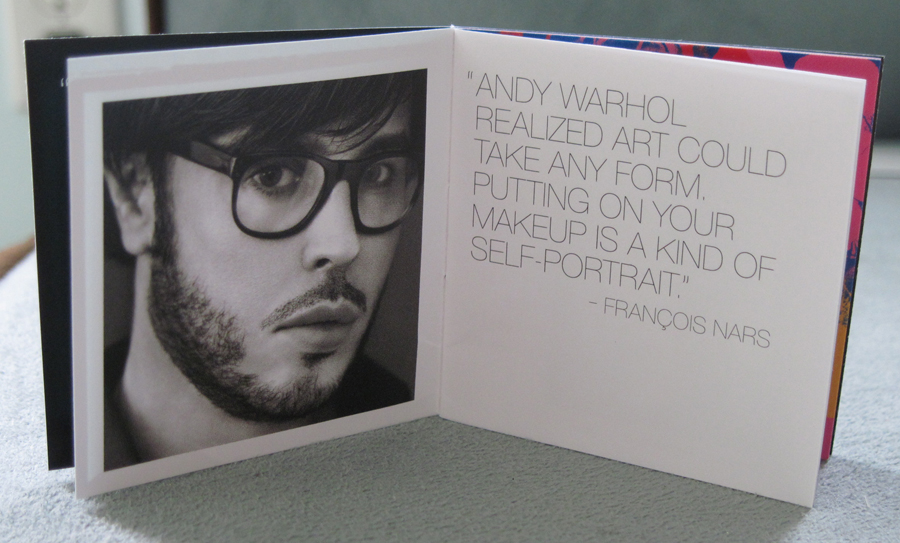
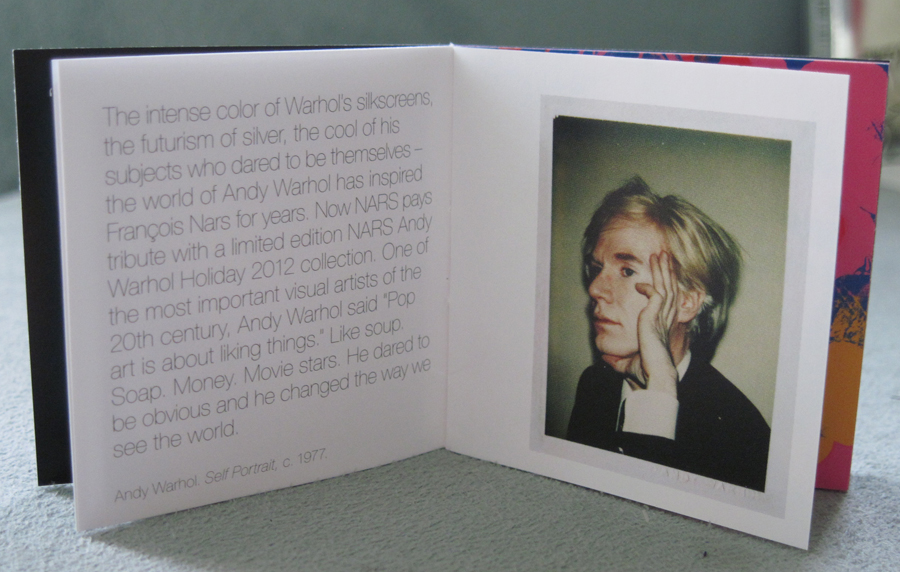
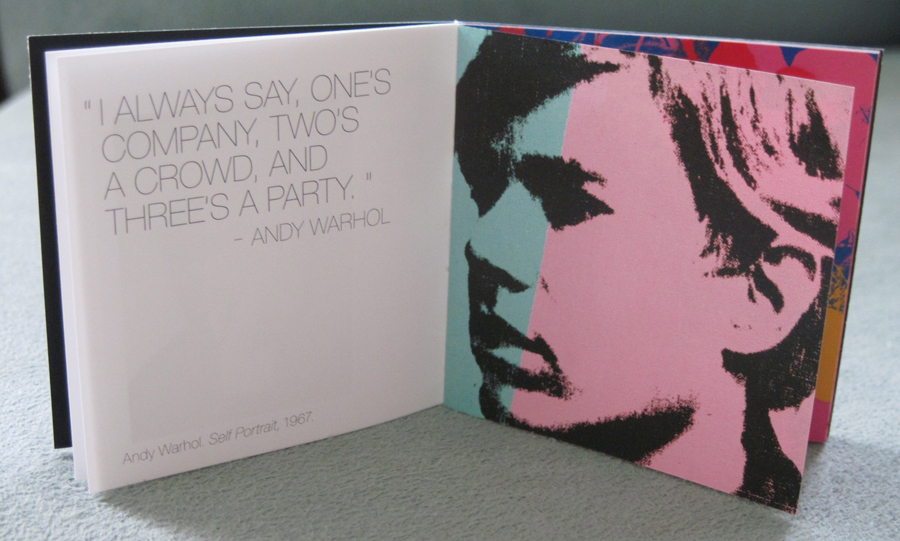
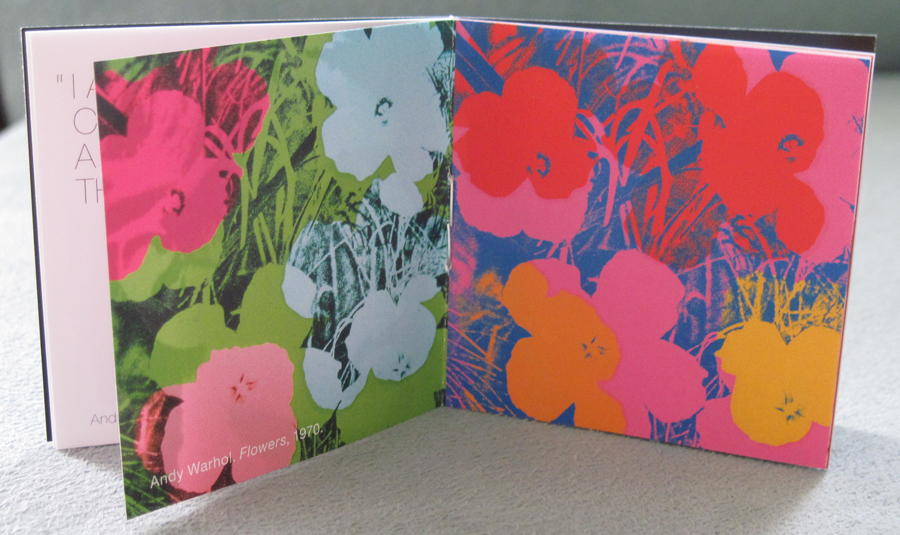
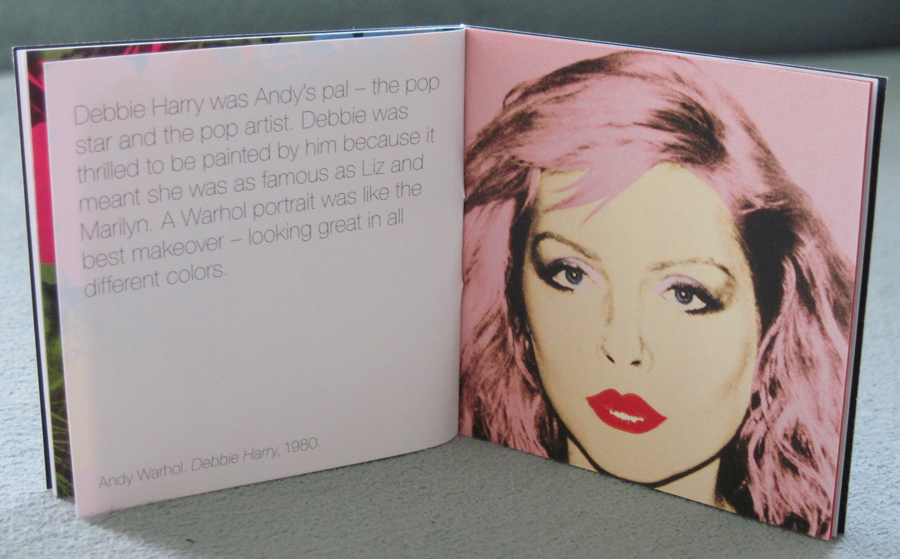
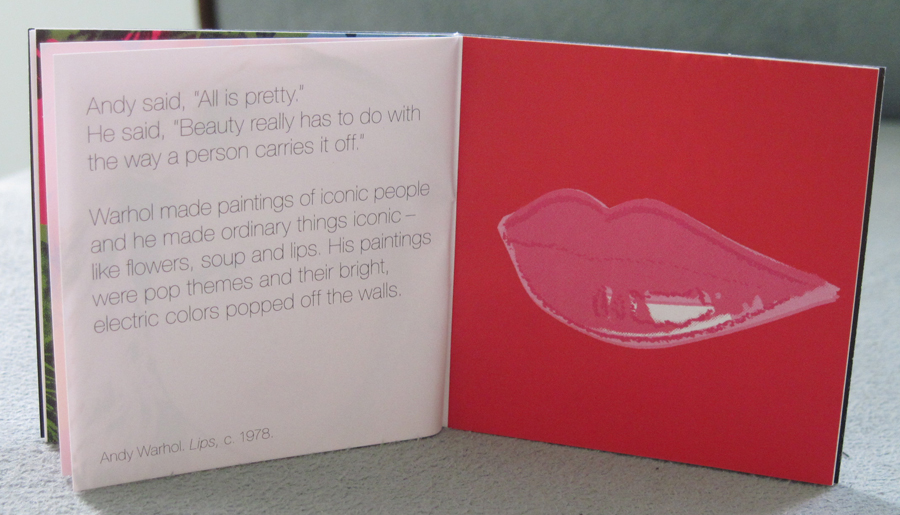
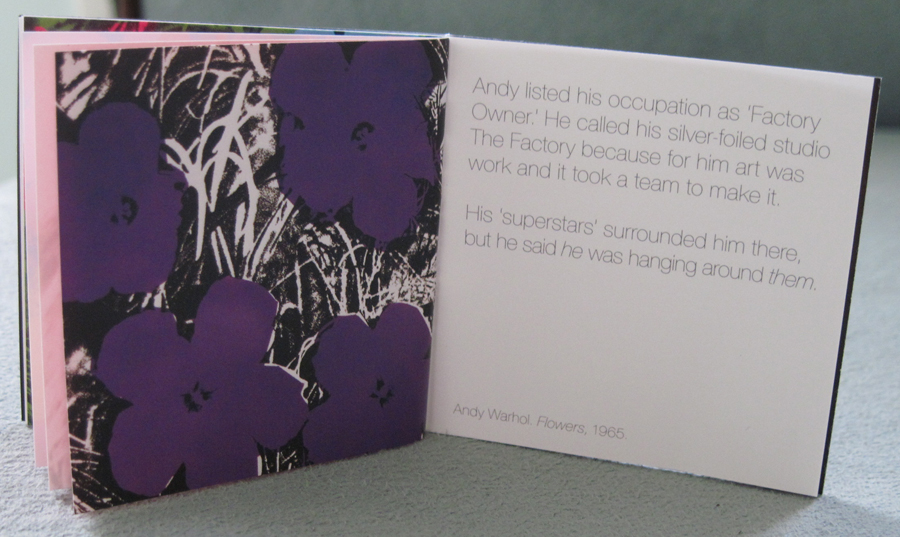
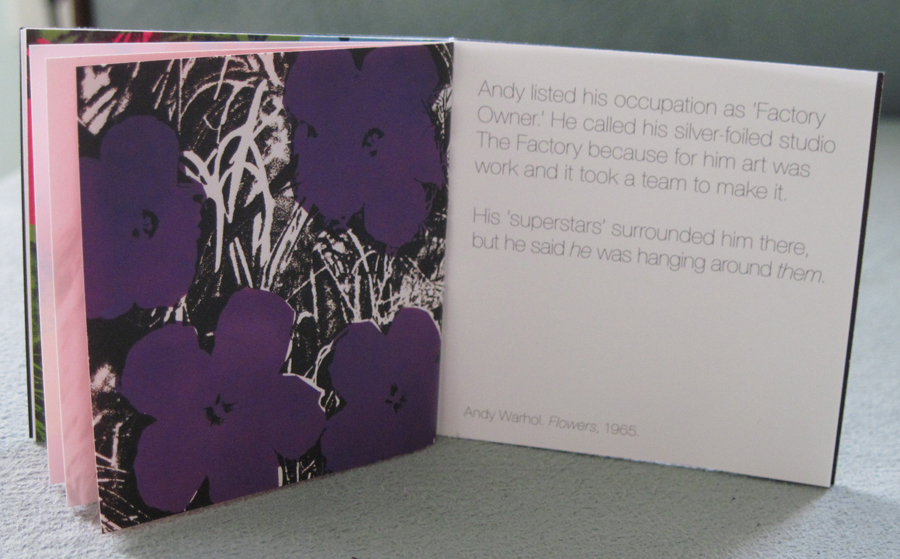
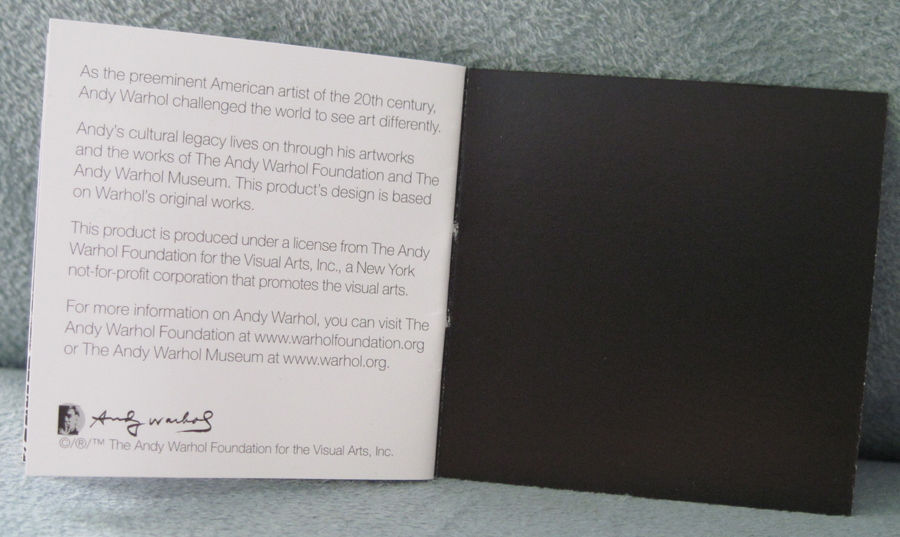
Another item I picked up from the Pop collection was the Kiss Gift Set, a set of five lip glosses housed in a collectible soup can printed with Warhol’s Lips. Each has a Warhol-related name: Silver Factory, Drella, Chelsea Girls, Blue Movie and Myths.
Unfortunately I wasn’t able to find much written about these particular Lips. Everything was either about Marilyn Monroe’s Lips (1962) or Stamped Lips (1959).
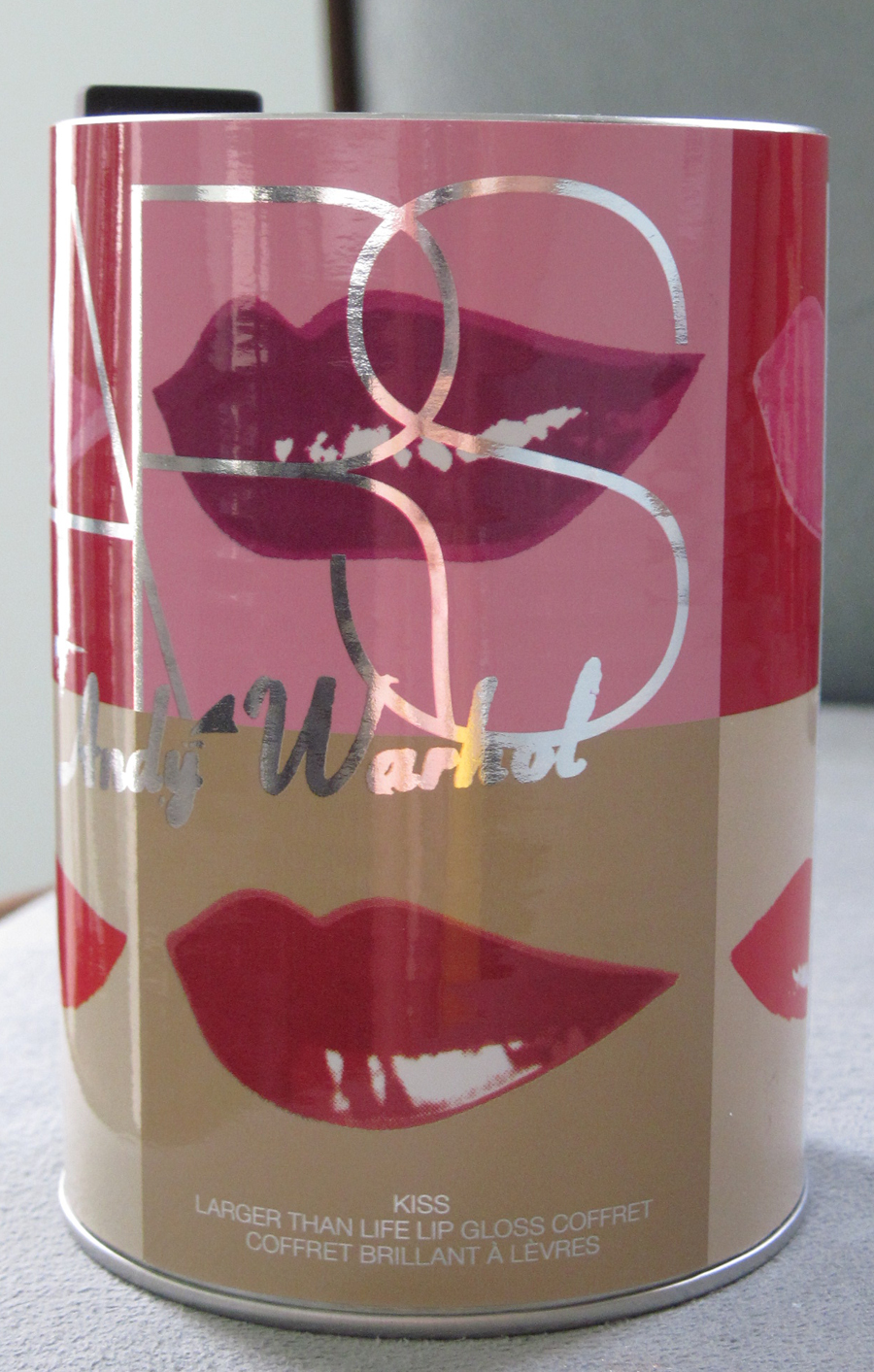
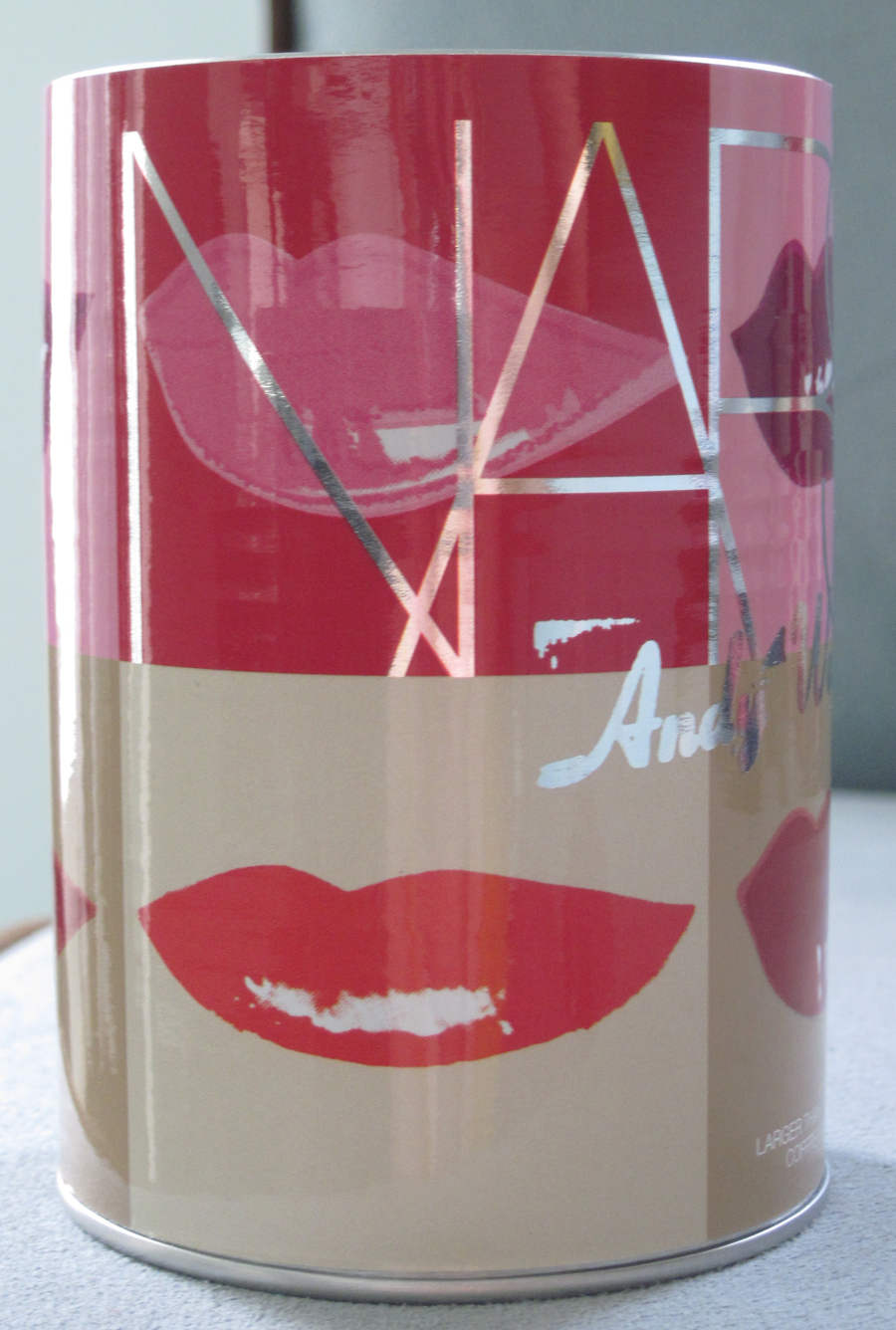
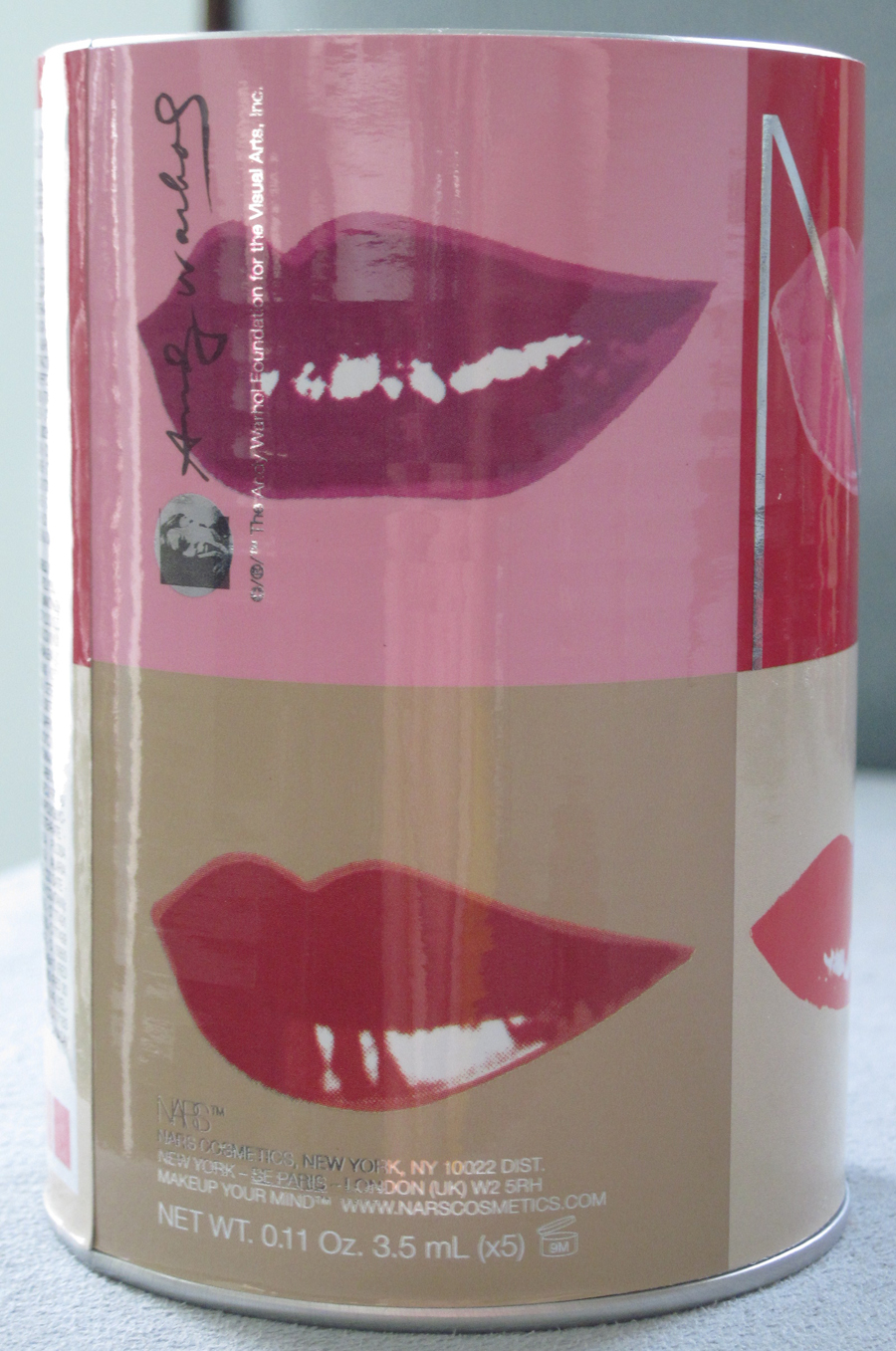
Within the can there was this nifty foam holder for the glosses so that they didn’t slide all over the place.
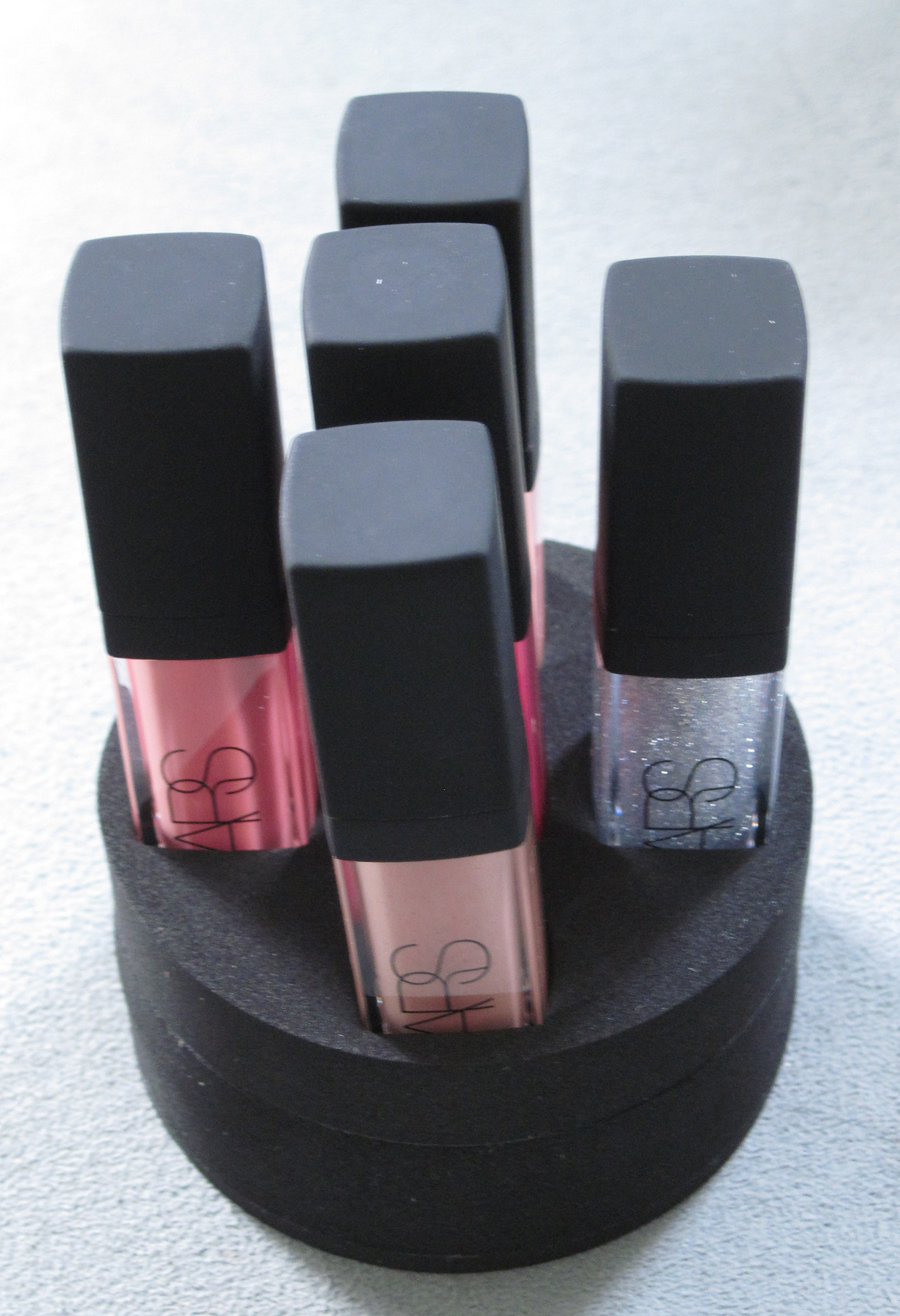
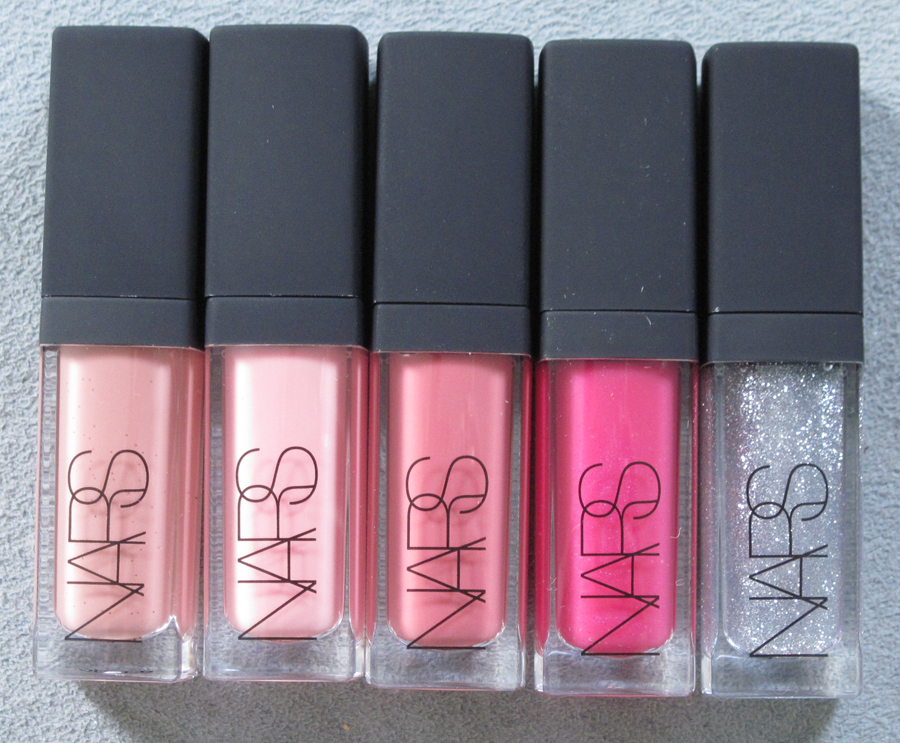
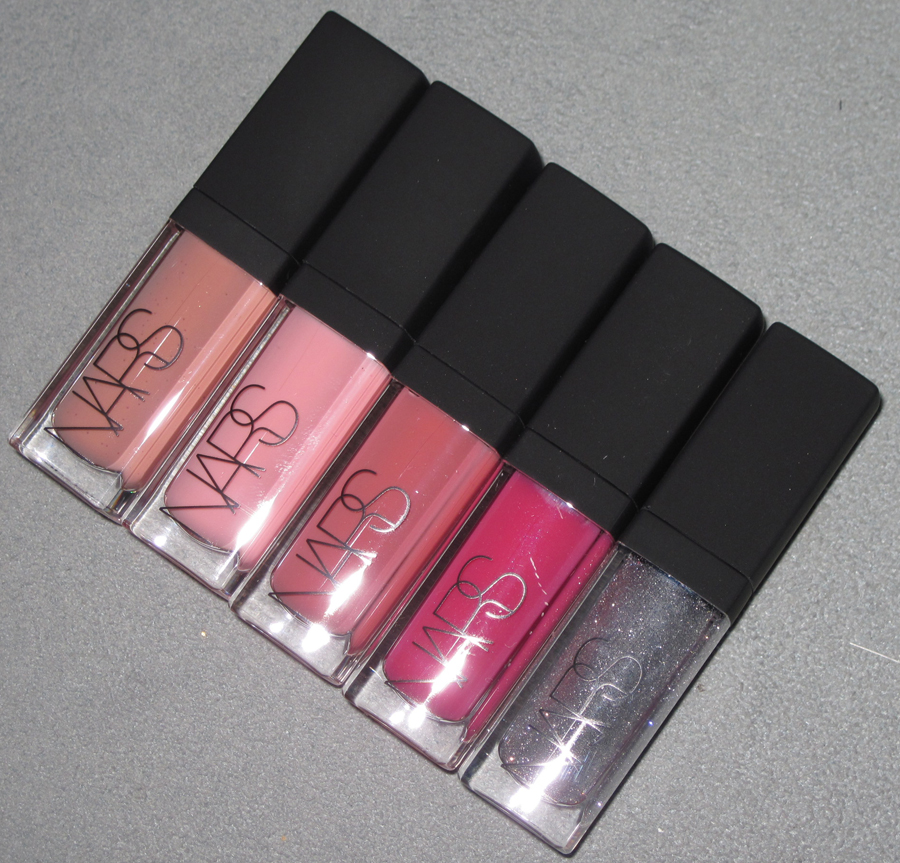
This collection is truly huge – there’s also this Walk on the Wild Side gift set featuring the aforementioned Flowers:
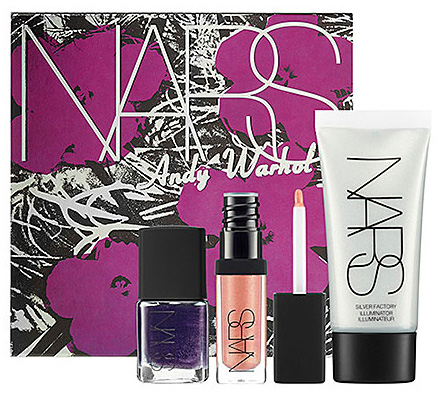
And this Debbie Harry Eye and Cheek Palette. “Inspired by Warhol’s use of ‘Diamond Dust,’ the palette’s colors sparkle with glitter and Diamond Powder, made of real micronized diamonds.”
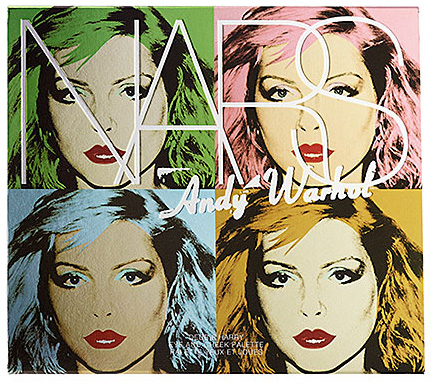
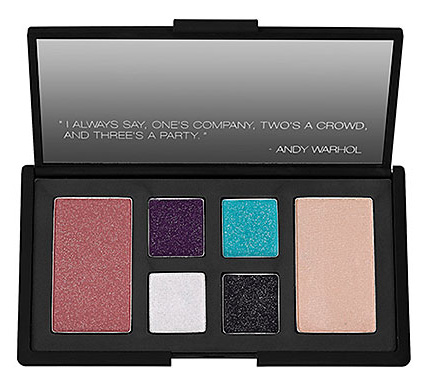
(images from sephora.com)
Debbie Harry became friends with Warhol in the late 70s as her band Blondie was taking off. In 1980, Warhol invited Harry to sit for a portrait. He took hundreds of Polaroids and chose the one he liked most to silkscreen.
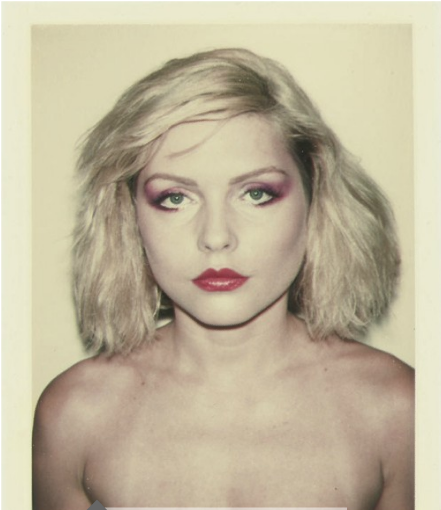
(image from christies.com)
Here is the pink version of the finished silkscreen, which realized $5,981,095 at a recent Sotheby’s auction.
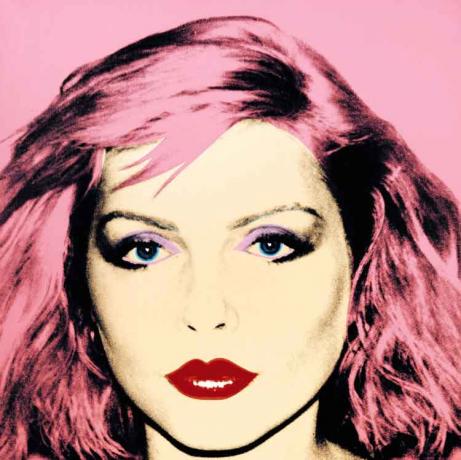
(image from artinfo.com)
The description from the Sotheby’s catalogue is better than anything I could come up with, so here goes:
“Built up of no fewer than five silk-screened layers of ink over the coloured acrylic ground, this portrait stands head and shoulders above its peers as a masterclass in the genre. Painted at a late high point in Warhol’s career, on the eve of the decade which saw a renewed creative enterprise in his art, Debbie Harry sits squarely in the lineage of great portraiture that links his images of the stellar trinity of Liz Taylor, Marilyn Monroe and Jackie Kennedy in the 1960s with his final fright-wig self portraits in the 1980s. Like the early portraits of female stage stars, Debbie Harry reveals Warhol’s lifelong fascination with celebrity and beauty; like his final self portraits, it exhibits the sheer perfection of Warhol’s flawless silkscreen technique, honed and refined over two decades…With the excellent registration of the silkscreen impression, Warhol juxtaposes Harry’s purple eye shadow, dark mascara, red lips, and distinctly strong bone structure against shocking pink hair and like colour background. The full frame composition, the arresting gaze of the subject and the seductive purse of the lips all lend wonderful plasticity to the work and exacerbate the carnality and sensuality of the subject matter…By 1980 Warhol’s silkscreen technique had been absolutely perfected in the present work there is a wonderful balance between the crisp record of the overall form, together with softer, more subtle areas of screen that shape the shadows around her eyes, cheek and neck. Warhol’s mastery of the technique allows him to explore the various nuances available to him within the silkscreen medium in this particular work. By using high contrast Polaroids, Warhol was able to play with the strong areas of black in the features and the bold swaths of colour in the blown out areas. The heightened photographic detail of Debbie Harry links her to Warhol’s Marilyn paintings where this method was first explored. A duality exists in the artist’s focus on stars and their celebrity as setting them apart, yet by screening and immortalizing their image Warhol seemingly brings them closer to us. Despite how beautiful his women are in life, they all become the more glamorous version of themselves in a Warhol portrait. He repeatedly expressed the utopian idea that everyone is a star, and even with existing stars he was able to catapult them to an elevated level of fame. Deliberately depicted in a flat, planar manner, Debbie Harry becomes akin to a Byzantine Madonna. There is no inquiry into the psychological or emotional depth of the sitter; rather, Warhol has again produced a ‘thing in itself’, an icon of popular culture, unspoiled by the subjective. In the present work, Debbie, like Warhol’s other celebrity women before her, is presented to the viewer as an object to be worshipped. Perhaps intentionally, Warhol chose to only complete four of these 42 by 42 inches silkscreened canvases – perpetuating the enduring allure of the singer and actress. The rarity of the work and the choice of subject matter lend the painting an increasingly mysterious aura that Warhol initially subscribed to his 1960s celebrity images – this work appears to be a metaphorical space for the invisibility of a celebrity’s inner person as opposed to the over-exposed visibility of their public image. Debbie Harry is the ultimate culmination of Warhol’s exploration of our public fascination with female public cultural icons…In this particular canvas, Debbie Harry, a familiar face to the public, has been flattened out by the flashbulb and Warhol has retouched reality by pushing his pictorial facts to an extreme. He does, however, maintain a range of human emotion, and the dialogue between public versus private personality of celebrity is still present. The seductive surface is broken down into bold abstract passages; the unarticulated features are nevertheless seared into our mind’s eye with the force of the contrasting positive/negative of his palette…Debbie Harry truly achieved the iconic symbolic status of popular culture and the present portrait reaffirms both her place and Warhol’s place at the apex of celebrity for eternity.”
In the same year as the Debbie Harry portrait, Warhol completed a series of prints using “diamond dust”, the most notable of images being shoes. He said, “I’m
doing shoes because I’m going back to my roots. In fact, I think maybe I
should do nothing but shoes from now on.” As he was starting out in the 50s, Warhol had worked as a commerical illustrator, making shoe advertisements for the I. Miller Shoe Company and Glamour magazine. Thus, he “recognised high-heels as agents of metamorphosis by which a
quotidian necessity of dress could become a totem of glamour…A deceptively straightforward motif, Warhol’s preoccupation with shoes is, in actuality, ripe with implications. On the most basic level, Warhol recognized the enormous subtext a pair of shoes communicates: their quality, make and style are fundamental financial status markers, just as they are also a basic means of personal expression. Warhol was thus not only fascinated by the power footwear is capable of conveying, but he also identified his own financial stability with his shoe renderings. He once remembered, ‘When I used to do shoe drawings for the magazines, I would get a certain amount for each shoe, so then I would count up my shoes to figure out how much I was going to get. I lived by the number of shoe drawings – when I counted them I knew how much money I had.'” (source)
In 1979, Rupert Smith introduced Warhol to a new material made from diamonds that he thought Warhol could use in his silkscreens. Warhol, with his extensive jewelry collection and his association of gems with movie star glamour and fame, was immediately taken with the idea of using this diamond dust. However, it proved to be too dry and not sparkly enough for Warhol, so Smith ordered pulverized glass from a supply company which yielded larger crystals. I think Warhol would have gotten a kick out of the fact that the micronized diamond particles used in the palette were based on his diamond dust, which was actually made of glass (but obviously, glass would not be suitable for wearing on your eyes or anywhere near your face, for that matter).
Warhol carefully arranged the shoes on white paper, and, as with the portrait of Debbie Harry, took Polaroids and picked one that appealed to him the most. “One of the most strikingly original intentions of this
choreography is that the final edited image dissects the fields of
abstraction and figuration, so that the outlines of the flattened shapes
invite contemplation on the semiotic associations of visual cognition.
The subject of shoes and the objects themselves always held particular
power over Andy Warhol, and this late work, executed when he was in his
early fifties, attempts to capture on grand scale his belief in the
alchemical power of high-heels…clearly these high-heels stand as talismanic trophies of an
alluring existence, and even as stand-in celebrities themselves. Diamond
Dust Shoes is testament to some of the most important of the themes
that lie at the heart of Warhol’s output, and its stark silhouettes,
floating across the limitless depths of reflective powder, strike an
unforgettable and mesmerising work of art.” (source) Additionally, Gagosian Gallery held an exhibition in 1999 devoted to Diamond Dust Shoes. Warhol’s friend Vincent Freemont later remarked, “The merger of women’s shoes and diamond dust was a perfect fit… Andy created the Diamond Dust Shoe paintings just as the
disco, lamé, and stilettos of Studio 54 had captured the imagination of
the Manhattan glitterati. Andy, who had been in the vanguard of the New
York club scene since the early 60’s, once again reflected the times he
was living in through his paintings.”
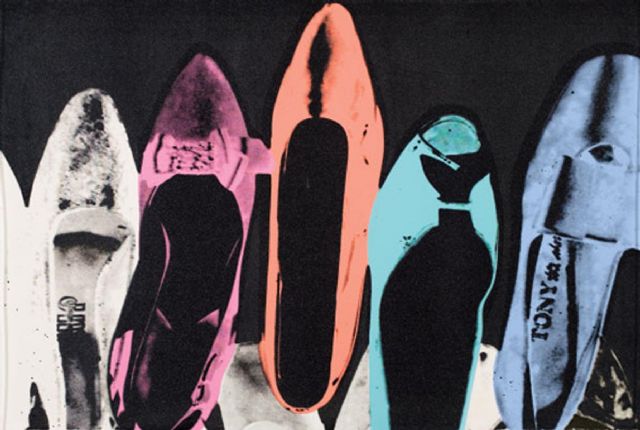
(image from artnet.com)
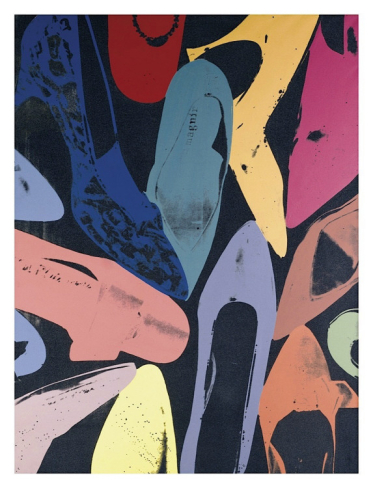
(image from art.com)
So that about does it for this portion of the Andy Warhol collection for NARS (hopefully you made it this far!) What is your favorite piece from the collection and favorite artwork it was based on? While I didn’t buy the Debbie Harry palette, I am in love with the idea of diamond dust and how Warhol applied it to images of shoes. But my favorite pieces from this part of the NARS collection, overall, are the flower palettes.
Robert Motherwell, At Five in the Afternoon, 1949
NARS Pandora eye shadow duo
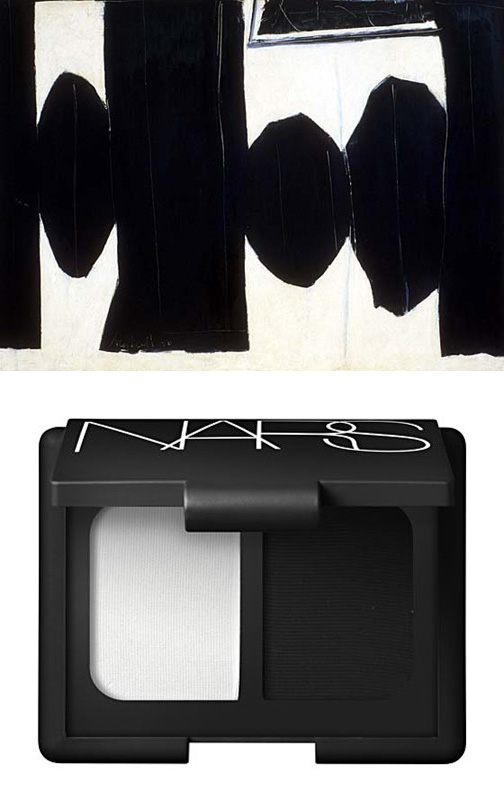
Art Info posted a picture of these lovely Warhol-inspired shadows by NARS. Can't wait to see the rest of the collection!
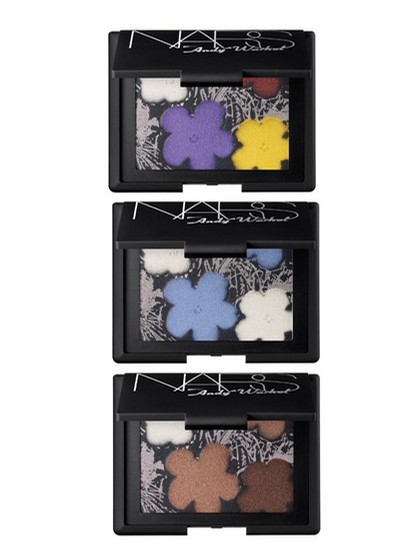
(image from artinfo.com)
How is this collection looking to you so far? Are you as excited as I am?
First Bobbi Brown with the Party shimmerbrick, now NARS has entered the limited-edition design fray. I must say it's about time! I always wanted to know what a palette with a unique design on it would look like coming from Monsieur Nars, and he didn't disappoint.
The Hanamichi (Japanese for "flower path", the theater walkway that connects the main stage with the audience) palette is part of a special holiday collection called Modern Kabuki. "I am completely fascinated by Kabuki theatre; the makeup and costumes are especially beautiful. My attraction to this art form led to the creation of this collection," Nars is quoted as saying at the website. The palette is meant to be a modern take on traditional Kabuki colors – white, red, black and gold.
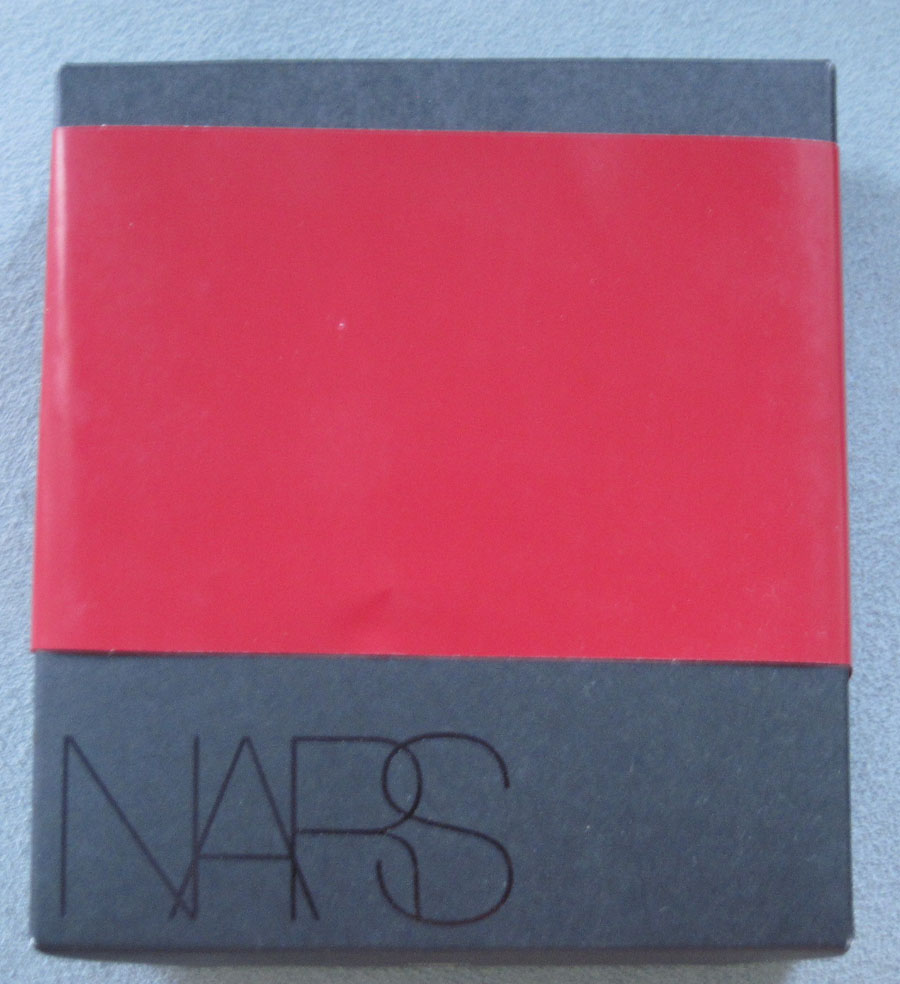
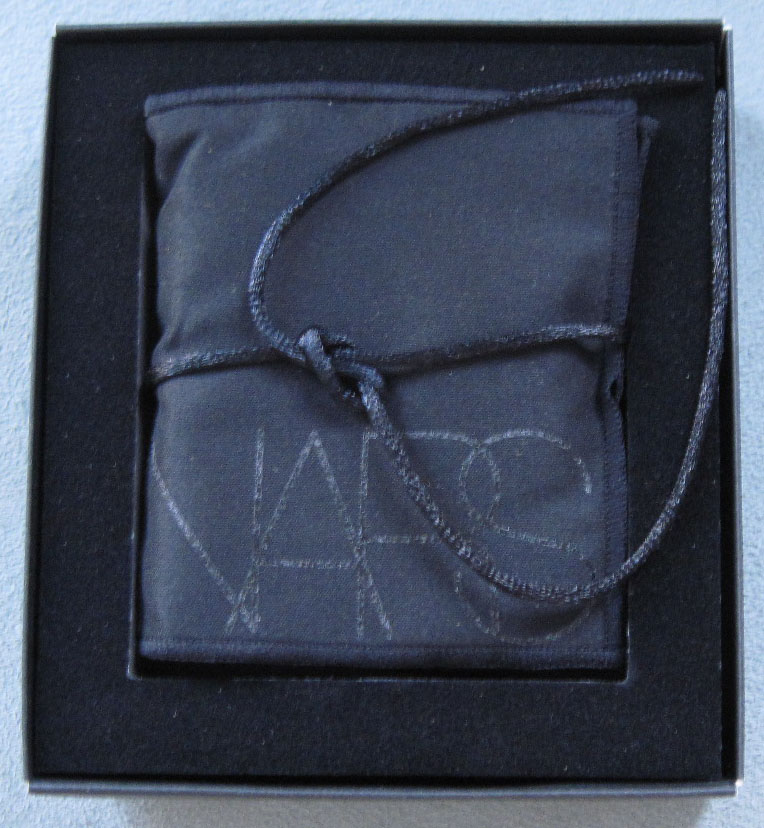
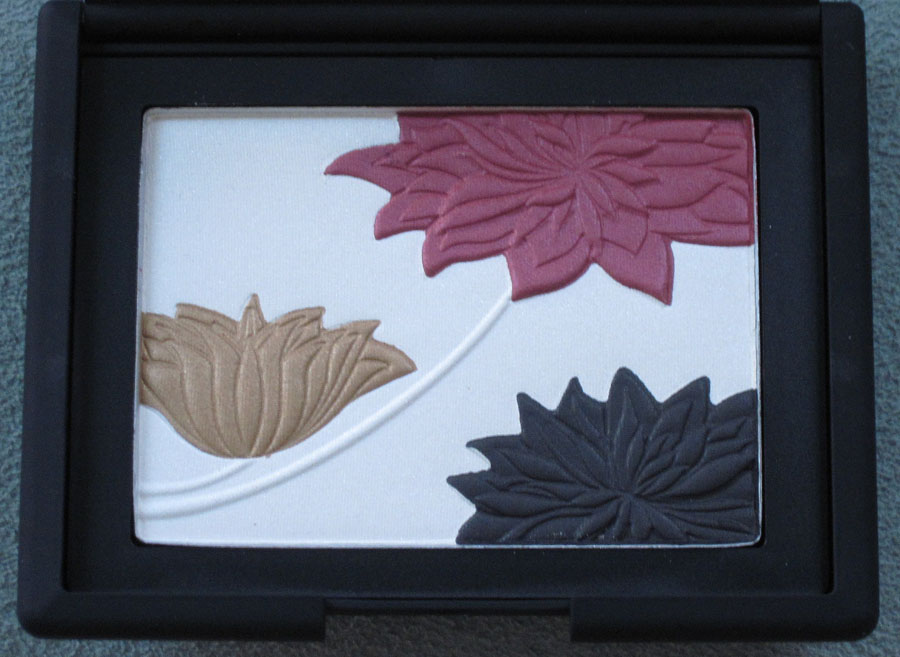
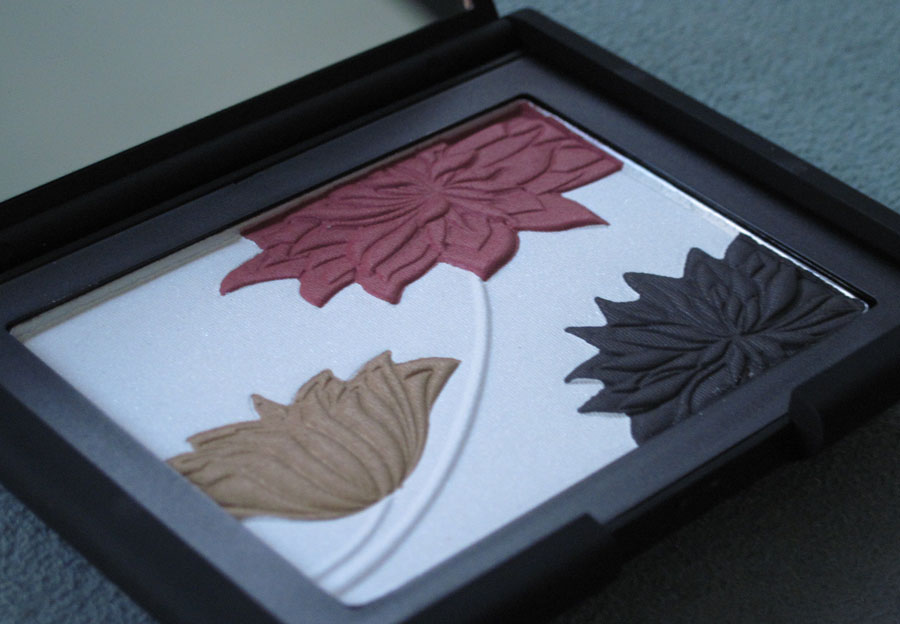
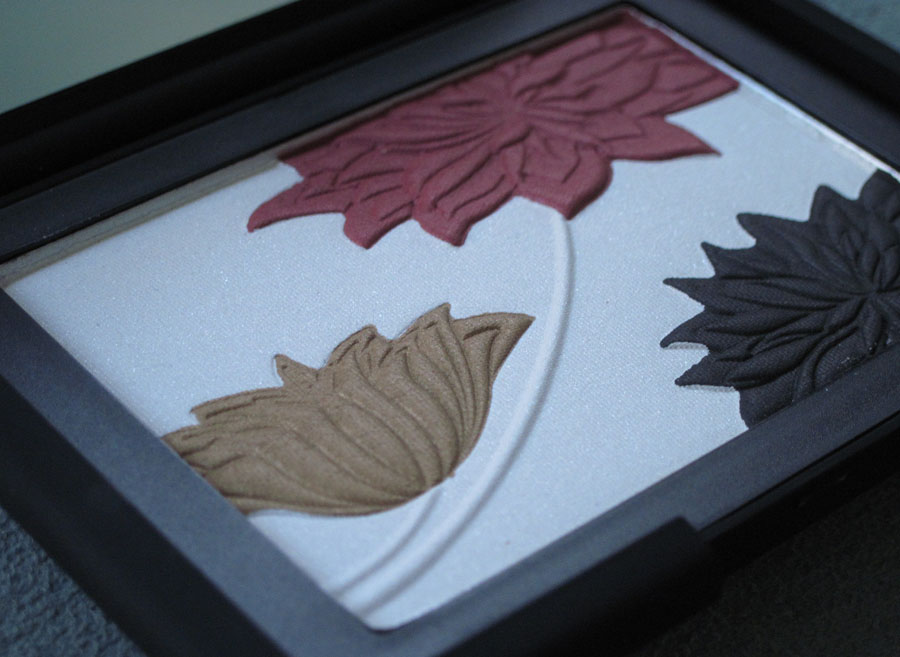
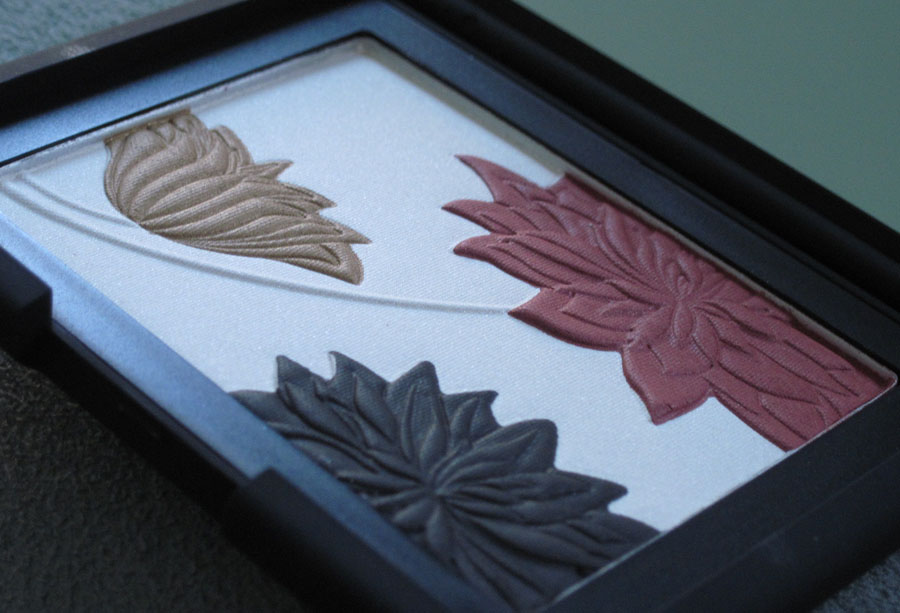
With flash:
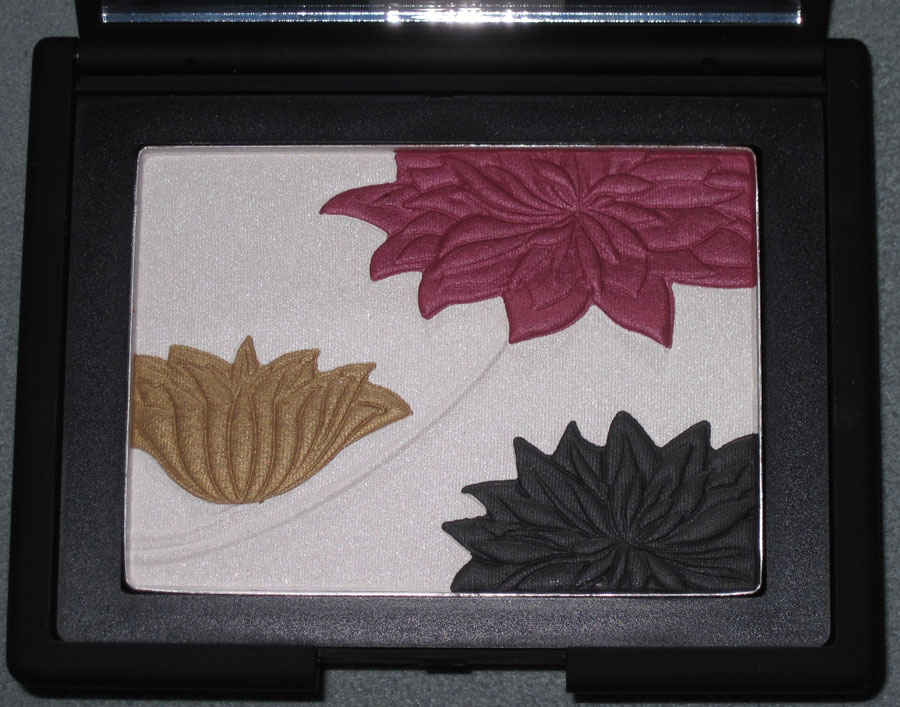
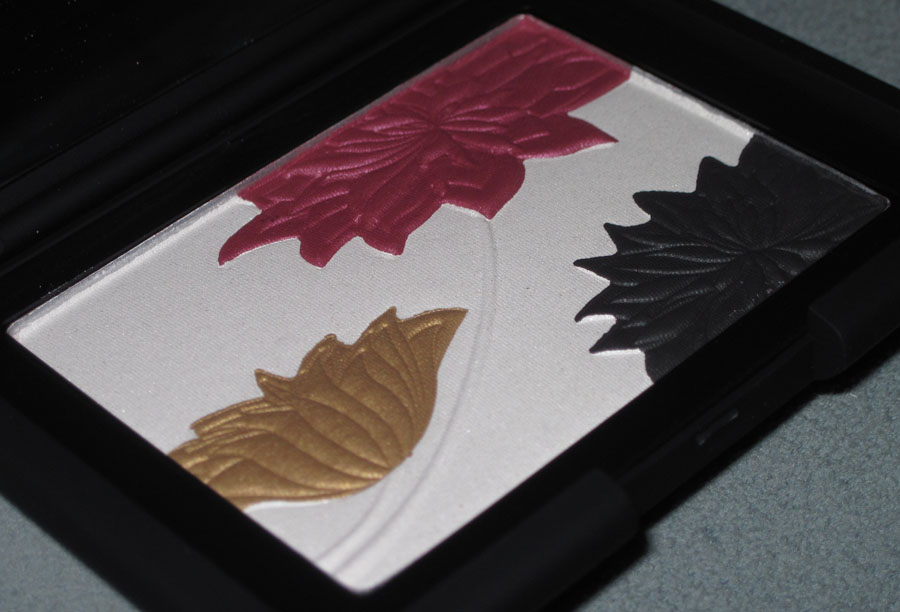
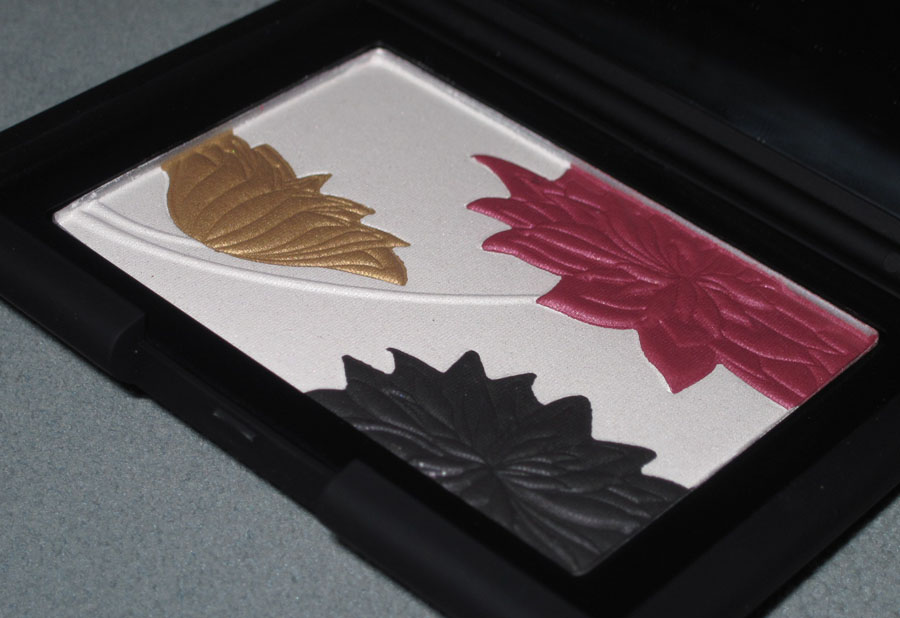
I think these might be lotus flowers but I'm not sure. In any case, this was a very inspired palette and I do hope Francois comes out with more beautifully designed makeup!


 (image from basisdesign.com)
(image from basisdesign.com)






































































































